OSHA Final Rule: Hazard Communication Standard
OSHA is amending the Hazard Communication Standard (HCS) to conform to the United Nations' Globally Harmonized System of Classification and Labelling of Chemicals (GHS), primarily Revision 7 (Rev. 7), address issues that arose during the implementation of the 2012 update to the HCS, and provide better alignment with other U.S. agencies and international trading partners, while enhancing the effectiveness of the standard. Consistent with Executive Order 13563 and the Regulatory Flexibility Act, which call for assessment and, where appropriate, modification and improvement of existing rules, OSHA has reviewed the existing HCS. The agency has determined that the revisions in this final rule will enhance the effectiveness of the HCS by ensuring employees are appropriately apprised of the chemical hazards to which they may be exposed, thus reducing the incidence of chemical-related occupational illnesses and injuries. The modifications to the standard include revised criteria for classification of certain health and physical hazards, revised provisions for updating labels, new labeling provisions for small containers, new provisions related to trade secrets, technical amendments related to the contents of safety data sheets (SDSs), and related revisions to definitions of terms used in the standard.
DATES: This final rule is effective July 19, 2024, published in the Federal Register May 20, 2024, page 44144.
View final rule.
| §1910.6 Incorporation by reference. | ||
| Entire section | Revised | View text |
| §1910.1200 Hazard communication. | ||
| (a)(1) and (b)(6)(x) | Revised | View text |
| (c) | Revised | View text |
| d)(1), (e)(4), (f)(1), (5), and (11) | Revised | View text |
| (f)(12) | View text | |
| (g)(1) and (2), (7) and (10), (i)(1) through (3), and (j) | Revised | View text |
| appendices A through D | Revised | View text |
New Text
§1910.6 Incorporation by reference.
(a)(1) Certain material is incorporated by reference into this part with the approval of the Director of the Federal Register in accordance with 5 U.S.C. 552(a) and 1 CFR part 51. To enforce any edition other than that specified in this section, the Occupational Safety and Health Administration (OSHA) must publish a document in the Federal Register and the material must be available to the public.
(i) The standards of agencies of the U.S. Government, and organizations which are not agencies of the U.S. Government which are incorporated by reference in this part, have the same force and effect as other standards in this part. Only the mandatory provisions (i.e., provisions containing the word “shall” or other mandatory language) of standards incorporated by reference are adopted as standards under the Occupational Safety and Health Act.
(ii) Any changes in the standards incorporated by reference in this part and an official historic file of such changes are available for inspection in the Docket Office at the national office of OSHA, U.S. Department of Labor, Washington, DC 20210; telephone: 202-693-2350 (TTY number: 877-889-5627).
(2) All approved incorporation by reference (IBR) material is available for inspection at OSHA and at the National Archives and Records Administration (NARA).
(i) Contact OSHA at any Regional Office of the Occupational Safety and Health Administration (OSHA), or at the OSHA Docket Office, U.S. Department of Labor, 200 Constitution Avenue NW, Room N-3508, Washington, DC 20210; telephone: 202-693-2350 (TTY number: 877-889-5627).
(ii) For information on the availability of these standards at NARA, visit www.archives.gov/federal-register/cfr/ibr-locations or email fr.inspection@nara.gov.
(3) The IBR material may be obtained from the sources in the following paragraphs of this section or from one or more private resellers listed in this paragraph (a)(3). For material that is no longer commercially available, contact OSHA (see paragraph (a)(2)(i) of this section).
(i) Accuris Standards Store, 321 Inverness Drive, South Englewood, CO 80112; phone: (800) 332-6077; website: https://store.accuristech.com.
(ii) American National Standards Institute (see paragraph (e) for contact information).
(iii) GlobalSpec, 257 Fuller Road, Suite NFE 1100, Albany, NY 12203-3621; phone: (800) 261-2052; website: https://standards.globalspec.com.
(iv) Nimonik Document Center, 401 Roland Way, Suite 224, Oakland, CA 94624; phone (650)591-7600; email: info@document-center.com; website: www.document-center.com.
(v) Techstreet, phone: (855) 999-9870; email: store@techstreet.com; website: www.techstreet.com.
(b) The following material is available for purchase from the American Conference of Governmental Industrial Hygienists (ACGIH), 1014 Broadway, Cincinnati OH 45202:
(1) ‘‘Industrial Ventilation: A Manual of Recommended Practice’’ (22nd ed., 1995), incorporation by reference (IBR) approved for §1910.124(b)(4)(iii).
(2) Threshold Limit Values and Biological Exposure Indices for 1986-87 (1986), IBR approved for §1910.120, PEL definition.
(c) The following material is available for purchase from the American Society of Agricultural Engineers (ASAE), 2950 Niles Road, Post Office Box 229, St. Joseph, MI 49085:
(1) ASAE Emblem for Identifying Slow Moving Vehicles, ASAE S276.2 (1968), IBR approved for §1910.145(d)(10).
(2) [Reserved]
(d) The following material is available for purchase from the Agriculture Ammonia Institute-Rubber Manufacturers (AAI-RMA) Association, 1400 K St. NW, Washington DC 20005:
(1) AAI-RMA Specifications for Anhydrous Ammonia Hose, IBR approved for §1910.111(b)(8)(i).
(2) [Reserved]
(e) American National Standards Institute (ANSI), 25 West 43rd Street, Fourth Floor, New York, NY 10036-7417; phone: (212) 642-4980; email: info@ansi.org; website: www.ansi.org.
(1) [Reserved]
(2) [Reserved]
(3) ANSI A11.1-65 (R 70) Practice for Industrial Lighting, IBR approved for §§ 1910.219(c)(5)(iii); 1910.261 (a)(3)(i), (c)(10), and (k)(21); and 1910.265(c)(2).
(4) ANSI A11.1-65 Practice for Industrial Lighting, IBR approved for 1910.262(c)(6) and 1910.265(d)(2)(i)(a).
(5) [Reserved]
(6) ANSI A13.1-56 Scheme for the Identification of Piping Systems, IBR approved for §§ 1910.253(d)(4)(ii); 1910.261(a)(3)(iii); 1910.262(c)(7).
(7) ANSI A14.1-68 Safety Code for Portable Wood Ladders, Supplemented by ANSI A14.1a-77, IBR approved for §1910.261 (a)(3)(iv) and (c)(3)(i).
(8) ANSI A14.2-56 Safety Code for Portable Metal Ladders, Supplemented by ANSI A14.2a-77, IBR approved for §1910.261 (a)(3)(v) and (c)(3)(i).
(9) ANSI A14.3-56 Safety Code for Fixed Ladders, IBR approved for §§1910.68(b) (4); and 1910.261 (a)(3)(vi) and (c)(3)(i).
(10) ANSI A17.1-65 Safety Code for Elevators, Dumbwaiters and Moving Walks, Including Supplements, A17.1a (1967); A17.1b (1968); A17.1c (1969); A17.1d (1970), IBR approved for §1910.261 (a)(3)(vii), (g)(11)(i), and (l)(4).
(11) ANSI A17.2-60 Practice for the Inspection of Elevators, Including Supplements, A17.2a (1965), A17.2b (1967), IBR approved for §1910.261(a)(3)(viii).
(12) ANSI A90.1-69 Safety Standard for Manlifts, IBR approved for §1910.68(b)(3).
(13) ANSI A92.2-69 Standard for Vehicle Mounted Elevating and Rotating Work Platforms, IBR approved for §1910.67 (b)(1), (2), (c)(3), and (4) and 1910.268(s)(1)(v).
(14) ANSI A120.1-70 Safety Code for Powered Platforms for Exterior Building Maintenance, IBR approved for §1910.66 App. D (b) through (d).
(15) ANSI B7.1–70 Safety Code for the Use, Care and Protection of Abrasive Wheels, IBR approved for §§ 1910.215(b)(12) and 1910.218(j).
(16) ANSI B15.1-53 (R 58) Safety Code for Mechanical Power Transmission Apparatus, IBR approved for §§ 1910.68(b)(4) and 1910.261 (a)(3)(ix), (b)(1), (e)(3), (e)(9), (f)(4), (j)(5)(iv), (k)(12), and (l)(3).
(17) ANSI B20.1-57 Safety Code for Conveyors, Cableways, and Related Equipment, IBR approved for §§ 1910.218(j)(3); 1910.261 (a)(3)(x), (b)(1), (c)(15)(iv), (f)(4), and (j)(2); 1910.265(c)(18)(i).
(18) ANSI B30.2-43 (R 52) Safety Code for Cranes, Derricks, and Hoists, IBR approved for §1910.261 (a)(3)(xi), (c)(2)(vi), and (c)(8) (i) and (iv).
(19) ANSI B30.2.0-67 Safety Code for Overhead and Gantry Cranes, IBR approved for §§ 1910.179(b)(2); 1910.261 (a)(3)(xii), (c)(2)(v), and (c)(8) (i) and (iv).
(20) ANSI B30.5-68 Safety Code for Crawler, Locomotive, and Truck Cranes, IBR approved for §§ 1910.180(b)(2) and 1910.261(a)(3)(xiii).
(21) ANSI B30.6-69 Safety Code for Derricks, IBR approved for §§ 1910.181(b)(2) and 1910.268(j)(4)(iv) (E) and (H).
(22) ANSI B31.1-55 Code for Pressure Piping, IBR approved for §1910.261(g)(18)(iii).
(23) ANSI B31.1-67, IBR approved for §1910.253(d)(1)(i)(A).
(24) ANSI B31.1a-63 Addenda to ANSI B31.1 (1955), IBR approved for §1910.261(g)(18)(iii).
(25) ANSI B31.1-67 and Addenda B31.1 (1969) Code for Pressure Piping, IBR approved for §§ 1910.103(b)(1)(iii)(b); 1910.104(b)(5)(ii); 1910.218 (d)(4) and (e)(1)(iv); and 1910.261 (a)(3)(xiv) and (g)(18)(iii).
(26) ANSI B31.2-68 Fuel Gas Piping, IBR approved for §1910.261(g)(18)(iii).
(27) ANSI B31.3-66 Petroleum Refinery Piping, IBR approved for §1910.103(b)(3)(v) (b).
(28) ANSI B31.5-66 Addenda B31.5a (1968) Refrigeration Piping, IB approved for §§1910.103(b)(3)(v) (b) and 1910.111(b)(7)(iii).
(29) ANSI B56.1-69 Safety Standard for Powered Industrial Trucks, IBR approved for §§1910.178(a) (2) and (3) and 1910.261 (a)(3)(xv), (b)(6), (m)(2), and (m)(5)(iii).
(30) ANSI B57.1-65 Compressed Gas Cylinder Valve Outlet and Inlet Connections, IBR approved for §1910.253(b)(1)(iii).
(31) [Reserved]
(32) ANSI B175.1-1991, Safety Requirements for Gasoline-Powered Chain Saws 1910.266(e)(2)(i).
(33) [Reserved]
(34) ANSI C33.2-56 Safety Standard for Transformer-Type Arc Welding Machines, IBR approved for §1910.254(b)(1).
(35) [Reserved]
(36) ANSI H23.1-70 Seamless Copper Water Tube Specification, IBR approved for §1910.110(b)(8)(ii) and (13)(ii) (b)(1).
(37) ANSI H38.7-69 Specification for Aluminum Alloy Seamless Pipe and Seamless Extruded Tube, IBR approved for §1910.110(b)(8)(i).
(38) ANSI J6.4-71 Standard Specification for Rubber Insulating Blankets, IBR approved for §1910.268 (f)(1) and (n)(11)(v).
(39) ANSI J6.6-71 Standard Specification for Rubber Insulating Gloves, IBR approved for §1910.268 (f)(1) and (n)(11)(iv).
(40) ANSI K13.1-67 Identification of Gas Mask Canisters, IBR approved for §1910.261 (a)(3)(xvi) and (h)(2)(iii).
(41) ANSI K61.1-60 Safety Requirements for the Storage and Handling of Anhydrous Ammonia, IBR approved for §1910.111(b)(11)(i).
(42) ANSI K61.1-66 Safety Requirements for the Storage and Handling of Anhydrous Ammonia, IBR approved for §1910.111(b)(11)(i).
(43) ANSI O1.1-54 (R 61) Safety Code for Woodworking Machinery, IBR approved for §1910.261 (a)(3)(xvii), (e)(7), and (i)(2).
(44) ANSI S1.4-71 (R 76) Specification for Sound Level Meters, IBR approved for §1910.95 Appendixes D and I.
(45) ANSI S1.11-71 (R 76) Specification for Octave, Half-Octave and Third-Octave Band Filter Sets, IBR approved for §1910.95 Appendix D.
(46) ANSI S3.6-69 Specifications for Audiometers, IBR approved for §1910.95(h)(2) and (5)(ii) and Appendix D.
(47) ANSI Z4.1-68 Requirements for Sanitation in Places of Employment, IBR approved for §1910.261 (a)(3)(xviii) and (g)(15)(vi).
(48) [Reserved]
(49) ANSI Z9.1–51 Safety Code for Ventilation and Operation of Open Surface Tanks, IBR approved for 1910.261(a)(3)(xix), (g)(18)(v), and (h)(2)(i).
(50) ANSI Z9.1-71 Practices for Ventilation and Operation of Open-Surface Tanks, IBR approved for §1910.124(b)(4)(iv).
(51) ANSI Z9.2-60 Fundamentals Governing the Design and Operation of Local Exhaust Systems. IBR approved for §§ 1910.94(a)(4)(i) introductory text, (a)(6) introductory text, (b)(3)(ix), (b)(4)(i) and (ii), (c)(3)(i) introductory text, (c)(5)(iii)(b), and (c)(7)(iv)(a); 1910.261(a)(3)(xx), (g)(1)(i) and (iii), and (h)(2)(ii).
(52) ANSI Z9.2-79 Fundamentals Governing the Design and Operation of Local Exhaust Systems, IBR approved for §1910.124(b)(4)(i).
(53) ANSI Z12.12-68 Standard for the Prevention of Sulfur Fires and Explosions, IBR approved for §1910.261 (a)(3)(xxi), (d)(1)(i), (f)(2)(iv), and (g)(1)(i).
(54) ANSI Z12.20-62 (R 69) Code for the Prevention of Dust Explosions in Woodworking and Wood Flour Manufacturing Plants, IBR approved for §1910.265(c)(20)(i).
(55) ANSI Z21.30-64 Requirements for Gas Appliances and Gas Piping Installations, IBR approved for §1910.265(c)(15).
(56) ANSI Z24.22-57 Method of Measurement of Real-Ear Attenuation of Ear Protectors at Threshold, IBR approved for §1910.261(a)(3)(xxii).
(57) ANSI Z33.1-61 Installation of Blower and Exhaust Systems for Dust, Stock, and Vapor Removal or Conveying, IBR approved for §§ 1910.94(a)(4)(i); 1910.261 (a)(3)(xxiii) and (f)(5); and 1910.265(c)(20)(i).
(58) ANSI Z33.1-66 Installation of Blower and Exhaust Systems for Dust, Stock, and Vapor Removal or Conveying, IBR approved for §1910.94(a)(2)(ii).
(59) ANSI Z35.1-1968, Specifications for Accident Prevention Signs; IBR approved for §1910.261(c). Copies available for purchase from the IHS Standards Store, 15 Inverness Way East, Englewood, CO 80112; telephone: (877) 413-5184; Web site: www.global.ihs.com.
(60) ANSI Z41-1999, American National Standard for Personal Protection-Protective Footwear; IBR approved for §1910.136(b)(1)(ii). Copies of ANSI Z41-1999 are available for purchase only from the National Safety Council, P.O. Box 558, Itasca, IL 60143-0558; telephone: (800) 621-7619; fax: (708) 285-0797; Web site: http://www.nsc.org.
(61) ANSI Z41-1991, American National Standard for Personal Protection-Protective Footwear; IBR approved for §1910.136(b)(1)(iii). Copies of ANSI Z41-1991 are available for purchase only from the National Safety Council, P.O. Box 558, Itasca, IL 60143-0558; telephone: (800) 621-7619; fax: (708) 285-0797; Web site: http://www.nsc.org.
(62) [Reserved]
(63) [Reserved]
(64) ANSI Z49.1-67 Safety in Welding and Cutting, IBR approved for §1910.252(c)(1)(iv)(A) and (B).
(65) USAS Z53.1-1967 (also referred to as ANSI Z53.1-1967), Safety Color Code for Marking Physical Hazards, ANSI approved October 9, 1967; IBR approved for §1910.97(a) and 1910.145(d). Copies available for purchase from the IHS Standards Store, 15 Inverness Way East, Englewood, CO 80112; telephone: (877) 413-5184; Web site: www.global.ihs.com.
(66) ANSI Z535.1-2006 (R2011), Safety Colors, reaffirmed July 19, 2011; IBR approved for §§1910.97(a) and 1910.145(d). Copies available for purchase from the:
(i) American National Standards Institute's e-Standards Store, 25 W 43rd Street, 4th Floor, New York, NY 10036; telephone: (212) 642-4980; Web site: http://webstore.ansi.org/;
(ii) IHS Standards Store, 15 Inverness Way East, Englewood, CO 80112; telephone: (877) 413-5184; Web site: www.global.ihs.com; or
(iii) TechStreet Store, 3916 Ranchero Dr., Ann Arbor, MI 48108; telephone: (877) 699-9277; Web site: www.techstreet.com.
(67) ANSI Z535.2-2011, Environmental and Facility Safety Signs, published September 15, 2011; IBR approved for §1910.261(c). Copies available for purchase from the:
(i) American National Standards Institute's e-Standards Store, 25 W 43rd Street, 4th Floor, New York, NY 10036; telephone: (212) 642-4980; Web site: http://webstore.ansi.org/;
(ii) IHS Standards Store, 15 Inverness Way East, Englewood, CO 80112; telephone: (877) 413-5184; Web site: www.global.ihs.com; or
(iii) TechStreet Store, 3916 Ranchero Dr., Ann Arbor, MI 48108; telephone: (877) 699-9277; Web site: www.techstreet.com.
(68) ANSI Z54.1-63 Safety Standard for Non-Medical X-Ray and Sealed Gamma Ray Sources, IBR approved for §1910.252(d)(1)(vii) and (2)(ii).
(69) ANSI/ISEA Z87.1-2010, Occupational and Educational Personal Eye and Face Protection Devices, Approved April 13, 2010; IBR approved for §1910.133(b). Copies are available for purchase from:
(i) American National Standards Institute's e-Standards Store, 25 W 43rd Street, 4th Floor, New York, NY 10036; telephone: (212) 642-4980; Web site: http://webstore.ansi.org/;
(ii) IHS Standards Store, 15 Inverness Way East, Englewood, CO 80112; telephone: (877) 413-5184; Web site: http://global.ihs.com; or
(iii) TechStreet Store, 3916 Ranchero Dr., Ann Arbor, MI 48108; telephone: (877) 699-9277; Web site: http://techstreet.com.
(70) ANSI Z87.1-2003, Occupational and Educational Eye and Face Personal Protection Devices Approved June 19, 2003; IBR approved for §§1910.133(b). Copies available for purchase from the:
(i) American National Standards Institute's e-Standards Store, 25 W 43rd Street, 4th Floor, New York, NY 10036; telephone: (212) 642-4980; Web site: http://webstore.ansi.org/;
(ii) IHS Standards Store, 15 Inverness Way East, Englewood, CO 80112; telephone: (877) 413-5184; Web site: http://global.ihs.com; or
(iii) TechStreet Store, 3916 Ranchero Dr., Ann Arbor, MI 48108; telephone: (877) 699-9277; Web site: http://techstreet.com.
(71) ANSI Z87.1-1989 (R-1998), Practice for Occupational and Educational Eye and Face Protection, Reaffirmation approved January 4, 1999; IBR approved for §1910.133(b). Copies are available for purchase from:
(i) American National Standards Institute's e-Standards Store, 25 W 43rd Street, 4th Floor, New York, NY 10036; telephone: (212) 642-4980; Web site: http://webstore.ansi.org/;
(ii) IHS Standards Store, 15 Inverness Way East, Englewood, CO 80112; telephone: (877) 413-5184; Web site: http://global.ihs.com; or
(iii) TechStreet Store, 3916 Ranchero Dr., Ann Arbor, MI 48108; telephone: (877) 699-9277; Web site: http://techstreet.com.
(72) ANSI Z88.2-1969, Practices for Respiratory Protection; IBR approved for §§1910.94(c)(6)(iii)( a ), 1910.134(c); and 1910.261(a)(3)(xxvi), (b)(2), (f)(5), (g)(15)(v), (h)(2)(iii), (h)(2)(iv), and (i)(4).
(73) American National Standards Institute (ANSI) Z89.1-2009, American National Standard for Industrial Head Protection, approved January 26, 2009; IBR approved for §1910.135(b)(1)(i). Copies of ANSI Z89.1-2009 are available for purchase only from the International Safety Equipment Association, 1901 North Moore Street, Arlington, VA 22209-1762; telephone: (703) 525-1695; fax: (703) 528-2148; Web site: www.safetyequipment.org.
(74) American National Standards Institute (ANSI) Z89.1-2003, American National Standard for Industrial Head Protection; IBR approved for §1910.135(b)(1)(ii). Copies of ANSI Z89.1-2003 are available for purchase only from the International Safety Equipment Association, 1901 North Moore Street, Arlington, VA 22209- 1762; telephone: (703) 525-1695; fax: (703) 528-2148; Web site: www.safetyequipment.org.
(75) American National Standards Institute (ANSI) Z89.1-1997, American National Standard for Personnel Protection-Protective Headwear for Industrial Workers-Requirements; IBR approved for §1910.135(b)(1)(iii). Copies of ANSI Z89.1-1997 are available for purchase only from the International Safety Equipment Association, 1901 North Moore Street, Arlington, VA 22209-1762; telephone: (703) 525-1695; fax: (703) 528-2148; Web site: www.safetyequipment.org.
(76) ANSI Z41.1-1967 Men's Safety Toe Footwear; IBR approved for §1910.261(i)(4).
(77) ANSI Z87.1-1968 Practice of Occupational and Educational Eye and Face Protection; IBR approved for §1910.261(a)(3)(xxv), (d)(1)(ii), (f)(5), (g)(1), (g)(15)(v), (g)(18)(ii), and (i)(4).
(78) ANSI Z89.1-1969 Safety Requirements for Industrial Head Protection; IBR approved for §1910.261(a)(3)(xxvii), (b)(2), (g)(15)(v), and (i)(4).
(79) ANSI Z89.2-1971 Safety Requirements for Industrial Protective Helmets for Electrical Workers, Class B; IBR approved for §1910.268(i)(1).
(f) The following material is available for purchase from the American Petroleum Institute (API), 1220 L Street NW, Washington DC 20005:
(1) [Reserved]
(2) API 12B (May 1958) Specification for Bolted Production Tanks, 11th Ed., With Supplement No. 1, Mar. 1962, IBR approved for §1910.106(b)(1)(i) (a)(3).
(3) API 12D (Aug. 1957) Specification for Large Welded Production Tanks, 7th Ed., IBR approved for §1910.106(b)(1)(i) (a)(3).
(4) API 12F (Mar. 1961) Specification for Small Welded Production Tanks, 5th Ed., IBR approved for §1910.106(b)(1)(i) (a)(3).
(5) API 620, Fourth Ed. (1970) Including Appendix R, Recommended Rules for Design and Construction of Large Welded Low Pressure Storage Tanks, IBR approved for §§ 1910.103(c)(1)(i) (a); 1910.106(b)(1)(iv) (b)(1); and 1910.111(d)(1) (ii) and (iii).
(6) API 650 (1966) Welded Steel Tanks for Oil Storage, 3rd Ed., IBR approved for §1910.106(b)(1)(iii) (a)(2).
(7) API 1104 (1968) Standard for Welding Pipelines and Related Facilities, IBR approved for §1910.252(d)(1)(v).
(8) API 2000 (1968) Venting Atmospheric and Low Pressure Storage Tanks, IBR approved for §1910.106(b)(2)(iv)( b )(1).
(9) API 2201 (1963) Welding or Hot Tapping on Equipment Containing Flammables, IBR approved for §1910.252(d)(1)(vi).
(g) The following material is available for purchase from the American Society of Mechanical Engineers (ASME), United Engineering Center, 345 East 47th Street, New York, NY 10017:
(1) ASME Boiler and Pressure Vessel Code, Sec. VIII, 1949, 1950, 1952, 1956, 1959, and 1962 Ed., IBR approved for §§ 1910.110 (b)(10)(iii) (Table H-26), (d)(2) (Table H-31); (e)(3)(i) (Table H-32), (h)(2) (Table H-34); and 1910.111(b)(2)(vi);
(2) ASME Code for Pressure Vessels, 1968 Ed., IBR approved for §§ 1910.106(i)(3)(i); 1910.110(g)(2)(iii) (b)(2); and 1910.217(b)(12);
(3) ASME Boiler and Pressure Vessel Code, Sec. VIII, 1968, IBR approved for §§ 1910.103; 1910.104(b)(4)(ii); 1910.106 (b)(1)(iv) (b)(2) and (i)(3)(ii); 1910.107; 1910.110(b)(11) (i) (b) and (iii) (a)(1); 1910.111(b)(2) (i), (ii), and (iv); and 1910.169(a)(2) (i) and (ii);
(4) ASME Boiler and Pressure Vessel Code, Sec. VIII, Paragraph UG-84, 1968, IBR approved for §1910.104 (b)(4)(ii) and (b)(5)(iii);
(5) ASME Boiler and Pressure Vessel Code, Sec. VIII, Unfired Pressure Vessels, Including Addenda (1969), IBR approved for §§ 1910.261; 1910.262; 1910.263(i)(24)(ii);
(6) Code for Unfired Pressure Vessels for Petroleum Liquids and Gases of the API and the ASME, 1951 Ed., IBR approved for §1910.110(b)(3)(iii); and
(7) ASME B56.6-1992 (with addenda), Safety Standard for Rough Terrain Forklift Trucks, IBR approved for §1910.266(f)(4).
(h) ASTM International, 100 Barr Harbor Drive, P.O. Box C700, West Conshohocken, PA 19428-2959; phone: (610) 832-9585; email: sevice@astm.org; website: www.astm.org. (27) ASTM D4359-90, Standard Test Method for Determining Whether a Material is a Liquid or a Solid, approved July 1, 2019; IBR approved for §1910.1200.
(1) ASTM A 47-68 Malleable Iron Castings, IBR approved for §1910.111.
(2) ASTM A 53-69 Welded and Seamless Steel Pipe, IBR approved for §§1910.110 and 1910.111.
(3) ASTM A 126-66 Gray Iron Casting for Valves, Flanges and Pipe Fitting, IBR approved for §1910.111.
(4) ASTM A 391-65 (ANSI G61.1-1968) Alloy Steel Chain, IBR approved for §1910.184.
(5) ASTM A 395-68 Ductile Iron for Use at Elevated Temperatures, IBR approved for §1910.111.
(6) ASTM B 88-66A Seamless Copper Water Tube, IBR approved for §1910.252.
(7) ASTM B 88-69 Seamless Copper Water Tube, IBR approved for §1910.110.
(8) [Reserved]
(9) ASTM B 210-68 Aluminum-Alloy Drawn Seamless Tubes, IBR approved for §1910.110.
(10) ASTM B 241-69, Standard Specifications for Aluminum-Alloy Seamless Pipe and Seamless Extruded Tube, IBR approved for §1910.110.
(11) ASTM D 5-65 Test for Penetration by Bituminous Materials, IBR approved for §1910.106.
(12) ASTM D 56-70 Test for Flash Point by Tag Closed Tester, IBR approved for §1910.106.
(13) ASTM D 56–05, Standard Test Method for Flash Point by Tag Closed Cup Tester, Approved May 1, 2005, IBR approved for Appendix B to §1910.1200.
(14) ASTM D 86-62 Test for Distillation of Petroleum Products, IBR approved for §§1910.106 and 1910.119.
(15) ASTM D 86–07a, Standard Test Method for Distillation of Petroleum Products at Atmospheric Pressure, Approved April 1, 2007, IBR approved for Appendix B to §1910.1200.
(16) ASTM D 88-56 Test for Saybolt Viscosity, IBR approved for §1910.106.
(17) ASTM D 93-71 Test for Flash Point by Pensky Martens, IBR approved for §1910.106.
(18) ASTM D 93–08, Standard Test Methods for Flash Point by Pensky-Martens Closed Cup Tester, Approved Oct. 15, 2008, IBR approved for Appendix B to §1910.1200.
(19) ASTM D 240–02 (Reapproved 2007), Standard Test Method for Heat of Combustion of Liquid Hydrocarbon Fuels by Bomb Calorimeter, Approved May 1, 2007, IBR approved for Appendix B to §1910.1200.
(20) ASTM D 323–68, Standard Test Method of Test for Vapor Pressure of Petroleum Products (Reid Method), IBR approved for §1910.106.
(21) ASTM D 445-65 Test for Viscosity of Transparent and Opaque Liquids, IBR approved for §1910.106.
(22) ASTM D 1078–05, Standard Test Method for Distillation Range of Volatile Organic Liquids, Approved May 15, 2005, IBR approved for Appendix B to §1910.1200.
(23) ASTM D 1692–68, Test for Flammability of Plastic Sheeting and Cellular Plastics, IBR approved for §1910.103.
(24) ASTM D 2161-66 Conversion Tables For SUS, IBR approved for §1910.106.
(25) ASTM D 3278–96 (Reapproved 2004) E1, Standard Test Methods for Flash Point of Liquids by Small Scale Closed-Cup Apparatus, Approved November 1, 2004, IBR approved for Appendix B to §1910.1200.
(26) ASTM D 3828–07a, Standard Test Methods for Flash Point by Small Scale Closed Cup Tester, Approved July 15, 2007, IBR approved for Appendix B to §1910.1200.
(27) ASTM D 4359-90, Standard Test Method for Determining Whether a Material is a Liquid or a Solid, Approved 2019, IBR approved for §1910.1200.
(28) ASTM F–2412–2005, Standard Test Methods for Foot Protection, IBR approved for §1910.136.
(29) ASTM F–2413–2005, Standard Specification for Performance Requirements for Protective Footwear, IBR approved for §1910.136.
(i) The following material is available at the American Thoracic Society (ATS), 25 Broadway, 18th Floor New York, NY 10004; website: www.atsjournals.org/.
(1) Spirometric Reference Values from a Sample of the General U.S. Population. Hankinson JL, Odencrantz JR, Fedan KB. American Journal of Respiratory and Critical Care Medicine, 159:179-187, 1999, IBR approved for §1910.1043(h).
(2) [Reserved]
(j) The following material is available for purchase from the American Welding Society (AWS), 550 NW, LeJeune Road, P.O. Box 351040, Miami FL 33135:
(1) [Reserved]
(2) [Reserved]
(3) AWS B3.0-41 Standard Qualification Procedure, IBR approved for §1910.67(c)(5)(i).
(4) AWS D1.0-1966 Code for Welding in Building Construction, IBR approved for §1910.27(b)(6).
(5) AWS D2.0-69 Specifications for Welding Highway and Railway Bridges, IBR approved for §1910.67(c)(5)(iv).
(6) AWS D8.4-61 Recommended Practices for Automotive Welding Design, IBR approved for §1910.67(c)(5)(ii).
(7) AWS D10.9-69 Standard Qualification of Welding Procedures and Welders for Piping and Tubing, IBR approved for §1910.67(c)(5)(iii).
(k) The following material is available for purchase from the Department of Commerce:
(1) [Reserved]
(2) Publication ‘‘Model Performance Criteria for Structural Fire Fighters’ Helmets,’’ IBR approved for §1910.156(e)(5)(i).
(l) The following material is available for purchase from the Compressed Gas Association (CGA), 1235 Jefferson Davis Highway, Arlington, VA 22202:
(1) CGA C-6 (1968) Standards for Visual Inspection of Compressed Gas Cylinders, IBR approved for §1910.101(a).
(2) CGA C-8 (1962) Standard for Requalification of ICC-3HT Cylinders, IBR approved for §1910.101(a).
(3) CGA G-1-2009 Acetylene, Twelfth Edition, IBR approved for §1910.102(a). Copies of CGA Pamphlet G-1-2009 are available for purchase from the: Compressed Gas Association, Inc., 4221 Walney Road, 5th Floor, Chantilly, VA 20151; telephone: (703) 788-2700; fax: (703) 961-1831; email: cga@cganet.com.
(4) CGA G-7.1 (1966) Commodity Specification, IBR approved for §1910.134(d)(1).
(5) CGA G-8.1 (1964) Standard for the Installation of Nitrous Oxide Systems at Consumer Sites, IBR approved for §1910.105.
(6) CGA P-1 (1965) Safe Handling of Compressed Gases, IBR approved for §1910.101(b).
(7) CGA P-3 (1963) Specifications, Properties, and Recommendations for Packaging, Transportation, Storage and Use of Ammonium Nitrate, IBR approved for §1910.109(i)(1)(ii)(b).
(8) CGA S-1.1 (1963) and 1965 Addenda. Safety Release Device Standards-Cylinders for Compressed Gases, IBR approved for §§ 1910.101(c); 1910.103(c)(1)(iv) (a)(2).
(9) CGA S-1.2 (1963) Safety Release Device Standards, Cargo and Portable Tanks for Compressed Gases, IBR approved for §§ 1910.101(c); 1910.103(c)(1)(iv) (a)(2).
(10) CGA S-1.3 (1959) Safety Release Device Standards-Compressed Gas Storage Containers, IBR approved for §§ 1910.103(c)(1)(iv) (a)(2); 1910.104(b)(6)(iii); and 1910.111(d)(4)(ii) (b).
(11) CGA 1957 Standard Hose Connection Standard, IBR approved for §1910.253(e) (4)(v) and (5)(iii).
(12) CGA and RMA (Rubber Manufacturer’s Association) Specification for Rubber Welding Hose (1958), IBR approved for §1910.253(e)(5)(i).
(13) CGA 1958 Regulator Connection Standard, IBR approved for §1910.253(e) (4)(iv) and (6).
(m) The following material is available for purchase from the Crane Manufacturer’s Association of America, Inc. (CMAA), 1 Thomas Circle NW, Washington DC 20005:
(1) CMAA Specification 1B61, Specifications for Electric Overhead Traveling Cranes, IBR approved for §1910.179(b)(6)(i).
(2) [Reserved]
(n) German Institute for Standardization (DIN) (Beuth Verlag GmbH) Am DIN-Platz Burggrafenstraße 6 10787 Berlin, Germany; phone: +49 30 58885 70070; website: https://din.de/en/about-standards/buy-standard.
(1) DIN 51794:2003-05—Determining the ignition temperature of petroleum products, May 2003, IBR approved for appendix B to §1910.1200.
(2) [Reserved]
(o) The following material is available for purchase from the Fertilizer Institute, 1015 18th Street NW, Washington, DC 20036:
(1) Standard M-1 (1953, 1955, 1957, 1960, 1961, 1963, 1965, 1966, 1967, 1968), Superseded by ANSI K61.1-1972, IBR approved for §1910.111(b)(1) (i) and (iii).
(2) [Reserved]
(p) The following material is available for purchase from the General Services Administration:
(1) GSA Pub. GG-B-0067b, Air Compressed for Breathing Purposes, or Interim Federal Specifications, Apr. 1965, IBR approved for §1910.134(d)(4).
(2) [Reserved]
(q) International Electrotechnical Commission (IEC), IEC Secretariat, 3 rue de Varembé, PO Box 131, CH-1211 Geneva 20, Switzerland; phone: +41 22 919 02 11; email: sales@iec.ch; website: https://www.iec.ch.
(1) IEC 60079-20-1, Explosive atmospheres—Part 20-1: Material characteristics for gas and vapor classification—Test methods and data, Edition 1.0, 2010-01; IBR approved for appendix B to §1910.1200.
(2) [Reserved]
(r) The following material is available for purchase from the: International Code Council, Chicago District Office, 4051 W. Flossmoor Rd., Country Club Hills, IL 60478; telephone: (708) 799-2300, x3-3801; facsimile: 001-708-799-4981; e-mail: order@iccsafe.org.
(1) IFC-2009, International Fire Code, copyright 2009, IBR approved for §§1910.34, 1910.35, 1910.36, and 1910.37.
(2) [Reserved]
(s) The following material is available for purchase from the Department of Health and Human Services:
(1) Publication No. 76-120 (1975), List of Personal Hearing Protectors and Attenuation Data, IBR approved for §1910.95 App. B.
(2) [Reserved]
(t) The following material is available for purchase from the Institute of Makers of Explosives (IME), 420 Lexington Avenue, New York, NY 10017:
(1) IME Pamphlet No. 17, 1960, Safety in the Handling and Use of Explosives, IBR approved for §§ 1910.261 (a)(4)(iii) and (c)(14)(ii).
(2) [Reserved]
(u) The following material is available from the International Labour Organization (ILO), 4 route des Morillons, CH-1211 Genève 22, Switzerland; telephone: +41 (0) 22 799 6111; fax: +41 (0) 22 798 8685; website: www.ilo.org/.
(1) Guidelines for the Use of the ILO International Classification of Radiographs of Pneumoconioses, Revised Edition 2011, Occupational safety and health series; 22 (Rev.2011), IBR approved for §1910.1001.
(2) [Reserved]
(v) International Organization for Standardization (ISO), ISO Central Secretariat, Chemin de Blandonnet 8 CP 401—1214 Vernier, Geneva, Switzerland; phone: +41 22 749 01 11; email: central@iso.org; website: www.iso.org/store.html.
(1) ISO 817:2014(E), Refrigerants—Designation and safety classification, Third edition, 2014-04-15; IBR approved for appendix B to §1910.1200.
(2) ISO 10156:1996 (E), Gases and Gas Mixtures—Determination of Fire Potential and Oxidizing Ability for the Selection of Cylinder Valve Outlets, Second Edition, Feb. 15, 1996; IBR approved for appendix B to §1910.1200.
(3) ISO 10156:2017(E), Gas Cylinders—Gases and gas mixtures—Determination of fire potential and oxidizing ability for the selection of cylinder valve outlets, Fourth edition, 2017-07; IBR approved for appendix B to §1910.1200.
(4) ISO 10156-2:2005 (E), Gas cylinders—Gases and Gas Mixtures—Part 2: Determination of Oxidizing Ability of Toxic and Corrosive Gases and Gas Mixtures, First Edition, Aug. 1, 2005; IBR approved for appendix B to subpart Z.
(5) ISO 13943:2000 (E/F); Fire Safety—Vocabulary, First Edition, April, 15, 2000, IBR approved for appendix B to §1910.1200.
(w)(1) NEMA EW-1 (1962) Requirements for Electric Arc Welding Apparatus, IBR approved for §§1910.254(b)(1).
(2) [Reserved]
(x) The following material is available for purchase from the National Fire Protection Association (NFPA), 1 Batterymarch Park, Quincy, MA 02269; Telephone: (800) 344–3555 or (617) 770–3000; Fax: (800) 593–6372 or (508) 895–8301; Email: custserv@nfpa.org; Web site: http://www.nfpa.org.
(1) NFPA 30 (1969) Flammable and Combustible Liquids Code, IBR approved for §1910.178(f)(1).
(2) NFPA 32-1970 Standard for Dry Cleaning Plants, IBR approved for §1910.106(j)(6)(i).
(3) NFPA 33-1969 Standard for Spray Finishing Using Flammable and Combustible Material, IBR approved for §1910.94(c)(2).
(4) NFPA 34-1966 Standard for Dip Tanks Containing Flammable or Combustible Liquids, IBR approved for §1910.124(b)(4)(iv).
(5) NFPA 34-1995 Standard for Dip Tanks Containing Flammable or Combustible Liquids, IBR approved for §1910.124(b)(4)(ii).
(6) NFPA 35-1970 Standard for the Manufacture of Organic Coatings, IBR approved for §1910.106(j)(6)(ii).
(7) NFPA 36-1967 Standard for Solvent Extraction Plants, IBR approved for §1910.106(j)(6)(iii).
(8) NFPA 37-1970 Standard for the Installation and Use of Stationary Combustion Engines and Gas Turbines, IBR approved for §§ 1910.106(j)(6)(iv) and 1910.110 (b)(20)(iv) (c) and (e)(11).
(9) NFPA 51B-1962 Standard for Fire Protection in Use of Cutting and Welding Processes, IBR approved for §1910.252(a)(1) introductory text.
(10) NFPA 54-1969 Standard for the Installation of Gas Appliances and Gas Piping, IBR approved for §1910.110(b)(20)(iv) (a).
(11) NFPA 54A-1969 Standard for the Installation of Gas Piping and Gas Equipment on Industrial Premises and Certain Other Premises, IBR approved for §1910.110(b)(20)(iv)(b).
(12) NFPA 58-1969 Standard for the Storage and Handling of Liquefied Petroleum Gases (ANSI Z106.1-1970), IBR approved for §§ 1910.110 (b)(3)(iv) and (i)(3) (i) and (ii); and 1910.178(f)(2).
(13) NFPA 59-1968 Standard for the Storage and Handling of Liquefied Petroleum Gases at Utility Gas Plants, IBR approved for §§ 1910.110 (b)(3)(iv) and (i)(2)(iv).
(14) NFPA 62-1967 Standard for the Prevention of Dust Explosions in the Production, Packaging, and Handling of Pulverized Sugar and Cocoa, IBR approved for §1910.263(k)(2)(i).
(15) NFPA 68-1954 Guide for Explosion Venting, IBR approved for §1910.94(a)(2)(iii).
(16) [Reserved]
(17) NFPA 78-1968 Lightning Protection Code, IBR approved for §1910.109(i)(6)(ii).
(18) NFPA 80-1968 Standard for Fire Doors and Windows, IBR approved for §1910.106(d)(4)(i).
(19) NFPA 80-1970 Standard for the Installation of Fire Doors and Windows, IBR approved for §1910.253(f)(6)(i)(I).
(20) NFPA 86A-1969 Standard for Oven and Furnaces Design, Location and Equipment, IBR approved for §§ 1910.107 (j)(1) and (l)(3) and 1910.108 (b)(2) and (d)(2).
(21) NFPA 91-1961 Standard for the Installation of Blower and Exhaust Systems for Dust, Stock, and Vapor Removal or Conveying (ANSI Z33.1-61), IBR approved for §1910.107(d)(1).
(22) NFPA 91-1969 Standards for Blower and Exhaust Systems, IBR approved for §1910.108(b)(1).
(23) NFPA 96-1970 Standard for the Installation of Equipment for the Removal of Smoke and Grease Laden Vapors from Commercial Cooking Equipment, IBR approved for §1910.110(b)(20)(iv)(d).
(24) NFPA 101-1970 Code for Life Safety From Fire in Buildings and Structures, IBR approved for §1910.261(a)(4)(ii).
(25) NFPA 101–2009, Life Safety Code, 2009 edition, IBR approved for §§1910.34, 1910.35, 1910.36, and 1910.37.
(26) NFPA 203M-1970 Manual on Roof Coverings, IBR approved for §1910.109(i)(1)(iii)(c).
(27) NFPA 251-1969 Standard Methods of Fire Tests of Building Construction and Materials, IBR approved for §§ 1910.106 (d)(3)(ii) introductory text and (d)(4)(i).
(28) NFPA 302-1968 Fire Protection Standard for Motor-Craft (Pleasure and Commercial), IBR approved for §1910.265(d)(2)(iv) introductory text.
(29) NFPA 385-1966 Recommended Regulatory Standard for Tank Vehicles for Flammable and Combustible Liquids, IBR approved for §1910.106(g)(1)(i)(e)(1).
(30) NFPA 496-1967 Standard for Purged Enclosures for Electrical Equipment in Hazardous Locations, IBR approved for §1910.103(c)(1)(ix)(e)(1).
(31) NFPA 505-1969 Standard for Type Designations, Areas of Use, Maintenence, and Operation of Powered Industrial Trucks, IBR approved for §1910.110(e)(2)(iv).
(32) NFPA 566-1965 Standard for the Installation of Bulk Oxygen Systems at Consumer Sites, IBR approved for §§ 1910.253 (b)(4)(iv) and (c)(2)(v).
(33) NFPA 656-1959 Code for the Prevention of Dust Ignition in Spice Grinding Plants, IBR approved for §1910.263(k)(2)(i).
(34) NFPA 1971-1975 Protective Clothing for Structural Fire Fighting, IBR approved for §1910.156(e)(3)(ii) introductory text.
(35) NFPA 51A (2001) Standard for Acetylene Cylinder Charging Plants, IBR approved for Sec. 1910.102(b) and (c). Copies of NFPA 51A-2001 are available for purchase from the: National Fire Protection Association, 1 Batterymarch Park, Quincy, MA 02169-7471; telephone: (800) 344-3555; e-mail: custserv@nfpa.org.
(36) NFPA 51A (2006) Standard for Acetylene Cylinder Charging Plants, IBR approved for Sec. 1910.102(b) and (c). Copies of NFPA 51A-2006 are available for purchase from the: National Fire Protection Association, 1 Batterymarch Park, Quincy, MA 02169-7471; telephone: (800) 344-35557; e-mail: custserv@nfpa.org.
(37) NFPA 30B, Code for the Manufacture and Storage of Aerosol Products, 2007 Edition, Approved August 17, 2006, IBR approved for Appendix B to §1910.1200.
(y) The following material is available for purchase from the National Food Plant Institute, 1700 K St. NW., Washington, DC 20006:
(1) Definition and Test Procedures for Ammonium Nitrate Fertilizer (Nov. 1964), IBR approved for §1910.109 Table H-22, ftn. 3.
(2) [Reserved]
(z) The following material is available for purchase from the National Institute for Occupational Safety and Health (NIOSH):
(1) Registry of Toxic Effects of Chemical Substances, 1978, IBR approved for §1910.20(c)(13)(i) and Appendix B.
(2) Development of Criteria for Fire Fighters Gloves; Vol. II, Part II; Test Methods, 1976, IBR approved for §1910.156(e)(4)(i) introductory text.
(3) NIOSH Recommendations for Occupational Safety and Health Standards (Sept. 1987), IBR approved for §1910.120 PEL definition.
(aa) The following material is available for purchase from the Public Health Service:
(1) U.S. Pharmacopeia, IBR approved for §1910.134(d)(1).
(2) Publication No. 934 (1962), Food Service Sanitation Ordinance and Code, Part V of the Food Service Sanitation Manual, IBR approved for §1910.142(i)(1).
(bb) The following material is available for purchase from the Society of Automotive Engineers (SAE), 485 Lexington Avenue, New York, NY 10017:
(1) SAE J185, June 1988, Recommended Practice for Access Systems for Off-Road Machines, IBR approved for §1910.266(f)(5)(i).
(2) SAE J231, January 1981, Minimum Performance Criteria for Falling Object Protective Structure (FOPS), IBR approved for §1910.266(f)(3)(ii).
(3) SAE J386, June 1985, Operator Restraint Systems for Off-Road Work Machines, IBR approved for §1910.266(d)(3)(iv).
(4) SAE J397, April 1988, Deflection Limiting Volume-ROPS/FOPS Laboratory Evaluation, IBR approved for §1910.266(f)(3)(iv).
(5) SAE 765 (1961) SAE Recommended Practice: Crane Loading Stability Test Code, IBR approved for §1910.180 (c)(1)(iii) and (e)(2)(iii) (a).
(6) SAE J1040, April 1988, Performance Criteria for Rollover Protective Structures (ROPS) for Construction, Earthmoving, Forestry and Mining Machines, IBR approved for §1910.266(f)(3)(ii).
(cc) The following material is available for purchase from Underwriters Laboratories (UL), 207 East Ohio Street, Chicago, IL 60611:
(1) UL 58-61 Steel Underground Tanks for Flammable and Combustible Liquids, 5th Ed., IBR approved for §1910.106(b)(1)(iii)(a)(1).
(2) UL 80-63 Steel Inside Tanks for Oil-Burner Fuel, IBR approved for §1910.106(b)(1)(iii)(a)(1).
(3) UL 142-68 Steel Above Ground Tanks for Flammable and Combustible Liquids, IBR approved for §1910.106(b)(1)(iii)(a)(1).
(dd) United Nations (UN), United Nations Publications, P.O. Box 960 Herndon, VA 20172; phone: (703) 661-1571;; email: order@un.org; website: https://shop.un.org/.
(1) ADR 2019, European Agreement Concerning the International Carriage of Dangerous Goods by Road; Annex A: General provisions and provisions concerning dangerous substances and articles; (Volumes I and II) including December 2018 corrigendum to Volume II, applicable January 1, 2019; IBR approved for §1910.1200.
(2) ST/SG/AC.10/Rev.4 (“UN ST/SG/AC.10/Rev.4”), The UN Recommendations on the Transport of Dangerous Goods, Manual of Tests and Criteria, Fourth Revised Edition, 2003; IBR approved for appendix B to §1910.1200.
(3) ST/SG/AC.10/11/Rev.6 (“UN ST/SG/AC.10/11/Rev.6”), Recommendations on the Transport of Dangerous Goods: Manual of Tests and Criteria, sixth revised edition, copyright 2015; IBR approved for appendix B to §1910.1200.
§1910.1200 Hazard communication.
(a) * * *
(1) The purpose of this section is to ensure that the hazards of all chemicals produced or imported are classified, and that information concerning the classified hazards is transmitted to employers and employees. The requirements of this section are intended to be consistent with the provisions of the United Nations Globally Harmonized System of Classification and Labeling of Chemicals (GHS), primarily Revision 7. The transmittal of information is to be accomplished by means of comprehensive hazard communication programs, which are to include container labeling and other forms of warning, safety data sheets and employee training.
* * * * *
(b) * * *
(6) * * *
(x) Nuisance particulates where the chemical manufacturer or importer can establish that they do not pose any physical hazard, health hazard, or other hazards covered under this section;
* * * * *
(c) Article means a manufactured item other than a fluid or particle:
(i) Which is formed to a specific shape or design during manufacture;
(ii) Which has end use function(s) dependent in whole or in part upon its shape or design during end use; and
(iii) Which under normal conditions of use does not release more than very small quantities, e.g., minute or trace amounts of a hazardous chemical (as determined under paragraph (d) of this section), and does not pose a physical hazard or health risk to employees.
Assistant Secretary means the Assistant Secretary of Labor for Occupational Safety and Health, U.S. Department of Labor, or designee.
Bulk shipment means any hazardous chemical transported where the mode of transportation comprises the immediate container (i.e. contained in tanker truck, rail car, or intermodal container).
Chemical means any substance, or mixture of substances.
Chemical manufacturer means an employer with a workplace where chemical(s) are produced for use or distribution.
Chemical name means the scientific designation of a chemical in accordance with the nomenclature system developed by the International Union of Pure and Applied Chemistry (IUPAC) or the Chemical Abstracts Service (CAS) rules of nomenclature, or a name that will clearly identify the chemical for the purpose of conducting a hazard classification.
Classification means to identify the relevant data regarding the hazards of a chemical; review those data to ascertain the hazards associated with the chemical; and decide whether the chemical will be classified as hazardous according to the definition of hazardous chemical in this section. In addition, classification for health and physical hazards includes the determination of the degree of hazard, where appropriate, by comparing the data with the criteria for health and physical hazards.
Combustible dust means finely divided solid particulates of a substance or mixture that pose a flash-fire hazard or explosion hazard when dispersed in air or other oxidizing media.
Commercial account means an arrangement whereby a retail distributor sells hazardous chemicals to an employer, generally in large quantities over time and/or at costs that are below the regular retail price.
Common name means any designation or identification such as code name, code number, trade name, brand name or generic name used to identify a chemical other than by its chemical name.
Container means any bag, barrel, bottle, box, can, cylinder, drum, reaction vessel, storage tank, or the like that contains a hazardous chemical. For purposes of this section, pipes or piping systems, and engines, fuel tanks, or other operating systems in a vehicle, are not considered to be containers.
Designated representative means any individual or organization to whom an employee gives written authorization to exercise such employee's rights under this section. A recognized or certified collective bargaining agent shall be treated automatically as a designated representative without regard to written employee authorization.
Director means the Director, National Institute for Occupational Safety and Health, U.S. Department of Health and Human Services, or designee.
Distributor means a business, other than a chemical manufacturer or importer, which supplies hazardous chemicals to other distributors or to employers.
Employee means a worker who may be exposed to hazardous chemicals under normal operating conditions or in foreseeable emergencies. Workers such as office workers or bank tellers who encounter hazardous chemicals only in non-routine, isolated instances are not covered.
Employer means a person engaged in a business where chemicals are either used, distributed, or are produced for use or distribution, including a contractor or subcontractor.
Exposure or exposed means that an employee is subjected in the course of employment to a hazardous chemical, and includes potential (e.g., accidental or possible) exposure. “Subjected” in terms of health hazards includes any route of entry (e.g., inhalation, ingestion, skin contact or absorption.)
Foreseeable emergency means any potential occurrence such as, but not limited to, equipment failure, rupture of containers, or failure of control equipment which could result in an uncontrolled release of a hazardous chemical into the workplace.
Gas means a substance which
(i) At 122°F (50°C) has a vapor pressure greater than 43.51 PSI (300 kPa) (absolute); or
(ii) Is completely gaseous at 68°F (20°C) at a standard pressure of 14.69 PSI (101.3 kPa).
Hazard category means the division of criteria within each hazard class, e.g., oral acute toxicity and flammable liquids include four hazard categories. These categories compare hazard severity within a hazard class and should not be taken as a comparison of hazard categories more generally.
Hazardous chemical means any chemical which is classified as a physical hazard or a health hazard, a simple asphyxiant, combustible dust, or hazard not otherwise classified.
Hazard class means the nature of the physical or health hazards, e.g., flammable solid, carcinogen, oral acute toxicity.
Hazard not otherwise classified (HNOC) means an adverse physical or health effect identified through evaluation of scientific evidence during the classification process that does not meet the specified criteria for the physical and health hazard classes addressed in this section. This does not extend coverage to adverse physical and health effects for which there is a hazard class addressed in this section, but the effect either falls below the cut-off value/concentration limit of the hazard class or is under a GHS hazard category that has not been adopted by OSHA (e.g., acute toxicity Category 5).
Hazard statement means a statement assigned to a hazard class and category that describes the nature of the hazard(s) of a chemical, including, where appropriate, the degree of hazard.
Health hazard means a chemical which is classified as posing one of the following hazardous effects: acute toxicity (any route of exposure); skin corrosion or irritation; serious eye damage or eye irritation; respiratory or skin sensitization; germ cell mutagenicity; carcinogenicity; reproductive toxicity; specific target organ toxicity (single or repeated exposure); or aspiration hazard. The criteria for determining whether a chemical is classified as a health hazard are detailed in Appendix A to §1910.1200—Health Hazard Criteria.
Immediate outer package means the first package enclosing the container of hazardous chemical.
Immediate use means that the hazardous chemical will be under the control of and used only by the person who transfers it from a labeled container and only within the work shift in which it is transferred.
Importer means the first business with employees within the Customs Territory of the United States which receives hazardous chemicals produced in other countries for the purpose of supplying them to distributors or employers within the United States.
Label means an appropriate group of written, printed or graphic information elements concerning a hazardous chemical that is affixed to, printed on, or attached to the immediate container of a hazardous chemical, or to the outside packaging.
Label elements means the specified pictogram, hazard statement, signal word and precautionary statement for each hazard class and category.
Liquid means a substance or mixture which at 122°F (50°C) has a vapor pressure of not more than 43.51 PSI (300 kPa (3 bar)), which is not completely gaseous at 68°F (20°C) and at a standard pressure of 101.3 kPa, and which has a melting point or initial melting point of 68°F (20°C) or less at a standard pressure of 14.69 PSI (101.3 kPa). Either ASTM D4359-90 (R2019) (incorporated by reference, see §1910.6); or the test for determining fluidity (penetrometer test) prescribed in section 2.3.4 of ADR 2019 (incorporated by reference, see §1910.6) can establish whether a viscous substance or mixture is a liquid if a specific melting point cannot be determined.
Mixture means a combination or a solution composed of two or more substances in which they do not react.
Physical hazard means a chemical that is classified as posing one of the following hazardous effects: explosive; flammable (gases, liquids, or solids); aerosols; oxidizer (gases, liquids, or solids); self-reactive; pyrophoric (liquid or solid); self-heating; organic peroxide; corrosive to metal; gas under pressure; in contact with water emits flammable gas; or desensitized explosive. The criteria for determining whether a chemical is classified as a physical hazard are detailed in appendix B to this section.
Physician or other licensed health care professional (PLHCP) means an individual whose legally permitted scope of practice (i.e., license, registration, or certification) allows the individual to independently provide or be delegated the responsibility to provide some or all of the health care services referenced in paragraph (i) of this section.
Pictogram means a composition that may include a symbol plus other graphic elements, such as a border, background pattern, or color, that is intended to convey specific information about the hazards of a chemical. Eight pictograms are designated under this standard for application to a hazard category.
Precautionary statement means a phrase that describes recommended measures that should be taken to minimize or prevent adverse effects resulting from exposure to a hazardous chemical, or improper storage or handling.
Produce means to manufacture, process, formulate, blend, extract, generate, emit, or repackage.
Product identifier means the name or number used for a hazardous chemical on a label or in the SDS. It provides a unique means by which the user can identify the chemical. The product identifier used shall permit cross-references to be made among the list of hazardous chemicals required in the written hazard communication program, the label and the SDS.
Released for shipment means a chemical that has been packaged and labeled in the manner in which it will be distributed or sold.
Responsible party means someone who can provide additional information on the hazardous chemical and appropriate emergency procedures, if necessary.
Safety data sheet (SDS) means written or printed material concerning a hazardous chemical that is prepared in accordance with paragraph (g) of this section.
Signal word means a word used to indicate the relative level of severity of hazard and alert the reader to a potential hazard on the label. The signal words used in this section are “danger” and “warning.” “Danger” is used for the more severe hazards, while “warning” is used for the less severe.
Simple asphyxiant means a substance or mixture that displaces oxygen in the ambient atmosphere, and can thus cause oxygen deprivation in those who are exposed, leading to unconsciousness and death.
Solid means a substance or mixture which does not meet the definitions of liquid or gas.
Specific chemical identity means the chemical name, Chemical Abstracts Service (CAS) Registry Number, or any other information that reveals the precise chemical designation of the substance.
Substance means chemical elements and their compounds in the natural state or obtained by any production process, including any additive necessary to preserve the stability of the product and any impurities deriving from the process used, but excluding any solvent which may be separated without affecting the stability of the substance or changing its composition.
Trade secret means any confidential formula, pattern, process, device, information or compilation of information that is used in an employer's business, and that gives the employer an opportunity to obtain an advantage over competitors who do not know or use it. Appendix E to §1910.1200—Definition of Trade Secret, sets out the criteria to be used in evaluating trade secrets.
Use means to package, handle, react, emit, extract, generate as a byproduct, or transfer.
Work area means a room or defined space in a workplace where hazardous chemicals are produced or used, and where employees are present.
Workplace means an establishment, job site, or project, at one geographical location containing one or more work areas.
(d)(1)(i) Chemical manufacturers and importers shall evaluate chemicals produced in their workplaces or imported by them to classify the chemicals in accordance with this section. For each chemical, the chemical manufacturer or importer shall determine the hazard classes, and where appropriate, the category of each class that apply to the chemical being classified. The hazard classification shall include any hazards associated with the chemical's intrinsic properties including:
(A) a change in the chemical's physical form and;
(B) chemical reaction products associated with known or reasonably anticipated uses or applications.
(ii) Employers are not required to classify chemicals unless they choose not to rely on the classification performed by the chemical manufacturer or importer for the chemical to satisfy this paragraph (d)(1).
* * * * *
(e) * * *
(4) The employer shall make the written hazard communication program available, upon request, to employees, their designated representatives, the Assistant Secretary and the Director, in accordance with the requirements of §1910.1020(e).
* * * * *
(f) * * *
(1) Labels on shipped containers. The chemical manufacturer, importer, or distributor shall ensure that each container of hazardous chemicals leaving the workplace is labeled, tagged or marked. Hazards not otherwise classified and hazards identified and classified under (d)(1)(ii) do not have to be addressed on the container. Where the chemical manufacturer, importer, or distributor is required to label, tag or mark the following shall be provided:
(i) Product identifier;
(ii) Signal word;
(iii) Hazard statement(s);
(iv) Pictogram(s);
(v) Precautionary statement(s);
(vi) Name, U.S. address, and U.S. telephone number of the chemical manufacturer, importer, or other responsible party.
* * * * *
(5) Transportation.(i) Chemical manufacturers, importers, or distributors shall ensure that each container of hazardous chemicals leaving the workplace is labeled, tagged, or marked in accordance with this section in a manner which does not conflict with the requirements of the Hazardous Materials Transportation Act (49 U.S.C. 5101 et seq.) and regulations issued under that Act by the Department of Transportation (49 CFR subtitle B).
(ii) The label for bulk shipments of hazardous chemicals must be on the immediate container, transmitted with the shipping papers or the bills of lading, or, with the agreement of the receiving entity, transmitted by technological or electronic means so that it is immediately available to workers in printed form on the receiving end of shipment.
(iii) Where a pictogram required by the Department of Transportation under title 49 of the Code of Federal Regulations appears on a shipped container, the pictogram specified in appendix C.4 to this section for the same hazard is not required on the label.
* * * * *
(11) Label Updates.(i) Chemical manufacturers, importers, distributors, or employers who become newly aware of any significant information regarding the hazards of a chemical shall revise the labels for the chemical within six months of becoming aware of the new information, and shall ensure that labels on containers of hazardous chemicals shipped after that time contain the new information. For chemicals that have been released for shipment and are awaiting future distribution, chemical manufacturers, importers, distributors, or employers have the option not to relabel those containers; however, if they do not relabel the containers, they must either provide the updated label for each individual container with each shipment or, with the agreement of the receiving entity, transmit the labels by electronic or other technological means.
(ii) If the chemical is not currently produced or imported, the chemical manufacturer, importer, distributor, or employer shall add the information to the label before the chemical is shipped or introduced into the workplace again.
* * * * *
(g) Safety data sheets.(1) Chemical manufacturers and importers shall obtain or develop a safety data sheet for each hazardous chemical they produce or import. Employers shall have a safety data sheet in the workplace for each hazardous chemical which they use.
(2) The chemical manufacturer or importer shall ensure that the safety data sheet is in English (although the employer may maintain copies in other languages as well), and includes at least the following section numbers and headings, and associated information under each heading, in the order listed (see appendix D to this section, for the specific content of each section of the safety data sheet):
(i) Section 1, Identification;
(ii) Section 2, Hazard(s) identification;
(iii) Section 3, Composition/information on ingredients;
(iv) Section 4, First-aid measures;
(v) Section 5, Fire-fighting measures;
(vi) Section 6, Accidental release measures;
(vii) Section 7, Handling and storage;
(viii) Section 8, Exposure controls/personal protection;
(ix) Section 9, Physical and chemical properties;
(x) Section 10, Stability and reactivity;
(xi) Section 11, Toxicological information.
(xii) Section 12, Ecological information;
(xiii) Section 13, Disposal considerations;
(xiv) Section 14, Transport information;
(xv) Section 15, Regulatory information; and
(xvi) Section 16, Other information, including date of preparation or last revision.
Note 1 to paragraph (g)(2): To be consistent with the GHS, an SDS must also include the headings in paragraphs (g)(2)(xii) through (g)(2)(xv) of this section in order.
Note 2 to paragraph (g)(2): OSHA will not be enforcing information requirements in sections 12 through 15, as these areas are not under its jurisdiction.
* * * * *
(7)(i) Distributors shall ensure that safety data sheets, and updated information, are provided to other distributors and employers with their initial shipment and with the first shipment after a safety data sheet is updated;
(ii) The distributor shall either provide safety data sheets with the shipped containers, or send them to the other distributor or employer prior to or at the time of the shipment;
(iii) Retail distributors selling hazardous chemicals to employers having a commercial account shall provide a safety data sheet to such employers upon request, and shall post a sign or otherwise inform them that a safety data sheet is available;
(iv) Wholesale distributors selling hazardous chemicals to employers over-the-counter may also provide safety data sheets upon the request of the employer at the time of the over-the-counter purchase, and shall post a sign or otherwise inform such employers that a safety data sheet is available;
(v) If an employer without a commercial account purchases a hazardous chemical from a retail distributor not required to have safety data sheets on file (i.e., the retail distributor does not have commercial accounts and does not use the materials), the retail distributor shall provide the employer, upon request, with the name, address, and telephone number of the chemical manufacturer, importer, or distributor from which a safety data sheet can be obtained;
(vi) Wholesale distributors shall also provide safety data sheets to employers or other distributors upon request; and,
(vii) Chemical manufacturers, importers, and distributors need not provide safety data sheets to retail distributors that have informed them that the retail distributor does not sell the product to commercial accounts or open the sealed container to use it in their own workplaces.
* * * * *
(10) Safety data sheets may be kept in any form, including as operating procedures, and may be stored in such a way to cover groups of hazardous chemicals in a work area where it may be more appropriate to address the hazards of a process rather than individual hazardous chemicals. However, the employer shall ensure that in all cases the required information is provided for each hazardous chemical, and is readily accessible during each work shift to employees when they are in their work area(s).
* * * * *
(i) Trade secrets.(1) The chemical manufacturer, importer, or employer may withhold the specific chemical identity, including the chemical name, other specific identification of a hazardous chemical, and/or the exact percentage (concentration) or concentration range of the substance in a mixture, from section 3 of the safety data sheet, provided that:
(i) The claim that the information withheld is a trade secret can be supported;
(ii) Information contained in the safety data sheet concerning the properties and effects of the hazardous chemical is disclosed;
(iii) The safety data sheet indicates that the specific chemical identity and/or concentration or concentration range of composition is being withheld as a trade secret;
(iv) If the concentration or concentration range is being claimed as a trade secret then the safety data sheet provides the ingredient's concentration as one of the prescribed ranges below in paragraphs (i)(1)(iv)(A) through (M) of this section.
(A) from 0.1% to 1%;
(B) from 0.5% to 1.5%;
(C) from 1% to 5%;
(D) from 3% to 7%;
(E) from 5% to 10%;
(F) from 7% to 13%;
(G) from 10% to 30%;
(H) from 15% to 40%;
(I) from 30% to 60%;
(J) from 45% to 70%;
(K) from 60% to 80%;
(L) from 65% to 85%; and
(M) from 80% to 100%.
(v) The prescribed concentration range used must be the narrowest range possible. If the exact concentration range falls between 0.1% and 30% and does not fit entirely into one of the prescribed concentration ranges of paragraphs (i)(1)(iv)(A) to (G) of this section, a single range created by the combination of two applicable consecutive ranges between paragraphs (i)(1)(iv)(A) and (G) of this section may be disclosed instead, provided that the combined concentration range does not include any range that falls entirely outside the exact concentration range in which the ingredient is present.
(vi) Manufacturers may provide a range narrower than those prescribed in (i)(1)(v).
(vii) The specific chemical identity and exact concentration or concentration range is made available to health professionals, employees, and designated representatives in accordance with the applicable provisions of this paragraph (i) of this section.
(2) Where a treating PLHCP determines that a medical emergency exists and the specific chemical identity and/or specific concentration or concentration range of a hazardous chemical is necessary for emergency or first-aid treatment, the chemical manufacturer, importer, or employer shall immediately disclose the specific chemical identity or percentage composition of a trade secret chemical to that treating PLHCP, regardless of the existence of a written statement of need or a confidentiality agreement. The chemical manufacturer, importer, or employer may require a written statement of need and confidentiality agreement, in accordance with the provisions of paragraphs (i)(3) and (4) of this section, as soon as circumstances permit.
(3) In non-emergency situations, a chemical manufacturer, importer, or employer shall, upon request, disclose a specific chemical identity or exact concentration or concentration range, otherwise permitted to be withheld under paragraph (i)(1) of this section, to a health professional (e.g., PLHCP, industrial hygienist, toxicologist, or epidemiologist) providing medical or other occupational health services to exposed employee(s), and to employees or designated representatives, if:
(i) The request is in writing;
(ii) The request describes with reasonable detail one or more of the following occupational health needs for the information:
(A) To assess the hazards of the chemicals to which employees will be exposed;
(B) To conduct or assess sampling of the workplace atmosphere to determine employee exposure levels;
(C) To conduct pre-assignment or periodic medical surveillance of exposed employees;
(D) To provide medical treatment to exposed employees;
(E) To select or assess appropriate personal protective equipment for exposed employees;
(F) To design or assess engineering controls or other protective measures for exposed employees; and,
(G) To conduct studies to determine the health effects of exposure.
(iii) The request explains in detail why the disclosure of the specific chemical identity or percentage composition is essential and that, in lieu thereof, the disclosure of the following information to the health professional, employee, or designated representative, would not satisfy the purposes described in paragraph (i)(3)(ii) of this section:
(A) The properties and effects of the chemical;
(B) Measures for controlling workers' exposure to the chemical;
(C) Methods of monitoring and analyzing worker exposure to the chemical; and,
(D) Methods of diagnosing and treating harmful exposures to the chemical;
(iv) The request includes a description of the procedures to be used to maintain the confidentiality of the disclosed information; and,
(v) The health professional, and the employer or contractor of the services of the health professional (i.e. downstream employer, labor organization, or individual employee), employee, or designated representative, agree in a written confidentiality agreement that the health professional, employee, or designated representative, will not use the trade secret information for any purpose other than the health need(s) asserted and agree not to release the information under any circumstances other than to OSHA, as provided in paragraph (i)(6) of this section, except as authorized by the terms of the agreement or by the chemical manufacturer, importer, or employer.
* * * * *
(j) Dates —(1) Effective date. This section shall become effective July 19, 2024.
(2) Substances.(i) Manufacturers, importers, and distributors, evaluating substances shall be in compliance with all modified provisions of this section no later than January 19, 2026.
(ii) For substances, all employers shall, as necessary, update any alternative workplace labeling used under paragraph (f)(6) of this section, update the hazard communication program required by paragraph (h)(1) of this section, and provide any additional employee training in accordance with paragraph (h)(3) of this section for newly identified physical hazard, or health hazards or other hazards covered under this section no later than July 20, 2026.
(3) Mixtures.(i) Chemical manufacturers, importers, and distributors evaluating mixtures shall be in compliance with all modified provisions of this section no later than July 19, 2027.
(ii) For mixtures, all employers shall, as necessary, update any alternative workplace labeling used under paragraph (f)(6) of this section, update the hazard communication program required by paragraph (h)(1) of this section, and provide any additional employee training in accordance with paragraph (h)(3) of this section for newly identified physical hazards, health hazards, or other hazards covered under this section no later than January 19, 2028.
(4) Compliance. Between May 20, 2024 and the dates specified in paragraphs (j)(2) and (3) of this section, as applicable, chemical manufacturers, importers, distributors, and employers may comply with either this section or §1910.1200 revised as of July 1, 2023, or both during the transition period.
Appendix A to §1910.1200—Health Hazard Criteria (Mandatory)
A.0 General Classification Considerations
A.0.1 Classification
A.0.1.1 The term “hazard classification” is used to indicate that only the intrinsic hazardous properties of chemicals are considered. Hazard classification incorporates three steps:
(a) Identification of relevant data regarding the hazards of a chemical;
(b) Subsequent review of those data to ascertain the hazards associated with the chemical;
(c) Determination of whether the chemical will be classified as hazardous and the degree of hazard.
A.0.1.2 For many hazard classes, the criteria are semi-quantitative or qualitative and expert judgment is required to interpret the data for classification purposes.
A.0.1.3 Where impurities, additives or individual constituents of a substance or mixture have been identified and are themselves classified, they should be taken into account during classification if they exceed the cut-off value/concentration limit for a given hazard class.
A.0.2 Available Data, Test Methods and Test Data Quality
A.0.2.1 There is no requirement for testing chemicals.
A.0.2.2 The criteria for determining health hazards are test method neutral, i.e., they do not specify particular test methods, as long as the methods are scientifically validated.
A.0.2.3 The term “scientifically validated” refers to the process by which the reliability and the relevance of a procedure are established for a particular purpose. Any test that determines hazardous properties, which is conducted according to recognized scientific principles, can be used for purposes of a hazard determination for health hazards. Test conditions need to be standardized so that the results are reproducible with a given substance, and the standardized test yields “valid” data for defining the hazard class of concern.
A.0.2.4 Existing test data are acceptable for classifying chemicals, although expert judgment also may be needed for classification purposes.
A.0.2.5 The effect of a chemical on biological systems is influenced, by the physico-chemical properties of the substance and/or ingredients of the mixture and the way in which ingredient substances are biologically available. A chemical need not be classified when it can be shown by conclusive experimental data from scientifically validated test methods that the chemical is not biologically available.
A.0.2.6 For classification purposes, epidemiological data and experience on the effects of chemicals on humans (e.g., occupational data, data from accident databases) shall be taken into account in the evaluation of human health hazards of a chemical.
A.0.3 Classification Based on Weight of Evidence
A.0.3.1 For some hazard classes, classification results directly when the data satisfy the criteria. For others, classification of a chemical shall be determined on the basis of the total weight of evidence using expert judgment. This means that all available information bearing on the classification of hazard shall be considered together, including the results of valid in vitro tests, relevant animal data, and human experience such as epidemiological and clinical studies and well-documented case reports and observations.
A.0.3.2 The quality and consistency of the data shall be considered. Information on chemicals related to the material being classified shall be considered as appropriate, as well as site of action and mechanism or mode of action study results. Both positive and negative results shall be considered together in a single weight-of-evidence determination.
A.0.3.3 Positive effects which are consistent with the criteria for classification, whether seen in humans or animals, shall normally justify classification. Where evidence is available from both humans and animals and there is a conflict between the findings, the quality and reliability of the evidence from both sources shall be evaluated in order to resolve the question of classification. Reliable, good quality human data shall generally have precedence over other data. However, even well-designed and conducted epidemiological studies may lack a sufficient number of subjects to detect relatively rare but still significant effects, or to assess potentially confounding factors. Therefore, positive results from well-conducted animal studies are not necessarily negated by the lack of positive human experience but require an assessment of the robustness, quality and statistical power of both the human and animal data.
A.0.3.4 Route of exposure, mechanistic information, and metabolism studies are pertinent to determining the relevance of an effect in humans. When such information raises doubt about relevance in humans, a lower classification may be warranted. When there is scientific evidence demonstrating that the mechanism or mode of action is not relevant to humans, the chemical should not be classified.
A.0.3.5 Both positive and negative results are considered together in the weight of evidence determination. However, a single positive study performed according to good scientific principles and with statistically and biologically significant positive results may justify classification.
A.0.4 Considerations for the Classification of Mixtures
A.0.4.1 Except as provided in A.0.4.2, the process of classification of mixtures is based on the following sequence:
(a) Where test data are available for the complete mixture, the classification of the mixture will always be based on those data;
(b) Where test data are not available for the mixture itself, the bridging principles designated in each health hazard chapter of this appendix shall be considered for classification of the mixture;
(c) If test data are not available for the mixture itself, and the available information is not sufficient to allow application of the above-mentioned bridging principles, then the method(s) described in each chapter for estimating the hazards based on the information known will be applied to classify the mixture (e.g., application of cut-off values/concentration limits).
A.0.4.2 An exception to the above order or precedence is made for Carcinogenicity, Germ Cell Mutagenicity, and Reproductive Toxicity. For these three hazard classes, mixtures shall be classified based upon information on the ingredient substances, unless on a case-by-case basis, justification can be provided for classifying based upon the mixture as a whole. See A.5, A.6, and A.7 of this section for further information on case-by-case bases.
A.0.4.3 Use of cut-off values/concentration limits
A.0.4.3.1 When classifying an untested mixture based on the hazards of its ingredients, cut-off values/concentration limits for the classified ingredients of the mixture are used for several hazard classes. While the adopted cut-off values/concentration limits adequately identify the hazard for most mixtures, there may be some that contain hazardous ingredients at lower concentrations than the specified cut-off values/concentration limits that still pose an identifiable hazard. There may also be cases where the cut-off value/concentration limit is considerably lower than the established non-hazardous level for an ingredient.
A.0.4.3.2 If the classifier has information that the hazard of an ingredient will be evident (i.e., it presents a health risk) below the specified cut-off value/concentration limit, the mixture containing that ingredient shall be classified accordingly.
A.0.4.3.3 In exceptional cases, conclusive data may demonstrate that the hazard of an ingredient will not be evident (i.e., it does not present a health risk) when present at a level above the specified cut-off value/concentration limit(s). In these cases the mixture may be classified according to those data. The data must exclude the possibility that the ingredient will behave in the mixture in a manner that would increase the hazard over that of the pure substance. Furthermore, the mixture must not contain ingredients that would affect that determination.
A.0.4.4 Synergistic or antagonistic effects
When performing an assessment in accordance with these requirements, the evaluator must take into account all available information about the potential occurrence of synergistic effects among the ingredients of the mixture. Lowering classification of a mixture to a less hazardous category on the basis of antagonistic effects may be done only if the determination is supported by sufficient data.
A.0.5 Bridging Principles for the Classification of Mixtures Where Test Data Are Not Available for the Complete Mixture
A.0.5.1 Where the mixture itself has not been tested to determine its toxicity, but there are sufficient data on both the individual ingredients and similar tested mixtures to adequately characterize the hazards of the mixture, these data shall be used in accordance with the following bridging principles, subject to any specific provisions for mixtures for each hazard class. These principles ensure that the classification process uses the available data to the greatest extent possible in characterizing the hazards of the mixture.
A.0.5.1.1 Dilution
For mixtures classified in accordance with A.1 through A.10 of this Appendix, if a tested mixture is diluted with a diluent that has an equivalent or lower toxicity classification than the least toxic original ingredient, and which is not expected to affect the toxicity of other ingredients, then:
(a) The new diluted mixture shall be classified as equivalent to the original tested mixture; or
(b) For classification of acute toxicity in accordance with A.1 of this Appendix, paragraph A.1.3.6 (the additivity formula) shall be applied.
A.0.5.1.2 Batching
For mixtures classified in accordance with A.1 through A.10 of this Appendix, the toxicity of a tested production batch of a mixture can be assumed to be substantially equivalent to that of another untested production batch of the same mixture, when produced by or under the control of the same chemical manufacturer, unless there is reason to believe there is significant variation such that the toxicity of the untested batch has changed. If the latter occurs, a new classification is necessary.
A.0.5.1.3 Concentration of mixtures
For mixtures classified in accordance with A.1, A.2, A.3, A.4, A.8, A.9, or A.10 of this Appendix, if a tested mixture is classified in Category 1, and the concentration of the ingredients of the tested mixture that are in Category 1 is increased, the resulting untested mixture shall be classified in Category 1.
A.0.5.1.4 Interpolation within one hazard category
For mixtures classified in accordance with A.1, A.2, A.3, A.4, A.8, A.9, or A.10 of this Appendix, for three mixtures (A, B and C) with identical ingredients, where mixtures A and B have been tested and are in the same hazard category, and where untested mixture C has the same toxicologically active ingredients as mixtures A and B but has concentrations of toxicologically active ingredients intermediate to the concentrations in mixtures A and B, then mixture C is assumed to be in the same hazard category as A and B.
A.0.5.1.5 Substantially similar mixtures
For mixtures classified in accordance with A.1 through A.10 of this Appendix, given the following set of conditions:
(a) Where there are two mixtures:
(i) A + B;
(ii) C + B;
(b) The concentration of ingredient B is essentially the same in both mixtures;
(c) The concentration of ingredient A in mixture (i) equals that of ingredient C in mixture (ii);
(d) And data on toxicity for A and C are available and substantially equivalent; i.e., they are in the same hazard category and are not expected to affect the toxicity of B; then
If mixture (i) or (ii) is already classified based on test data, the other mixture can be assigned the same hazard category.
A.0.5.1.6 Aerosols
For mixtures classified in accordance with A.1, A.2, A.3, A.4, A.8, or A.9 of this Appendix, an aerosol form of a mixture shall be classified in the same hazard category as the tested, non-aerosolized form of the mixture, provided the added propellant does not affect the toxicity of the mixture when spraying.
A.1 Acute Toxicity
A.1.1 Definition
Acute toxicity refers to serious adverse health effects (i.e., lethality) occurring after a single or short-term oral, dermal, or inhalation exposure to a substance or mixture.
A.1.2 Classification Criteria for Substances
A.1.2.1 Substances can be allocated to one of four hazard categories based on acute toxicity by the oral, dermal or inhalation route according to the numeric cut-off criteria as shown in Table A.1.1. Acute toxicity values are expressed as (approximate) LD50 (oral, dermal) or LC 50 (inhalation) values or as acute toxicity estimates (ATE). While some in vivo methods determine LD50/LC50 values directly, other newer in vivo methods (e.g., using fewer animals) consider other indicators of acute toxicity, such as significant clinical signs of toxicity, which are used by reference to assign the hazard category. See the footnotes following Table A.1.1 for further explanation on the application of these values.
| Exposure route | Category 1 | Category 2 | Category 3 | Category 4 |
|---|---|---|---|---|
|
Oral (mg/kg bodyweight)
see: Note (a) Note (b) | ATE ≤ 5 | >5 ATE ≤ 50 | >50 ATE ≤ 300 | >300 ATE ≤ 2000. |
|
Dermal (mg/kg bodyweight)
see: Note (a) Note (b) | ATE ≤ 5 | >50 ATE ≤ 200 | >200 ATE ≤ 1000 | >1000 ATE ≤ 2000. |
|
Inhalation—Gases (ppmV)
see: Note (a) Note (b) Note (c) | ATE ≤ 100 | >100 ATE ≤ 500 | >500 ATE ≤ 2500 | >2500 ATE ≤ 20000. |
|
Inhalation—Vapors (mg/l)
see: Note (a) Note (b) Note (c) Note (d) | ATE ≤ 0.5 | >0.5 ATE ≤ 2.0 | >2.0 ATE ≤ 10.0 | >10.0 ATE ≤ 20.0. |
| Inhalation—Dusts and Mists (mg/l) see: Note (a) Note (b) Note (c) | ATE ≤ 0.05 | >0.05 ATE ≤ 0.5 | >0.5 ATE ≤ 1.0 | >1.0 ATE ≤ 5.0. |
| Note:
Gas concentrations are expressed in parts per million per volume (ppmV). Notes to Table A.1.1:
(a) The acute toxicity estimate (ATE) for the classification of a substance is derived using the LD 50 /LC 50 where available. (b) The acute toxicity estimate (ATE) for the classification of a substance or ingredient in a mixture is derived using: (i) the LD 50 /LC 50 where available. Otherwise, (ii) the appropriate conversion value from Table 1.2 that relates to the results of a range test, or (iii) the appropriate conversion value from Table 1.2 that relates to a classification category; (c) Inhalation cut-off values in the table are based on 4 hour testing exposures. Conversion of existing inhalation toxicity data which has been generated according to 1 hour exposure is achieved by dividing by a factor of 2 for gases and vapors and 4 for dusts and mists; (d) For some substances the test atmosphere will be a vapor which consists of a combination of liquid and gaseous phases. For other substances the test atmosphere may consist of a vapor which is nearly all the gaseous phase. In these latter cases, classification is based on ppmV as follows: Category 1 (100 ppmV), Category 2 (500 ppmV), Category 3 (2500 ppmV), Category 4 (20000 ppmV). The terms “dust”, “mist” and “vapor” are defined as follows: (i) Dust: solid particles of a substance or mixture suspended in a gas (usually air); (ii) Mist: liquid droplets of a substance or mixture suspended in a gas (usually air); (iii) Vapor: the gaseous form of a substance or mixture released from its liquid or solid state. | ||||
A.1.2.3 The preferred test species for evaluation of acute toxicity by the oral and inhalation routes is the rat, while the rat or rabbit are preferred for evaluation of acute dermal toxicity. Test data already generated for the classification of chemicals under existing systems should be accepted when reclassifying these chemicals under the harmonized system. When experimental data for acute toxicity are available in several animal species, scientific judgment should be used in selecting the most appropriate LD 50 value from among scientifically validated tests. In cases where data from human experience (i.e., occupational data, data from accident databases, epidemiology studies, clinical reports) is also available, it should be considered in a weight of evidence approach consistent with the principles described in A.0.3.
A.1.2.4 In addition to classification for inhalation toxicity, if data are available that indicates that the mechanism of toxicity was corrosivity of the substance or mixture, the classifier must consider if the chemical is corrosive to the respiratory tract. Corrosion of the respiratory tract is defined as destruction of the respiratory tract tissue after a single, limited period of exposure analogous to skin corrosion; this includes destruction of the mucosa. The corrosivity evaluation could be based on expert judgment using such evidence as: human and animal experience, existing (in vitro) data, Ph values, information from similar substances or any other pertinent data.
A.1.2.4.1 If the classifier determines the chemical is corrosive to the respiratory tract and data are available that indicate that the effect leads to lethality, then in addition to the appropriate acute toxicity pictogram and hazard statement, the chemical must be labelled with the hazard statement “corrosive to the respiratory tract” and the corrosive pictogram.
A.1.2.4.2 If the classifier determines the chemical is corrosive to the respiratory tract and the effect does not lead to lethality, then the chemical must be addressed in the Specific Target Organ Toxicity hazard classes (see A.8). If data is insufficient for classification under STOT, but the classifier determines, based on skin or eye data, that the chemical may be corrosive to the respiratory tract, then the hazard must be addressed using data for classification in the skin corrosion/irritation hazard class (see A.2) or Serious Eye Damage/Eye irritation hazard class (see A.3).
A.1.3 Classification Criteria for Mixtures
A.1.3.1 The approach to classification of mixtures for acute toxicity is tiered, and is dependent upon the amount of information available for the mixture itself and for its ingredients. The flow chart of Figure A.1.1 indicates the process that must be followed:
A.1.1 Figure—1 Tiered Approach to Classification of Mixtures for Acute Toxicity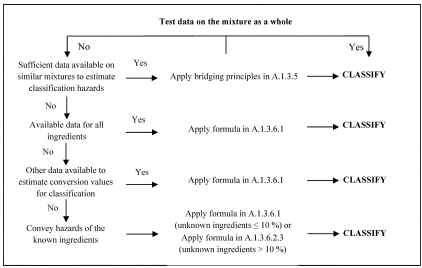
A.1.3.2 Classification of mixtures for acute toxicity may be carried out for each route of exposure, but is only required for one route of exposure as long as this route is followed (estimated or tested) for all ingredients and there is no relevant evidence to suggest acute toxicity by multiple routes. When there is relevant evidence of acute toxicity by multiple routes of exposure, classification is to be conducted for all appropriate routes of exposure. All available information shall be considered. The pictogram and signal word used shall reflect the most severe hazard category; and all relevant hazard statements shall be used.
A.1.3.3 For purposes of classifying the hazards of mixtures in the tiered approach:
(a) The “relevant ingredients” of a mixture are those which are present in concentrations ≥1% (weight/weight for solids, liquids, dusts, mists and vapors and volume/volume for gases). If there is reason to suspect that an ingredient present at a concentration <1% will affect classification of the mixture for acute toxicity, that ingredient shall also be considered relevant. Consideration of ingredients present at a concentration <1% is particularly important when classifying untested mixtures which contain ingredients that are classified in Category 1 and Category 2;
(b) Where a classified mixture is used as an ingredient of another mixture, the actual or derived acute toxicity estimate (ATE) for that mixture is used when calculating the classification of the new mixture using the formulas in A.1.3.6.1 and A.1.3.6.2.4.
(c) If the converted acute toxicity point estimates for all ingredients of a mixture are within the same category, then the mixture should be classified in that category.
(d) When only range data (or acute toxicity hazard category information) are available for ingredients in a mixture, they may be converted to point estimates in accordance with Table A.1.2 when calculating the classification of the new mixture using the formulas in A.1.3.6.1 and A.1.3.6.2.4.
A.1.3.4 Classification of mixtures where acute toxicity test data are available for the complete mixture
Where the mixture itself has been tested to determine its acute toxicity, it is classified according to the same criteria as those used for substances, presented in Table A.1.1. If test data for the mixture are not available, the procedures presented below must be followed.
A.1.3.5 Classification of mixtures where acute toxicity test data are not available for the complete mixture: bridging principles
Where the mixture itself has not been tested to determine its acute toxicity, but there are sufficient data on both the individual ingredients and similar tested mixtures to adequately characterize the hazards of the mixture, these data will be used in accordance with the following bridging principles as found in paragraph A.0.5 of this Appendix: Dilution, Batching, Concentration of mixtures, Interpolation within one hazard category, Substantially similar mixtures, and Aerosols.
A.1.3.6 Classification of mixtures based on ingredients of the mixture (additivity formula)
A.1.3.6.1 Data available for all ingredients.
The acute toxicity estimate (ATE) of ingredients is considered as follows:
(a) Include ingredients with a known acute toxicity, which fall into any of the acute hazard categories, or have an oral or dermal LD 50 greater than 2000 but less than or equal to 5000 mg/kg body weight (or the equivalent dose for inhalation);
(b) Ignore ingredients that are presumed not acutely toxic (e.g., water, sugar);
(c) Ignore ingredients if the data available are from a limit dose test (at the upper threshold for Category 4 for the appropriate route of exposure as provided in Table A.1.1) and do not show acute toxicity.
Ingredients that fall within the scope of this paragraph are considered to be ingredients with a known acute toxicity estimate (ATE). See note (b) to Table A.1.1 and paragraph A.1.3.3 for appropriate application of available data to the equation below, and paragraph A.1.3.6.2.4.
The ATE of the mixture is determined by calculation from the ATE values for all relevant ingredients according to the following formula below for oral, dermal or inhalation toxicity:

Where:
C i = concentration of ingredient i;
n ingredients and i is running from 1 to n;
ATE i = Acute toxicity estimate of ingredient i;
A.1.3.6.2 Data are not available for one or more ingredients of the mixture.
A.1.3.6.2.1 Where an ATE is not available for an individual ingredient of the mixture, but available information provides a derived conversion value, the formula in A.1.3.6.1 may be applied. This information may include evaluation of:
(a) Extrapolation between oral, dermal and inhalation acute toxicity estimates. Such an evaluation requires appropriate pharmacodynamic and pharmacokinetic data;
(b) Evidence from human exposure that indicates toxic effects but does not provide lethal dose data;
(c) Evidence from any other toxicity tests/assays available on the substance that indicates toxic acute effects but does not necessarily provide lethal dose data; or
(d) Data from closely analogous substances using structure/activity relationships.
A.1.3.6.2.2 This approach requires substantial supplemental technical information, and a highly trained and experienced expert, to reliably estimate acute toxicity. If sufficient information is not available to reliably estimate acute toxicity, proceed to the provisions of A.1.3.6.2.4.
A.1.3.6.2.3 In the event that an ingredient with unknown acute toxicity is used in a mixture at a concentration ≥1%, and the mixture has not been classified based on testing of the mixture as a whole, the mixture cannot be attributed a definitive acute toxicity estimate. In this situation the mixture is classified based on the known ingredients only.
Note: A statement that × percent of the mixture consists of ingredient(s) of unknown acute (oral/dermal/inhalation) toxicity is required on the label and safety data sheet in such cases; see appendix C to this section, Allocation of Label Elements and appendix D to this section, Safety Data Sheets).
A.1.3.6.2.4 If the total concentration of the relevant ingredient(s) with unknown acute toxicity is ≤10% then the formula presented in A.1.3.6.1 must be used. If the total concentration of the relevant ingredient(s) with unknown acute toxicity is ≤10%, the formula presented in A.1.3.6.1 is corrected to adjust for the percentage of the unknown ingredient(s) as follows:

| Exposure routes | Classification category or experimentally obtained acute toxicity range estimate | Converted acute toxicity point estimate |
|---|---|---|
| Oral (mg/kg bodyweight) | 0 < Category 1 ≤ 5 | 0.5 |
| 5 < Category 2 ≤ 50 | 5 | |
| 50 < Category 3 ≤ 300 | 100 | |
| 300 < Category 4 ≤ 2000 | 500 | |
| Dermal (mg/kg bodyweight) | 0 < Category 1 ≤ 50 | 5 |
| 50 < Category 2 ≤ 200 | 50 | |
| 200 < Category 3 ≤ 1000 | 300 | |
| 1000 < Category 4 ≤ 2000 | 1100 | |
| Gases (ppmV) | 0 < Category 1 ≤ 100 | 10 |
| 100 < Category 2 ≤ 500 | 100 | |
| 500 < Category 3 ≤ 2500 | 700 | |
| 2500 < Category 4 ≤ 20000 | 4500 | |
| Vapors (mg/l) | 0 < Category 1 ≤ 0.5 | 0.05 |
| 0.5 < Category 2 ≤ 2.0 | 0.5 | |
| 2.0 < Category 3 ≤ 10.0 | 3 | |
| 10.0 < Category 4 ≤ 20.0 | 11 | |
| Dust/mist (mg/l) | 0 < Category 1 ≤ 0.05 | 0.005 |
| 0.05 < Category 2 ≤ 0.5 | 0.05 | |
| 0.5 < Category 3 ≤ 1.0 | 0.5 | |
| 1.0 < Category 4 ≤ 5.0 | 1.5 | |
| Note: Gas concentrations are expressed in parts per million per volume (ppmV). | ||
A.2 Skin Corrosion/Irritation
A.2.1 Definitions and General Considerations
A.2.1.1 Skin corrosion refers to the production of irreversible damage to the skin; namely, visible necrosis through the epidermis and into the dermis occurring after initial exposure to a substance or mixture.
Skin irritation refers to the production of reversible damage to the skin occurring after initial exposure to a substance or mixture.
A.2.1.2 To classify, all available and relevant information on skin corrosion/irritation is collected and its quality in terms of adequacy and reliability is assessed. Wherever possible classification should be based on data generated using internationally validated and accepted methods, such as OECD Test Guidelines (TG) or equivalent methods. Sections A.2.2.1 to A.2.2.6 provide classification criteria for the different types of information that may be available.
A.2.1.3 A tiered approach (see A.2.2.7) organizes the available information into levels/tiers and provides for decision-making in a structured and sequential manner. Classification results directly when the information consistently satisfies the criteria. However, where the available information gives inconsistent and/or conflicting results within a tier, classification of a substance or a mixture is made on the basis of the weight of evidence within that tier. In some cases when information from different tiers gives inconsistent and/or conflicting results (see A.2.2.7.3) or where data individually are insufficient to conclude on the classification, an overall weight of evidence approach is used (see A.0.3).
A.2.2 Classification Criteria for Substances
Substances shall be allocated to one of the following categories within this hazard class:
(a) Category 1 (skin corrosion)
This category may be further divided into up to three sub-categories (1A, 1B, and 1C), which can be used by those authorities requiring more than one designation for corrosivity.
Corrosive substances should be classified in Category 1 where sub-categorization is not required by a competent authority or where data are not sufficient for sub-categorization.
When data are sufficient, substances may be classified in one of the three sub-categories 1A, 1B, or 1C.
(b) Category 2 (skin irritation)
A.2.2.1 Classification Based on Standard Human Data
Existing reliable and good quality human data on skin corrosion/irritation should be given high weight for classification. Existing human data could be derived from single or repeated exposure(s), for example in occupational, consumer, transport or emergency response scenarios and epidemiological and clinical studies in well-documented case reports and observations (see A.0.2.6 and A.0.3). Although human data from accident or poison center databases can provide evidence for classification, absence of incidents is not itself evidence for no classification, as exposures are generally unknown or uncertain.
A.2.2.2 Classification Based on Standard Animal Test Data
OECD TG 404 is the currently available internationally validated and accepted animal test for classification as skin corrosive or irritant (See Table A.2.1 and A.2.2) and is the standard animal test. The current version of OECD TG 404 uses a maximum of 3 animals. Results from animal studies conducted under previous versions of OECD TG 404 that used more than 3 animals are also considered standard animal tests.
A.2.2.2.1 Skin Corrosion
A.2.2.2.1.1 A substance is corrosive to the skin when it produces destruction of skin tissue, namely, visible necrosis through the epidermis and into the dermis, in at least one tested animal after initial exposure up to a 4-hour duration.
A.2.2.2.1.2 Three sub-categories of Category 1 are provided in Table A.2.1, all of which shall be regulated as Category 1.
| Criteria | |
|---|---|
| Category 1 | Destruction of skin tissue, namely, visible necrosis through the epidermis and into the dermis, in at least one tested animal after exposure ≤4 h. |
| Sub-category 1A | Corrosive responses in at least one animal following exposure ≤3 min during an observation period ≤1 h. |
| Sub-category 1B | Corrosive responses in at least one animal following exposure >3 min and ≤1 h and observations ≤14 days. |
| Sub-category 1C | Corrosive responses in at least one animal after exposures >1 h and ≤ 4 h and observations ≤14 days. |
| a The use of human data is discussed in A.2.2.1. | |
A.2.2.2.2 Skin Irritation
A.2.2.2.2.1 A substance is irritant to skin when it produces reversible damage to the skin following its application for up to 4 hours.
A.2.2.2.2.2 A single irritant category (Category 2) is presented in the Table A.2.2. A substance is irritant to skin, when after the first application, it produces reversible damage to the skin following its application for up to 4 hours. An irritation category (Category 2) is provided that:
(a) recognizes that some test substances may lead to effects which persist throughout the length of the test; and
(b) acknowledges that animal responses in a test may be variable.
A.2.2.2.2.3 Reversibility of skin lesions is another consideration in evaluating irritant responses. When inflammation persists to the end of the observation period in two or more test animals, taking into consideration alopecia (limited area), hyperkeratosis, hyperplasia and scaling, then a chemical should be considered to be an irritant.
A.2.2.2.2.4 Animal irritant responses within a test can be quite variable, as they are with corrosion. A separate irritant criterion accommodates cases when there is a significant irritant response but less than the mean score criterion for a positive test. For example, a substance should be designated as an irritant if at least 1 of 3 tested animals shows a very elevated mean score according to test method used throughout the study, including lesions persisting at the end of an observation period of normally 14 days. Other responses should also fulfil this criterion. However, it should be ascertained that the responses are the result of chemical exposure. Addition of this criterion increases the sensitivity of the classification system.
| Criteria | |
|---|---|
| a Grading criteria are understood as described in OECD Test Guideline 404. | |
| Irritant (Category 2) | (1) Mean score of ≥2.3 ≤4.0 for erythema/eschar or for edema in at least 2 of 3 testedanimals from gradings at 24, 48, 72 hours after patch removal or, if reactions are delayed, from grades on 3 consecutive days after the onset of skin reactions; or |
| (2) Inflammation that persists to the end of the observation period normally 14 days in at hyerplasia, and scaling; or | |
| (3) In some cases where there is pronounced variability of response among animals, with very definite positive effects related to chemical exposure in a single animal but less than the criteria above. | |
A.2.2.3 Classification Based on In Vitro/Ex Vivo Data
A.2.2.3.1 The currently available individual in vitro/ex vivo test methods address either skin irritation or skin corrosion, but do not address both endpoints in one single test. Therefore, classification based solely on in vitro/ex vivo test results may require data from more than one method.
A.2.2.3.2 Wherever possible classification should be based on data generated using internationally validated and accepted in vitro/ex vivo test methods, and the classification criteria provided in these test methods needs to be applied. In vitro/ex vivo data can only be used for classification when the tested substance is within the applicability domain of the test methods used. Additional limitations described in the published literature should also be taken into consideration.
A.2.2.3.3 Skin corrosion
A.2.2.3.3.1 Where tests have been undertaken in accordance with OECD Test Guidelines (TGs) 430, 431, or 435, a substance is classified for skin corrosion in category 1 (and, where possible and required into sub-categories 1A, 1B, or 1C) based on the criteria in Table A.2.6.
A.2.2.3.3.2 Some in vitro/ex vivo methods do not allow differentiation between sub-categories 1B and 1C. Where existing in vitro/ex vivo data cannot distinguish between the sub-categories, additional information has to be taken into account to differentiate between these two sub-categories. Where no or insufficient additional information is available, category 1 is applied.
A.2.2.3.3.3 A substance identified as not corrosive should be considered for classification as skin irritant.
A.2.2.3.4 Skin irritation
A.2.2.3.4.1 Where a conclusion of corrosivity can be excluded and where tests have been undertaken in accordance with OECD Test Guideline 439, a substance is classified for skin irritation in category 2 based on the criteria in Table A.2.7.
A.2.2.3.4.2 A negative result in an internationally accepted and validated in vitro/ex vivo test for skin irritation, e.g., OECD TG 439, can be used to conclude as not classified for skin irritation.
A.2.2.4 Classification Based on Other, Existing Skin Data in Animals
Other existing skin data in animals may be used for classification, but there may be limitations regarding the conclusions that can be drawn if a substance is highly toxic via the dermal route, an in vivo skin corrosion/irritation study may not have been conducted since the amount of test substance to be applied would considerably exceed the toxic dose and, consequently, would result in the death of the animals. When observations of skin corrosion/irritation in acute toxicity studies are made, these data may be used for classification, provided that the dilutions used and species tested are relevant. Solid substances (powders) may become corrosive or irritant when moistened or in contact with moist skin or mucous membranes. This is generally indicated in the standardized test methods.
A.2.2.5 Classification Based on Chemical Properties
Skin effects may be indicated by pH extremes such as ≤2 and ≥11.5 especially when associated with significant acid/alkaline reserve (buffering capacity). Generally, such substances are expected to produce significant effects on the skin. In the absence of any other information, a substance is considered corrosive (Skin Category 1) if it has a pH ≤2 or a pH ≥11.5. However, if consideration of acid/alkaline reserve suggests the substance may not be corrosive despite the low or high pH, this needs to be confirmed by other data, preferably from an appropriate validated in vitro/ex vivo test. Buffering capacity and pH can be determined by test methods including OECD TG 122.
A.2.2.6 Classification Based on Non-Test Methods
A.2.2.6.1 Classification, including non-classification, can be based on non-test methods, with due consideration of reliability and applicability, on a case-by-case basis. Such methods include computer models predicting qualitative structure-activity relationships (structural alerts, SAR); quantitative structure-activity relationships (QSARs); computer expert systems; and read-across using analogue and category approaches.
A.2.2.6.2 Read-across using analogue or category approaches requires sufficiently reliable test data on similar substance(s) and justification of the similarity of the tested substance(s) with the substance(s) to be classified. Where adequate justification of the read-across approach is provided, it has in general higher weight than (Q)SARs.
A.2.2.6.3 Classification based on (Q)SARs requires sufficient data and validation of the model. The validity of the computer models and the prediction should be assessed using internationally recognized principles for the validation of (Q)SARs. With respect to reliability, lack of alerts in a SAR or expert system is not sufficient evidence for no classification.
A.2.2.7 Classification in a Tiered Approach
A.2.2.7.1 A tiered approach to the evaluation of initial information should be considered, where applicable (Figure A.2.1), recognizing that not all elements may be relevant. However, all available and relevant information of sufficient quality needs to be examined for consistency with respect to the resulting classification.
A.2.2.7.2 In the tiered approach (Figure A.2.1), existing human and animal data form the highest tier, followed by in vitro/ex vivo data, other existing skin data in animals, and then other sources of information. Where information from data within the same tier is inconsistent and/or conflicting, the conclusion from that tier is determined by a weight of evidence approach.
A.2.2.7.3 Where information from several tiers is inconsistent and/or conflicting with respect to the resulting classification, information of sufficient quality from a higher tier is generally given a higher weight than information from a lower tier. However, when information from a lower tier would result in a stricter classification than information from a higher tier and there is concern for misclassification, then classification is determined by an overall weight of evidence approach. The same would apply in the case where there is human data indicating irritation but positive results from an in vitro/ex vivo test for corrosion.
Figure A.2.1—Application of the Tiered Approach for Skin Corrosion and Irritation
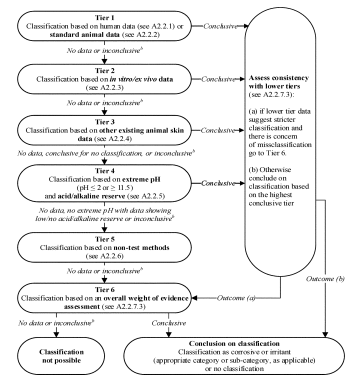
(a) Before applying the approach, the explanatory text in A.2.2.7 should be consulted. Only adequate and reliable data of sufficient quality should be included in applying the tiered approach.
(b) Information may be inconclusive for various reasons, e.g.:
—The available data may be of insufficient quality, or otherwise insufficient/inadequate for the purpose of classification, e.g., due to quality issues related to experimental design and/or reporting.
—The available data may be insufficient to conclude on the classification, e.g., they might be adequate to demonstrate irritancy, but inadequate to demonstrate absence of corrosivity.
—The method used to generate the available data may not be suitable for concluding on no classification (see A.2.2. for details). Specifically, in vitro/ex vivo and non-test methods need to be validated explicitly for this purpose.
A.2.3 Classification Criteria for Mixtures
A.2.3.1 Classification of Mixtures When Data Are Available for the Complete Mixture
A.2.3.1.1 In general, the mixture shall be classified using the criteria for substances, taking into account the tiered approach to evaluate data for this hazard class (as illustrated in Figure A.2.1) and A.2.3.1.2 and A.2.3.1.3. If classification is not possible using the tiered approach, then the approach described in A.2.3.2, or, if that is not applicable A.2.2.3.3 should be followed.
A.2.3.1.2 In vitro/ex vivo data generated from validated test methods may not have been validated using mixtures; although these methods are considered broadly applicable to mixtures, they can only be used for classification of mixtures when all ingredients of the mixture fall within the applicability domain of the test methods used. Specific limitations regarding applicability domains are described in the respective test methods, and should be taken into consideration as well as any further information on the limitations from the published literature. Where there is reason to assume or evidence indicating that the applicability domain of a particular test method is limited, data interpretation should be exercised with caution, or the results should be considered not applicable.
A.2.3.1.3 In the absence of any other information, a mixture is considered corrosive (Skin Category 1) if it has a pH ≤2 or a pH ≥11.5. However, if consideration of acid/alkaline reserve suggests the mixture may not be corrosive despite the low or high pH value, this needs to be confirmed by other data, preferably from an appropriate validated in vitro/ex vivo test.
A.2.3.2 Classification of Mixtures When Data Are Not Available for the Complete Mixture: Bridging Principles
A.2.3.2.1 Where the mixture itself has not been tested to determine its skin corrosion/irritation potential, but there are sufficient data on both the individual ingredients and similar tested mixtures to adequately characterize the hazards of the mixture, these data will be used in accordance with the following bridging principles, as found in paragraph A.0.5 of this Appendix: Dilution, Batching, Concentration of mixtures, Interpolation within one hazard category, Substantially similar mixtures, and Aerosols.
A.2.3.3 Classification of Mixtures When Data Are Available for All Ingredients or Only for Some Ingredients of the Mixture
A.2.3.3.1 In order to make use of all available data for purposes of classifying the skin corrosion/irritation hazards of mixtures, the following assumption has been made and is applied where appropriate in the tiered approach:
The “relevant ingredients” of a mixture are those which are present in concentrations ≥1% (weight/weight for solids, liquids, dusts, mists and vapors and volume/volume for gases.). If the classifier has reason to suspect that an ingredient present at a concentration <1% will affect classification of the mixture for skin corrosion/irritation, that ingredient shall also be considered relevant.
A.2.3.3.2 In general, the approach to classification of mixtures as corrosive or irritant to the skin when data are available on the ingredients, but not on the mixture as a whole, is based on the theory of additivity, such that each corrosive or irritant ingredient contributes to the overall corrosive or irritant properties of the mixture in proportion to its potency and concentration. A weighting factor of 10 is used for corrosive ingredients when they are present at a concentration below the concentration limit for classification with Category 1, but are at a concentration that will contribute to the classification of the mixture as an irritant. The mixture is classified as corrosive or irritant when the sum of the concentrations of such ingredients exceeds a cut-off value/concentration limit.
A.2.3.3.3 Table A.2.3 below provides the cut-off value/concentration limits to be used to determine if the mixture is considered to be corrosive or irritant to the skin.
A.2.3.3.4 Particular care shall be taken when classifying certain types of chemicals such as acids and bases, inorganic salts, aldehydes, phenols, and surfactants. The approach explained in A.2.3.3.1 and A.2.3.3.2 might not work given that many of such substances are corrosive or irritant at concentrations <1%. For mixtures containing strong acids or bases the pH should be used as classification criteria since pH will be a better indicator of corrosion than the concentration limits in Table A.2.3. A mixture containing corrosive or irritant ingredients that cannot be classified based on the additivity approach shown in Table A.2.3, due to chemical characteristics that make this approach unworkable, should be classified as skin corrosion Category 1 if it contains ≥1% of a corrosive ingredient and as skin irritation Category 2 when it contains ≥3% of an irritant ingredient. Classification of mixtures with ingredients for which the approach in Table A.2.3 does not apply is summarized in Table A.2.4 below.
A.2.3.3.5 On occasion, reliable data may show that the skin corrosion/irritation of an ingredient will not be evident when present at a level above the generic cut-off values/concentration limits mentioned in Tables A.2.3 and A.2.4. In these cases the mixture could be classified according to those data (See Use of cut-off values/concentration limits, paragraph A.0.4.3 of this Appendix).
A.2.3.3.6 If there are data showing that (an) ingredient(s) may be corrosive or irritant to skin at a concentration of <1% (corrosive) or <3% (irritant), the mixture shall be classified accordingly (See Use of cut-off values/concentration limits, paragraph A.0.4.3 of this Appendix).
| Sum of ingredients classified as: | Concentration triggering classification of a mixture as: | |
|---|---|---|
| Skin corrosive | Skin irritant | |
| Category 1 | Category 2 | |
| Skin Category 1 | ≥5% | ≥1% but <5% |
| Skin Category 2 | ≥10% | |
| (10 × Skin Category 1) + Skin Category 2 | ≥10% | |
| Note: Where the sub-categories of skin Category 1 (corrosive) are used, the sum of all ingredients of a mixture classified as sub-category 1A, 1B or 1C respectively, must each be ≥5% in order to classify the mixture as either skin sub-category 1A, 1B or 1C. Where the sum of 1A ingredients is <5% but the sum of 1A + 1B ingredients is ≥5%, the mixture must be classified as sub-category 1B. Similarly, where the sum of 1A + 1B ingredients is <5% but the sum of 1A + 1B + 1C ingredients is ≥5% the mixture must be classified as sub-category 1C. Where at least one relevant ingredient in a mixture is classified as a Category 1 categorization, the mixture must be classified as Category 1 without sub-categorization if the sum of all ingredients corrosive to skin is ≥5%. | ||
| Ingredient | Concentration (percent) | Mixture classified as: Skin |
|---|---|---|
| Acid with pH ≤2 | ≥1 | Category 1. |
| Base with pH ≥11.5 | ≥1 | Category 1. |
| Other corrosive (Category 1) ingredient | ≥1 | Category 1. |
| Other irritant (Category 2) ingredient, including acids and bases | ≥ 3 | Category 2. |
A.3 Serious Eye Damage/Eye Irritation
A.3.1 Definitions and General Considerations
A.3.1.1 Serious eye damage refers to the production of tissue damage in the eye, or serious physical decay of vision, which is not fully reversible, occurring after exposure of the eye to a substance or mixture.
Eye irritation refers to the production of changes in the eye, which are fully reversible, occurring after exposure of the eye to a substance or mixture.
A.3.1.2 Serious eye damage/eye irritation shall be classified using a tiered approach as detailed in Figure A.3.1. Emphasis shall be placed upon existing human data (See A.0.2.6), followed by existing animal data, followed by in vitro data and then other sources of information. Classification results directly when the data satisfy the criteria in this section. In case the criteria cannot be directly applied, classification of a substance or a mixture is made on the basis of the total weight of evidence (See A.0.3.1). This means that all available information bearing on the determination of serious eye damage/eye irritation is considered together, including the results of appropriate scientifically validated in vitro tests, relevant animal data, and human data such as epidemiological and clinical studies and well-documented case reports and observations.
A.3.2 Classification Criteria for Substances
Substances are allocated to one of the categories within this hazard class, Category 1 (serious eye damage) or Category 2 (eye irritation), as follows:
(a) Category 1 (serious eye damage/irreversible effects on the eye): substances that have the potential to seriously damage the eyes (see Table A.3.1).
(b) Category 2 (eye irritation/reversible effects on the eye): substances that have the potential to induce reversible eye irritation (see Table A.3.2).
A.3.2.1 Classification Based on Standard Animal Test Data
A.3.2.1.1 Serious eye damage (Category 1)/Irreversible effects on the eye
A single hazard category is provided in Table A.3.1, for substances that have the potential to seriously damage the eyes. Category 1, irreversible effects on the eye, includes the criteria listed below. These observations include animals with grade 4 cornea lesions and other severe reactions (e.g., destruction of cornea) observed at any time during the test, as well as persistent corneal opacity, discoloration of the cornea by a dye substance, adhesion, pannus, and interference with the function of the iris or other effects that impair sight. In this context, persistent lesions are considered those which are not fully reversible within an observation period of normally 21 days. Category 1 also contains substances fulfilling the criteria of corneal opacity ≥ 3 and/or iritis > 1.5 observed in at least 2 of 3 tested animals detected in a Draize eye test with rabbits, because severe lesions like these usually do not reverse within a 21-day observation period.
| Criteria | |
|---|---|
| Category 1: Serious eye damage/Irreversible effects on the eye |
A substance that produces:
calculated as the mean scores following grading at 24, 48 and 72 hours after instillation of the test material. |
| a Grading criteria are understood as described in OECD Test Guideline 405. | |
A.3.2.1.2 Eye irritation (category 2)/reversible effects on the eye
A single Category 2 is provided in Table A.3.2 for substances that have the potential to induce reversible eye irritation.
When data are available, substances may be classified into Category 2A and Category 2B:
(a) For substances inducing eye irritant effects reversing within an observation time of normally 21 days, Category 2A applies.
(b) For substances inducing eye irritant effects reversing within an observation time of 7 days, Category 2B applies.
When a substance is classified as Category 2, without further categorization, the classification criteria are the same as those for 2A.
A.3.2.1.3 For those substances where there is pronounced variability among animal responses this information must be taken into account in determining the classification.
| Criteria | |
|---|---|
| Substances that have the potential to induce reversible eye irritation. | |
| Category 2/2A | Substances that produce in at least 2 of 3 tested animals a positive response of:
calculated as the mean scores following grading at 24, 48 and 72 hours after instillation of the test material, and which fully reverses within an observation period of normally 21 days. |
| Category 2B | Within Category 2A an eye irritant is considered mildly irritating to eyes (Category 2B) when the effects listed above are fully reversible within 7 days of observation. |
| a Grading criteria are understood as described in OECD Test Guideline 405. | |
A.3.2.2 Classification in a Tiered Approach
A.3.2.2.1 A tiered approach to the evaluation of initial information shall be used where applicable, recognizing that all elements may not be relevant in certain cases (Figure A.3.1).
A.3.2.2.2 Existing human and animal data should be the first line of analysis, as they give information directly relevant to effects on the eye. Possible skin corrosion shall be evaluated prior to consideration of any testing for serious eye damage/eye irritation in order to avoid testing for local effects on eyes with skin corrosive substances.
A.3.2.2.3 In vitro alternatives that have been validated and accepted should be used to make classification decisions.
A.3.2.2.4 Likewise, pH extremes like ≤2 and ≥11.5, may indicate serious eye damage, especially when associated with significant acid/alkaline reserve (buffering capacity). Generally, such substances are expected to produce significant effects on the eyes. In the absence of any other information, a substance is considered to cause serious eye damage (Category 1) if it has a pH ≤2 or ≥11.5. However, if consideration of acid/alkaline reserve suggests the substance may not cause serious eye damage despite the low or high pH value, this needs to be confirmed by other data, preferably by data from an appropriate validated in vitro test.
A.3.2.2.5 In some cases sufficient information may be available from structurally related substances to make classification decisions.
A.3.2.2.6 The tiered approach provides guidance on how to organize existing information and to make a weight-of-evidence decision about hazard assessment and hazard classification (ideally without conducting new animal tests). Animal testing with corrosive substances should be avoided wherever possible. Although information might be gained from the evaluation of single parameters within a tier, consideration should be given to the totality of existing information and making an overall weight of evidence determination. This is especially true when there is conflict in information available on some parameters.
A.3.2.2.7 The tiered approach explains how to organize existing information and to make a weight-of-evidence decision about hazard assessment and hazard classification. Although information might be gained from the evaluation of single parameters within a tier, consideration should be given to the totality of existing information and making an overall weight of evidence determination. This is especially true when there is conflict in information available.
Figure A.3.1—Tiered Evaluation for Serious Eye Damage and Eye Irritation (See Also Figure A.2.1)


a Existing human or animal data could be derived from single or repeated exposure(s), for example in occupational, consumer, transport, or emergency response scenarios; or from purposely-generated data from animal studies conducted according to validated and internationally accepted test methods. Although human data from accident or poison center databases can provide evidence for classification, absence of incidents is not itself evidence for no classification as exposures are generally unknown or uncertain;
b Classify in the appropriate category as applicable;
c Existing animal data should be carefully reviewed to determine if sufficient serious eye damage/eye irritation evidence is available through other, similar information. It is recognized that not all skin irritants are eye irritants. Expert judgment should be exercised prior to making such a determination;
d Evidence from studies using validated protocols with isolated human/animal tissues or other non-tissue-based, validated protocols should be assessed. Examples of internationally accepted, validated test methods for identifying eye corrosives and severe irritants (i.e., Serious Eye Damage) include OECD Test Guidelines 437 (Bovine Corneal Opacity and Permeability (BCOP)), 438 (Isolated Chicken Eye (ICE) and 460 (Fluorescein leakage (FL)). Presently there are no validated and internationally accepted in vitro test methods for identifying eye irritation. A positive test result from a validated in vitro test on skin corrosion would lead to the conclusion to classify as causing serious eye damage;
e Measurement of pH alone may be adequate, but assessment of acid/alkaline reserve (buffering capacity) would be preferable. Presently, there is no validated and internationally accepted method for assessing this parameter;
f All information that is available on a substance must be considered and an overall determination made on the total weight of evidence. This is especially true when there is conflict in information available on some parameters. The weight of evidence including information on skin irritation may lead to classification for eye irritation. Negative results from applicable validated in vitro tests are considered in the total weight of evidence evaluation.
A.3.3 Classification Criteria for Mixtures
A.3.3.1 Classification of Mixtures When Data Are Available for the Complete Mixture
A.3.3.1.1 The mixture will be classified using the criteria for substances, and taking into account the tiered approach to evaluate data for this hazard class (as illustrated in Figure A.3.1).
A.3.3.1.2 When considering testing of the mixture, chemical manufacturers shall use a tiered approach as included in the criteria for classification of substances for skin corrosion and serious eye damage and eye irritation to help ensure an accurate classification, as well as to avoid unnecessary animal testing. In the absence of any other information, a mixture is considered to cause serious eye damage (Category 1) if it has a pH ≤2 or ≥11.5. However, if consideration of acid/alkaline reserve suggests the mixture may not have the potential to cause serious eye damage despite the low or high pH value, then further evaluation may be necessary.
A.3.3.2 Classification of Mixtures When Data Are Not Available for the Complete Mixture: Bridging Principles
A.3.3.2.1 Where the mixture itself has not been tested to determine its skin corrosivity or potential to cause serious eye damage or eye irritation, but there are sufficient data on both the individual ingredients and similar tested mixtures to adequately characterize the hazards of the mixture, these data will be used in accordance with the following bridging principles, as found in paragraph A.0.5 of this Appendix: Dilution, Batching, Concentration of mixtures, Interpolation within one hazard category, Substantially similar mixtures, and Aerosols.
A.3.3.3 Classification of Mixtures When Data Are Available for All Ingredients or Only for Some Ingredients of the Mixture
A.3.3.3.1 For purposes of classifying the serious eye damage/eye irritation hazards of mixtures in the tiered approach:
The “relevant ingredients” of a mixture are those which are present in concentrations ≥1% (weight/weight for solids, liquids, dusts, mists and vapors and volume/volume for gases.) If the classifier has reason to suspect that an ingredient present at a concentration <1% will affect classification of the mixture for serious eye damage/eye irritation, that ingredient shall also be considered relevant.
A.3.3.3.2 In general, the approach to classification of mixtures as seriously damaging to the eye or eye irritant when data are available on the ingredients, but not on the mixture as a whole, is based on the theory of additivity, such that each skin corrosive or serious eye damage/eye irritant ingredient contributes to the overall serious eye damage/eye irritation properties of the mixture in proportion to its potency and concentration. A weighting factor of 10 is used for skin corrosive and serious eye damaging ingredients when they are present at a concentration below the concentration limit for classification with Category 1, but are at a concentration that will contribute to the classification of the mixture as serious eye damaging/eye irritant. The mixture is classified as seriously damaging to the eye or eye irritant when the sum of the concentrations of such ingredients exceeds a threshold cut-off value/concentration limit.
A.3.3.3.3 Table A.3.3 provides the cut-off value/concentration limits to be used to determine if the mixture must be classified as seriously damaging to the eye or an eye irritant.
A.3.3.3.4 Particular care must be taken when classifying certain types of chemicals such as acids and bases, inorganic salts, aldehydes, phenols, and surfactants. The approach explained in A.3.3.3.1 and A.3.3.3.2 might not work given that many of such substances are seriously damaging to the eye/eye irritating at concentrations <1%. For mixtures containing strong acids or bases, the pH should be used as classification criteria (See A.3.3.1.2) since pH will be a better indicator of serious eye damage (subject to consideration of acid/alkali reserve) than the concentration limits of Table A.3.3. A mixture containing skin corrosive or serious eye damaging/eye irritating ingredients that cannot be classified based on the additivity approach applied in Table A.3.3 due to chemical characteristics that make this approach unworkable, should be classified as serious eye damage (Category 1) if it contains ≥1% of a skin corrosive or serious eye damaging ingredient and as Eye Irritation (Category 2) when it contains ≥3% of an eye irritant ingredient. Classification of mixtures with ingredients for which the approach in Table A.3.3 does not apply is summarized in Table A.3.4.
A.3.3.3.5 On occasion, reliable data may show that the irreversible/reversible eye effects of an ingredient will not be evident when present at a level above the generic cut-off values/concentration limits mentioned in Tables A.3.3 and A.3.4. In these cases the mixture could be classified according to those data (See also A.0.4.3 Use of cut-off values/concentration limits"). On occasion, when it is expected that the skin corrosion/irritation or the reversible/irreversible eye effects of an ingredient will not be evident when present at a level above the generic concentration/cut-off levels mentioned in Tables A.3.3 and A.3.4, testing of the mixture may be considered. In those cases, the tiered weight of evidence approach should be applied as referred to in section A.3.2, Figure A.3.1 and explained in detail in this chapter.
A.3.3.3.6 If there are data showing that (an) ingredient(s) may be corrosive to the skin or seriously damaging to the eye/eye irritating at a concentration of ≤1% (corrosive to the skin or seriously damaging to the eye) or ≤3% (eye irritant), the mixture shall be classified accordingly (See also paragraph A.0.4.3, Use of cut-off values/concentration limits).
| Sum of ingredients classified as | Concentration triggering classification of a mixture as | |
|---|---|---|
| Serious eye damage | Eye irritation | |
| Category 1 | Category 2/2A | |
| Skin corrosion (Category 1) + Serious eye damage (Category 1) a | ≥3% | ≥1% but <3% |
| Eye irritation (Category 2) | ≥10% b | |
| 10 × (Skin corrosion (Category 1) + Serious eye damage (Category 1)) a + Eye irritation (Category 2) | ≥10% | |
| Notes: a If an ingredient is classified as both skin Category 1 and eye Category 1 its concentration is considered only once in the calculation. b A mixture may be classified as Eye Irritation Category 2B in cases when all relevant ingredients are classified as Eye Irritation Category 2B. | ||
| Ingredient | Concentration (percent) | Mixture classified as |
|---|---|---|
| Acid with pH <2 | ≥1 | Serious eye damage (Category 1). |
| Base with pH ≥11.5 | ≥1 | Serious eye damage (Category 1). |
| Other skin corrosive or serious eye damage (Category 1) ingredients | ≥1 | Serious eye damage (Category 1). |
| Other eye irritant (Category 2) ingredients | ≥3 | Eye irritation (Category 2). |
A.4 Respiratory or Skin Sensitization
A.4.1 Definitions and General Considerations
A.4.1.1 Respiratory sensitization refers to hypersensitivity of the airways occurring after inhalation of a substance or mixture.
Skin sensitization refers to an allergic response occurring after skin contact with a substance or mixture.
A.4.1.2 For the purpose of this chapter, sensitization includes two phases: the first phase is induction of specialized immunological memory in an individual by exposure to an allergen. The second phase is elicitation, i.e., production of a cell-mediated or antibody-mediated allergic response by exposure of a sensitized individual to an allergen.
A.4.1.3 For respiratory sensitization, the pattern of induction followed by elicitation phases is shared in common with skin sensitization. For skin sensitization, an induction phase is required in which the immune system learns to react; clinical symptoms can then arise when subsequent exposure is sufficient to elicit a visible skin reaction (elicitation phase). As a consequence, predictive tests usually follow this pattern in which there is an induction phase, the response to which is measured by a standardized elicitation phase, typically involving a patch test. The local lymph node assay is the exception, directly measuring the induction response. Evidence of skin sensitization in humans normally is assessed by a diagnostic patch test.
A.4.1.4 Usually, for both skin and respiratory sensitization, lower levels are necessary for elicitation than are required for induction.
A.4.1.5 The hazard class “respiratory or skin sensitization” is differentiated into:
(a) Respiratory sensitization; and
(b) Skin sensitization
A.4.2 Classification Criteria for Substances
A.4.2.1 Respiratory Sensitizers
A.4.2.1.1 Hazard Categories
A.4.2.1.1.1 Effects seen in either humans or animals will normally justify classification in a weight of evidence approach for respiratory sensitizers. Substances may be allocated to one of the two sub-categories 1A or 1B using a weight of evidence approach in accordance with the criteria given in Table A.4.1 and on the basis of reliable and good quality evidence from human cases or epidemiological studies and/or observations from appropriate studies in experimental animals.
A.4.2.1.1.2 Where data are not sufficient for sub-categorization, respiratory sensitizers shall be classified in Category 1.
| Category 1 | Respiratory sensitizer |
|---|---|
| A substance is classified as a respiratory sensitizer | |
| (a) if there is evidence in humans that the substance can lead to specific respiratory hypersensitivity and/or | |
| (b) if there are positive results from an appropriate animal test. 1 | |
| Sub-category 1A | Substances showing a high frequency of occurrence in humans; or a probability of occurrence of a high sensitization rate in humans based on animal or other tests. 1 Severity of reaction may also be considered. |
| Sub-category 1B | Substances showing a low to moderate frequency of occurrence in humans; or a probability of occurrence of a low to moderate sensitization rate in humans based on animal or other tests. 1 Severity of reaction may also be considered. |
| 1 As of May 20, 2024, recognized and validated animal models for the testing of respiratory hypersensitivity are not available. Under certain circumstances, data from animal studies may provide valuable information in a weight of evidence assessment. | |
A.4.2.1.2 Human Evidence
A.4.2.1.2.1 Evidence that a substance can lead to specific respiratory hypersensitivity will normally be based on human experience. In this context, hypersensitivity is normally seen as asthma, but other hypersensitivity reactions such as rhinitis/conjunctivitis and alveolitis are also considered. The condition will have the clinical character of an allergic reaction. However, immunological mechanisms do not have to be demonstrated.
A.4.2.1.2.2 When considering the human evidence, it is necessary that in addition to the evidence from the cases, the following be taken into account:
(a) The size of the population exposed;
(b) The extent of exposure.
A.4.2.1.3 The evidence referred to above could be:
(a) Clinical history and data from appropriate lung function tests related to exposure to the substance, confirmed by other supportive evidence which may include:
(i) In vivo immunological test (e.g., skin prick test);
(ii) In vitro immunological test (e.g., serological analysis);
(iii) Studies that may indicate other specific hypersensitivity reactions where immunological mechanisms of action have not been proven, e.g., repeated low-level irritation, pharmacologically mediated effects;
(iv) A chemical structure related to substances known to cause respiratory hypersensitivity;
(b) Data from positive bronchial challenge tests with the substance conducted according to accepted guidelines for the determination of a specific hypersensitivity reaction.
A.4.2.1.2.4 Clinical history should include both medical and occupational history to determine a relationship between exposure to a specific substance and development of respiratory hypersensitivity. Relevant information includes aggravating factors both in the home and workplace, the onset and progress of the disease, family history and medical history of the patient in question. The medical history should also include a note of other allergic or airway disorders from childhood and smoking history.
A.4.2.1.2.5 The results of positive bronchial challenge tests are considered to provide sufficient evidence for classification on their own. It is, however, recognized that in practice many of the examinations listed above will already have been carried out.
A.4.2.1.3 Animal studies
A.4.2.1.2.3 Data from appropriate animal studies 2 which may be indicative of the potential of a substance to cause sensitization by inhalation in humans 3 may include:
2 At this writing, recognized and validated animal models for the testing of respiratory hypersensitivity are not available. Under certain circumstances, data from animal studies may provide valuable information in a weight of evidence assessment.
3 The mechanisms by which substances induce symptoms of asthma are not yet fully known. For preventive measures, these substances are considered respiratory sensitizers. However, if on the basis of the evidence, it can be demonstrated that these substances induce symptoms of asthma by irritation only in people with bronchial hyperactivity, they should not be considered as respiratory sensitizers.
(a) Measurements of Immunoglobulin E (IgE) and other specific immunological parameters, for example in mice
(b) Specific pulmonary responses in guinea pigs.
A.4.2.2 Skin Sensitizers
A.4.2.2.1 Hazard categories
A.4.2.2.1.1 Effects seen in either humans or animals will normally justify classification in a weight of evidence approach for skin sensitizers. Substances may be allocated to one of the two sub-categories 1A or 1B using a weight of evidence approach in accordance with the criteria given in Table A.4.2 and on the basis of reliable and good quality evidence from human cases or epidemiological studies and/or observations from appropriate studies in experimental animals according to the guidance values provided in A.4.2.2.2.1 and A.4.2.2.3.2 for sub-category 1A and in A.4.2.2.2.2 and A.4.2.2.3.3 for sub-category 1B.
A.4.2.2.1.2 Where data are not sufficient for sub-categorization, skin sensitizers shall be classified in Category 1.
| Category 1 | Skin sensitizer |
|---|---|
| A substance is classified as a skin sensitizer (a) if there is evidence in humans that the substance can lead to sensitization by skin contact in a substantial number of persons, or (b) if there are positive results from an appropriate animal test. | |
| Sub-category 1A | Substances showing a high frequency of occurrence in humans and/or a high potency in animals can be presumed to have the potential to produce significant sensitization in humans. Severity of reaction may also be considered. |
| Sub-category 1B | Substances showing a low to moderate frequency of occurrence in humans and/or a low to moderate potency in animals can be presumed to have the potential to produce sensitization in humans. Severity of reaction may also be considered. |
A.4.2.2.2 Human Evidence
A.4.2.2.2.1 Human evidence for sub-category 1A may include:
(a) Positive responses at ≤500 μg/cm2 (Human Repeat Insult Patch Test (HRIPT), Human Maximization Test (HMT)—induction threshold);
(b) Diagnostic patch test data where there is a relatively high and substantial incidence of reactions in a defined population in relation to relatively low exposure;
(c) Other epidemiological evidence where there is a relatively high and substantial incidence of allergic contact dermatitis in relation to relatively low exposure.
A.4.2.2.2.2 Human evidence for sub-category 1B may include:
(a) Positive responses at >500 μg/cm2 (HRIPT, HMT—induction threshold);
(b) Diagnostic patch test data where there is a relatively low but substantial incidence of reactions in a defined population in relation to relatively high exposure;
(c) Other epidemiological evidence where there is a relatively low but substantial incidence of allergic contact dermatitis in relation to relatively high exposure.
A.4.2.2.3 Animal Studies
A.4.2.2.3.1 For Category 1, when an adjuvant type test method for skin sensitization is used, a response of at least 30% of the animals is considered as positive. For a non-adjuvant Guinea pig test method, a response of at least 15% of the animals is considered positive. For Category 1, a stimulation index of three or more is considered a positive response in the local lymph node assay. 4
4 Test methods for skin sensitization are described in OECD Guideline 406 (the Guinea Pig Maximization test and the Buehler guinea pig test) and Guideline 429 (Local Lymph Node Assay). Other methods may be used provided that they are scientifically validated. The Mouse Ear Swelling Test (MEST), appears to be a reliable screening test to detect moderate to strong sensitizers, and can be used, in accordance with professional judgment, as a first stage in the assessment of skin sensitization potential.
A.4.2.2.3.2 Animal test results for sub-category 1A can include data with values indicated in the following Table A.4.3:
| Assay | Criteria |
|---|---|
| Local lymph node assay | EC3 value ≤2%. |
| Guinea pig maximization test | ≥30% responding at ≤0.1% intradermal induction dose or ≥60% responding at >0.1% to ≤1% intradermal induction dose. |
| Buehler assay | ≥15% responding at ≤0.2% topical induction dose or ≥60% responding at >0.2% to ≤20% topical induction dose. |
| Note: EC3 refers to the estimated concentration of test chemical required to induce a stimulation index of 3 in the local lymph node assay. | |
A.4.2.2.3.3 Animal test results for sub-category 1B can include data with values indicated in Table A.4.4 below:
| Assay | Criteria |
|---|---|
| Local lymph node assay | EC3 value >2%. |
| Guinea pig maximization test | ≥30% to <60% responding at >0.1% to ≤1% intradermal induction dose or ≥30% responding at >1% intradermal induction dose. |
| Buehler assay | ≥15% to <60% responding at >0.2% to ≤20% topical induction dose or ≥15% responding at >20% topical induction dose. |
| Note: EC3 refers to the estimated concentration of test chemical required to induce a stimulation index of 3 in the local lymph node assay. | |
A.4.2.2.4 Specific Considerations
A.4.2.2.4.1 For classification of a substance, evidence shall include one or more of the following using a weight of evidence approach:
(a) Positive data from patch testing, normally obtained in more than one dermatology clinic;
(b) Epidemiological studies showing allergic contact dermatitis caused by the substance. Situations in which a high proportion of those exposed exhibit characteristic symptoms are to be looked at with special concern, even if the number of cases is small;
(c) Positive data from appropriate animal studies;
(d) Positive data from experimental studies in humans (See paragraph A.0.2.6 of this Appendix);
(e) Well documented episodes of allergic contact dermatitis, normally obtained in more than one dermatology clinic;
(f) Severity of reaction.
A.4.2.2.4.2 Evidence from animal studies is usually much more reliable than evidence from human exposure. However, in cases where evidence is available from both sources, and there is conflict between the results, the quality and reliability of the evidence from both sources must be assessed in order to resolve the question of classification on a case-by-case basis. Normally, human data are not generated in controlled experiments with volunteers for the purpose of hazard classification but rather as part of risk assessment to confirm lack of effects seen in animal tests. Consequently, positive human data on skin sensitization are usually derived from case-control or other, less defined studies. Evaluation of human data must, therefore, be carried out with caution as the frequency of cases reflect, in addition to the inherent properties of the substances, factors such as the exposure situation, bioavailability, individual predisposition and preventive measures taken. Negative human data should not normally be used to negate positive results from animal studies. For both animal and human data, consideration should be given to the impact of vehicle.
A.4.2.2.4.3 If none of the above-mentioned conditions are met, the substance need not be classified as a skin sensitizer. However, a combination of two or more indicators of skin sensitization, as listed below, may alter the decision. This shall be considered on a case-by-case basis.
(a) Isolated episodes of allergic contact dermatitis;
(b) Epidemiological studies of limited power, e.g., where chance, bias or confounders have not been ruled out fully with reasonable confidence;
(c) Data from animal tests, performed according to existing guidelines, which do not meet the criteria for a positive result described in A.4.2.2.3, but which are sufficiently close to the limit to be considered significant;
(d) Positive data from non-standard methods;
(e) Positive results from close structural analogues.
A.4.2.2.4.4 Immunological contact urticaria
A.4.2.2.4.4.1 Substances meeting the criteria for classification as respiratory sensitizers may, in addition, cause immunological contact urticaria. Consideration shall be given to classifying these substances as skin sensitizers.
A.4.2.2.4.4.2 Substances which cause immunological contact urticaria without meeting the criteria for respiratory sensitizers shall be considered for classification as skin sensitizers.
A.4.2.2.4.4.3 There is no recognized animal model available to identify substances which cause immunological contact urticaria. Therefore, classification will normally be based on human evidence, similar to that for skin sensitization.
A.4.3 Classification Criteria for Mixtures
A.4.3.1 Classification of Mixtures When Data Are Available for the Complete Mixture
When reliable and good quality evidence, as described in the criteria for substances, from human experience or appropriate studies in experimental animals, is available for the mixture, then the mixture shall be classified by weight of evidence evaluation of these data. Care must be exercised in evaluating data on mixtures that the dose used does not render the results inconclusive.
A.4.3.2 Classification of Mixtures When Data Are Not Available for the Complete Mixture: Bridging Principles
A.4.3.2.1 Where the mixture itself has not been tested to determine its sensitizing properties, but there are sufficient data on both the individual ingredients and similar tested mixtures to adequately characterize the hazards of the mixture, these data will be used in accordance with the following agreed bridging principles as found in paragraph A.0.5 of this Appendix: Dilution, Batching, Concentration of mixtures, Interpolation within one hazard category/subcategory, Substantially similar mixtures, and Aerosols.
A.4.3.3 Classification of Mixtures When Data Are Available for All Ingredients or Only for Some Ingredients of the Mixture
The mixture shall be classified as a respiratory or skin sensitizer when at least one ingredient has been classified as a respiratory or skin sensitizer and is present at or above the appropriate cut-off value/concentration limit for the specific endpoint as shown in Table A.4.5.
| Ingredient classified as | Cut-off values/concentration limits triggering classification of a mixture as | ||
|---|---|---|---|
|
Respiratory sensitizer Category 1 |
Skin sensitizer
Category 1 | ||
| Solid/liquid (%) | Gas (%) | All physical states (%) | |
| Respiratory Sensitizer Category 1 | ≥0.1 | ≥0.1 | |
| Respiratory Sensitizer Sub-category 1A | ≥0.1 | ≥0.1 | |
| Respiratory Sensitizer Sub-category 1B | ≥1.0 | ≥0.2 | |
| Skin Sensitizer Category 1 | ≥0.1 | ||
| Skin Sensitizer Sub-category 1A | ≥0.1 | ||
| Skin Sensitizer Sub-category 1B | ≥1.0 | ||
A.5 Germ Cell Mutagenicity
A.5.1 Definitions and General Considerations
A.5.1.1 Germ cell mutagenicity refers to heritable gene mutations, including heritable structure and numerical chromosome aberrations in germ cells occurring after exposure to a substance or mixture.
A.5.1.2 A mutation is defined as a permanent change in the amount or structure of the genetic material in a cell. The term mutation applies both to heritable genetic changes that may be manifested at the phenotypic level and to the underlying DNA modifications when known (including, for example, specific base pair changes and chromosomal translocations). The term mutagenic and mutagen will be used for agents giving rise to an increased occurrence of mutations in populations of cells and/or organisms.
A.5.1.3 The more general terms genotoxic and genotoxicity apply to agents or processes which alter the structure, information content, or segregation of DNA, including those which cause DNA damage by interfering with normal replication processes, or which in a non-physiological manner (temporarily) alter its replication. Genotoxicity test results are usually taken as indicators for mutagenic effects.
A.5.1.4 This hazard class is primarily concerned with chemicals that may cause mutations in the germ cells of humans that can be transmitted to the progeny. However, mutagenicity/genotoxicity tests in vitro and in mammalian somatic cells in vivo are also considered in classifying substances and mixtures within this hazard class.
A.5.2 Classification Criteria for Substances
A.5.2.1 The classification system provides for two different categories of germ cell mutagens to accommodate the weight of evidence available. The two-category system is described in the Figure A.5.1.
Figure A.5.1—Hazard Categories for Germ Cell Mutagens
CATEGORY 1: Substances known to induce heritable mutations or to be regarded as if they induce heritable mutations in the germ cells of humans
Category 1A: Substances known to induce heritable mutations in germ cells of humans
Positive evidence from human epidemiological studies.
Category 1B: Substances which should be regarded as if they induce heritable mutations in the germ cells of humans
(a) Positive result(s) from in vivo heritable germ cell mutagenicity tests in mammals; or
(b) Positive result(s) from in vivo somatic cell mutagenicity tests in mammals, in combination with some evidence that the substance has potential to cause mutations to germ cells. This supporting evidence may, for example, be derived from mutagenicity/genotoxic tests in germ cells in vivo, or by demonstrating the ability of the substance or its metabolite(s) to interact with the genetic material of germ cells; or
(c) Positive results from tests showing mutagenic effects in the germ cells of humans, without demonstration of transmission to progeny; for example, an increase in the frequency of aneuploidy in sperm cells of exposed people.
CATEGORY 2: Substances which cause concern for humans owing to the possibility that they may induce heritable mutations in the germ cells of humans
Positive evidence obtained from experiments in mammals and/or in some cases from in vitro experiments, obtained from:
(a) Somatic cell mutagenicity tests in vivo, in mammals; or
(b) Other in vivo somatic cell genotoxicity tests which are supported by positive results from in vitro mutagenicity assays.
Note: Substances which are positive in in vitro mammalian mutagenicity assays, and which also show structure activity relationship to known germ cell mutagens, should be considered for classification as Category 2 mutagens.
A.5.2.2 Specific considerations for classification of substances as germ cell mutagens:
A.5.2.2.1 To arrive at a classification, test results are considered from experiments determining mutagenic and/or genotoxic effects in germ and/or somatic cells of exposed animals. Mutagenic and/or genotoxic effects determined in in vitro tests shall also be considered.
A.5.2.2.2 The system is hazard based, classifying chemicals on the basis of their intrinsic ability to induce mutations in germ cells. The scheme is, therefore, not meant for the (quantitative) risk assessment of chemical substances.
A.5.2.2.3 Classification for heritable effects in human germ cells is made on the basis of scientifically validated tests. Evaluation of the test results shall be done using expert judgment and all the available evidence shall be weighed for classification.
A.5.2.2.4 The classification of substances shall be based on the total weight of evidence available, using expert judgment. In those instances where a single well-conducted test is used for classification, it shall provide clear and unambiguously positive results. The relevance of the route of exposure used in the study of the substance compared to the route of human exposure should also be taken into account.
A.5.3 Classification Criteria for Mixtures 5
5It should be noted that the classification criteria for health hazards usually include a tiered scheme in which test data available on the complete mixture are considered as the first tier in the evaluation, followed by the applicable bridging principles, and lastly, cut-off values/concentration limits or additivity. However, this approach is not used for Germ Cell Mutagenicity. These criteria for Germ Cell Mutagenicity consider the cut-off values/concentration limits as the primary tier and allow the classification to be modified only on a case-by-case evaluation based on available test data for the mixture as a whole.
A.5.3.1 Classification of Mixtures When Data Are Available for All Ingredients or Only for Some Ingredients of the Mixture
A.5.3.1.1 Classification of mixtures shall be based on the available test data for the individual ingredients of the mixture using cut-off values/concentration limits for the ingredients classified as germ cell mutagens.
A.5.3.1.2 The mixture will be classified as a mutagen when at least one ingredient has been classified as a Category 1A, Category 1B or Category 2 mutagen and is present at or above the appropriate cut-off value/concentration limit as shown in Table A.5.1 below for Category 1 and 2 respectively.
| Ingredient classified as | Cut-off/concentration limits triggering classification of a mixture as: | |
|---|---|---|
| Category 1 mutagen | Category 2 mutagen | |
| Category 1A/B mutagen | ≥0.1% | |
| Category 2 mutagen | ≥1.0% | |
| Note: The cut-off values/concentration limits in the table above apply to solids and liquids (w/w units) as well as gases (v/v units). | ||
A.5.3.2 Classification of Mixtures When Data Are Available for the Mixture Itself
The classification may be modified on a case-by-case basis based on the available test data for the mixture as a whole. In such cases, the test results for the mixture as a whole must be shown to be conclusive taking into account dose and other factors such as duration, observations and analysis (e.g., statistical analysis, test sensitivity) of germ cell mutagenicity test systems.
A.5.3.3 Classification of Mixtures When Data Are Not Available for the Complete Mixture: Bridging Principles
A.5.3.3.1 Where the mixture itself has not been tested to determine its germ cell mutagenicity hazard, but there are sufficient data on both the individual ingredients and similar tested mixtures to adequately characterize the hazards of the mixture, these data will be used in accordance with the following bridging principles as found in paragraph A.0.5 of this Appendix: Dilution, Batching, and Substantially similar mixtures.
A.5.4 Examples of Scientifically Validated Test Methods
A.5.4.1 Examples of in vivo heritable germ cell mutagenicity tests are:
(a) Rodent dominant lethal mutation test (OECD 478)
(b) Mouse heritable translocation assay (OECD 485)
(c) Mouse specific locus test
A.5.4.2 Examples of in vivo somatic cell mutagenicity tests are:
(a) Mammalian bone marrow chromosome aberration test (OECD 475)
(b) Mammalian erythrocyte micronucleus test (OECD 474)
A.5.4.3 Examples of mutagenicity/genotoxicity tests in germ cells are:
(a) Mutagenicity tests:
(i) Mammalian spermatogonial chromosome aberration test (OECD 483)
(ii) Spermatid micronucleus assay
(b) Genotoxicity tests:
(i) Sister chromatid exchange analysis in spermatogonia
(ii) Unscheduled DNA synthesis test (UDS) in testicular cells
A.5.4.4 Examples of genotoxicity tests in somatic cells are:
(a) Liver Unscheduled DNA Synthesis (UDS) in vivo (OECD 486)
(b) Mammalian bone marrow Sister Chromatid Exchanges (SCE)
A.5.4.5 Examples of in vitro mutagenicity tests are:
(a) In vitro mammalian chromosome aberration test (OECD 473)
(b) In vitro mammalian cell gene mutation test (OECD 476)
(c) Bacterial reverse mutation tests (OECD 471)
A.5.4.6 As new, scientifically validated tests arise, these may also be used in the total weight of evidence to be considered.
A.6 Carcinogenicity
A.6.1 Definitions
Carcinogenicity refers to the induction of cancer or an increase in the incidence of cancer occurring after exposure to a substance or mixture. Substances and mixtures which have induced benign and malignant tumors in well-performed experimental studies on animals are considered also to be presumed or suspected human carcinogens unless there is strong evidence that the mechanism of tumor formation is not relevant for humans.
Classification of a substance or mixture as posing a carcinogenic hazard is based on its inherent properties and does not provide information on the level of the human cancer risk which the use of the substance or mixture may represent.
A.6.2 Classification Criteria for Substances 6
6See Non-mandatory appendix F of this section, part A for further guidance regarding hazard classification for carcinogenicity. This appendix is consistent with the GHS and is provided as guidance excerpted from the International Agency for Research on Cancer (IARC) “Monographs on the Evaluation of Carcinogenic Risks to Humans” (2006).
A.6.2.1 For the purpose of classification for carcinogenicity, substances are allocated to one of two categories based on strength of evidence and additional weight of evidence considerations. In certain instances, route-specific classification may be warranted.
Figure A.6.1—Hazard Categories for Carcinogens
CATEGORY 1: Known or presumed human carcinogens
The placing of a substance in Category 1 is done on the basis of epidemiological and/or animal data. An individual substance may be further distinguished:
Category 1A: Known to have carcinogenic potential for humans; the placing of a substance is largely based on human evidence.
Category 1B: Presumed to have carcinogenic potential for humans; the placing of a substance is largely based on animal evidence.
Based on strength of evidence together with additional considerations, such evidence may be derived from human studies that establish a causal relationship between human exposure to a substance and the development of cancer (known human carcinogen). Alternatively, evidence may be derived from animal experiments for which there is sufficient evidence to demonstrate animal carcinogenicity (presumed human carcinogen). In addition, on a case by case basis, scientific judgement may warrant a decision of presumed human carcinogenicity derived from studies showing limited evidence of carcinogenicity in humans together with limited evidence of carcinogenicity in experimental animals.
Classification: Category 1 (A and B) Carcinogen
CATEGORY 2: Suspected human carcinogens
The placing of a substance in Category 2 is done on the basis of evidence obtained from human and/or animal studies, but which is not sufficiently convincing to place the substance in Category 1. Based on strength of evidence together with additional considerations, such evidence may be from either limited evidence of carcinogenicity in human studies or from limited evidence of carcinogenicity in animal studies.
Classification: Category 2 Carcinogen
A.6.2.2 Classification as a carcinogen is made on the basis of evidence from reliable and acceptable methods, and is intended to be used for substances which have an intrinsic property to produce such toxic effects. The evaluations are to be based on all existing data, peer-reviewed published studies and additional data accepted by regulatory agencies.
A.6.2.3 Carcinogen classification is a one-step, criterion-based process that involves two interrelated determinations: evaluations of strength of evidence and consideration of all other relevant information to place substances with human cancer potential into hazard categories.
A.6.2.4 Strength of evidence involves the enumeration of tumors in human and animal studies and determination of their level of statistical significance. Sufficient human evidence demonstrates causality between human exposure and the development of cancer, whereas sufficient evidence in animals shows a causal relationship between the agent and an increased incidence of tumors. Limited evidence in humans is demonstrated by a positive association between exposure and cancer, but a causal relationship cannot be stated. Limited evidence in animals is provided when data suggest a carcinogenic effect, but are less than sufficient. (Guidance on consideration of important factors in the classification of carcinogenicity and a more detailed description of the terms “limited” and “sufficient” have been developed by the International Agency for Research on Cancer (IARC) and are provided in non-mandatory appendix F of this section.)
A.6.2.5 Weight of evidence: Beyond the determination of the strength of evidence for carcinogenicity, a number of other factors should be considered that influence the overall likelihood that an agent may pose a carcinogenic hazard in humans. The full list of factors that influence this determination is very lengthy, but some of the important ones are considered here.
A.6.2.5.1 These factors can be viewed as either increasing or decreasing the level of concern for human carcinogenicity. The relative emphasis accorded to each factor depends upon the amount and coherence of evidence bearing on each. Generally, there is a requirement for more complete information to decrease than to increase the level of concern. Additional considerations should be used in evaluating the tumor findings and the other factors in a case-by-case manner.
A.6.2.5.2 Some important factors which may be taken into consideration, when assessing the overall level of concern are:
(a) Tumor type and background incidence;
(b) Multisite responses;
(c) Progression of lesions to malignancy;
(d) Reduced tumor latency;
Additional factors which may increase or decrease the level of concern include:
(e) Whether responses are in single or both sexes;
(f) Whether responses are in a single species or several species;
(g) Structural similarity or not to a substance(s) for which there is good evidence of carcinogenicity;
(h) Routes of exposure;
(i) Comparison of absorption, distribution, metabolism and excretion between test animals and humans;
(j) The possibility of a confounding effect of excessive toxicity at test doses; and,
(k) Mode of action and its relevance for humans, such as mutagenicity, cytotoxicity with growth stimulation, mitogenesis, immunosuppression.
Mutagenicity: It is recognized that genetic events are central in the overall process of cancer development. Therefore, evidence of mutagenic activity in vivo may indicate that a substance has a potential for carcinogenic effects.
A.6.2.5.3 A substance that has not been tested for carcinogenicity may in certain instances be classified in Category 1A, Category 1B, or Category 2 based on tumor data from a structural analogue together with substantial support from consideration of other important factors such as formation of common significant metabolites, e.g., for benzidine congener dyes.
A.6.2.5.4 The classification should also take into consideration whether or not the substance is absorbed by a given route(s); or whether there are only local tumors at the site of administration for the tested route(s), and adequate testing by other major route(s) show lack of carcinogenicity.
A.6.2.5.5 It is important that whatever is known of the physico-chemical, toxicokinetic and toxicodynamic properties of the substances, as well as any available relevant information on chemical analogues, i.e., structure activity relationship, is taken into consideration when undertaking classification.
A.6.3 Classification Criteria for Mixtures 7
7It should be noted that the classification criteria for health hazards usually include a tiered scheme in which test data available on the complete mixture are considered as the first tier i the evaluation, followed by the applicable bridging principles, and lastly, cut-off values/concentration limit or addivity. However, this approach is not used for Carcinogenicity. These criteria for Carcinogenicity consider the cut-off values/concentration limits as the primary tier and allow the classification to be modified only on a case-by-case evaluation based on available test data for the mixture as a whole.
A.6.3.1 The mixture shall be classified as a carcinogen when at least one ingredient has been classified as a Category 1 or Category 2 carcinogen and is present at or above the appropriate cut-off value/concentration limit as shown in Table A.6.1.
| Ingredient classified as | Category 1 carcinogen | Category 2 carcinogen |
|---|---|---|
| Category 1 carcinogen | ≥0.1% | |
| Category 2 carcinogen | ≥0.1% (note 1) | |
| Note:If a Category 2 carcinogen ingredient is present in the mixture at a concentration between 0.1% and 1%, information is required on the SDS for a product. However, a label warning is optional. If a Category 2 carcinogen ingredient is present in the mixture at a concentration of ≥1%, both an SDS and a label is required and the information must be included on each. | ||
A.6.3.2 Classification of mixtures when data are available for the complete mixture
A mixture may be classified based on the available test data for the mixture as a whole. In such cases, the test results for the mixture as a whole must be shown to be conclusive taking into account dose and other factors such as duration, observations and analysis (e.g., statistical analysis, test sensitivity) of carcinogenicity test systems.
A.6.3.3 Classification of mixtures when data are not available for the complete mixture: bridging principles
Where the mixture itself has not been tested to determine its carcinogenic hazard, but there are sufficient data on both the individual ingredients and similar tested mixtures to adequately characterize the hazards of the mixture, these data will be used in accordance with the following bridging principles as found in paragraph A.0.5 of this Appendix: Dilution; Batching; and Substantially similar mixtures.
A.6.4 Classification of Carcinogenicity 8
8 See Non-mandatory appendix f of this section for further guidance regarding hazard classification for carcinogenicity and how to relate carcinogenicity classification information from IARC and NTP to GHS.
A.6.4.1 Chemical manufacturers, importers and employers evaluating chemicals may treat the following sources as establishing that a substance is a carcinogen or potential carcinogen for hazard communication purposes in lieu of applying the criteria described herein:
A.6.4.1.1 National Toxicology Program (NTP), “Report on Carcinogens” (latest edition);
A.6.4.1.2 International Agency for Research on Cancer (IARC) “Monographs on the Evaluation of Carcinogenic Risks to Humans” (latest editions)
A.6.4.2 Where OSHA has included cancer as a health hazard to be considered by classifiers for a chemical covered by 29 CFR part 1910, subpart Z, chemical manufacturers, importers, and employers shall classify the chemical as a carcinogen.
A.7 Reproductive Toxicity
A.7.1 Definitions and General Considerations
A.7.1.1 Reproductive toxicity refers to adverse effects on sexual function and fertility in adult males and females, as well as developmental toxicity in the offspring, occurring after exposure to a substance or mixture. Some reproductive toxic effects cannot be clearly assigned to either impairment of sexual function and fertility or to developmental toxicity. Nonetheless, substances and mixtures with these effects shall be classified as reproductive toxicants. For classification purposes, the known induction of genetically based inheritable effects in the offspring is addressed in Germ cell mutagenicity (See A.5).
A.7.1.2 Adverse effects on sexual function and fertility means any effect of chemicals that interferes with reproductive ability or sexual capacity. This includes, but is not limited to, alterations to the female and male reproductive system, adverse effects on onset of puberty, gamete production and transport, reproductive cycle normality, sexual behavior, fertility, parturition, pregnancy outcomes, premature reproductive senescence, or modifications in other functions that are dependent on the integrity of the reproductive systems.
A.7.1.3 Adverse effects on development of the offspring means any effect of chemicals which interferes with normal development of the conceptus either before or after birth, which is induced during pregnancy or results from parental exposure. These effects can be manifested at any point in the life span of the organism. The major manifestations of developmental toxicity include death of the developing organism, structural abnormality, altered growth and functional deficiency.
A.7.1.4 Adverse effects on or via lactation are also included in reproductive toxicity, but for classification purposes, such effects are treated separately (See A.7.2.1).
A.7.2 Classification Criteria for Substances
A.7.2.1 For the purpose of classification for reproductive toxicity, substances shall be classified in one of two categories in accordance with Figure A.7.1(a). Effects on sexual function and fertility, and on development, shall be considered. In addition, effects on or via lactation shall be classified in a separate hazard category in accordance with Figure A.7.1(b).
Figure A.7.1(a)—Hazard Categories for Reproductive Toxicants
CATEGORY 1: Known or presumed human reproductive toxicant
This category includes substances which are known to have produced an adverse effect on sexual function and fertility or on development in humans or for which there is evidence from animal studies, possibly supplemented with other information, to provide a strong presumption that the substance has the capacity to interfere with reproduction in humans. For regulatory purposes, a substance can be further distinguished on the basis of whether the evidence for classification is primarily from human data (Category 1A) or from animal data (Category 1B).
CATEGORY 1A: Known human reproductive toxicant
The placing of the substance in this category is largely based on evidence from humans.
CATEGORY 1B: Presumed human reproductive toxicant
The placing of the substance in this category is largely based on evidence from experimental animals. Data from animal studies should provide clear evidence of an adverse effect on sexual function and fertility or on development in the absence of other toxic effects, or if occurring together with other toxic effects the adverse effect on reproduction is considered not to be a secondary non-specific consequence of other toxic effects. However, when there is mechanistic information that raises doubt about the relevance of the effect for humans, classification in Category 2 may be more appropriate.
CATEGORY 2: Suspected human reproductive toxicant
This category includes substances for which there is some evidence from humans or experimental animals, possibly supplemented with other information, of an adverse effect on sexual function and fertility, or on development, in the absence of other toxic effects, or if occurring together with other toxic effects the adverse effect on reproduction is considered not to be a secondary non-specific consequence of the other toxic effects, and where the evidence is not sufficiently convincing to place the substance in Category 1. For instance, deficiencies in the study may make the quality of evidence less convincing, and in view of this Category 2 could be the more appropriate classification.
Figure A.7.1(b)—Hazard Category for Effects on or Via Lactation
EFFECTS ON OR VIA LACTATION
Effects on or via lactation are allocated to a separate category. It is appreciated that for many substances there is no information on the potential to cause adverse effects on the offspring via lactation. However, substances which are absorbed by women and have been shown to interfere with lactation, or which may be present (including metabolites) in breast milk in amounts sufficient to cause concern for the health of a breastfed child, should be classified to indicate this property.
Classification for effects via lactation shall be assigned on the basis of:
(a) absorption, metabolism, distribution and excretion studies that would indicate the likelihood the substance would be present in potentially toxic levels in breast milk; and/or
(b) results of one or two generation studies in animals which provide clear evidence of adverse effect in the offspring due to transfer in the milk or adverse effect on the quality of the milk; and/or
(c) human evidence indicating a hazard to babies during the lactation period.
A.7.2.2 Basis of Classification
A.7.2.2.1 Classification is made on the basis of the criteria, outlined above, an assessment of the total weight of evidence, and the use of expert judgment. Classification as a reproductive toxicant is intended to be used for substances which have an intrinsic, specific property to produce an adverse effect on reproduction and substances should not be so classified if such an effect is produced solely as a non-specific secondary consequence of other toxic effects.
A.7.2.2.2 In the evaluation of toxic effects on the developing offspring, it is important to consider the possible influence of maternal toxicity.
A.7.2.2.3 For human evidence to provide the primary basis for a Category 1A classification there must be reliable evidence of an adverse effect on reproduction in humans. Evidence used for classification shall be from well conducted epidemiological studies, if available, which include the use of appropriate controls, balanced assessment, and due consideration of bias or confounding factors. Less rigorous data from studies in humans may be sufficient for a Category 1A classification if supplemented with adequate data from studies in experimental animals, but classification in Category 1B may also be considered.
A.7.2.3 Weight of Evidence
A.7.2.3.1 Classification as a reproductive toxicant is made on the basis of an assessment of the total weight of evidence using expert judgment. This means that all available information that bears on the determination of reproductive toxicity is considered together. Included is information such as epidemiological studies and case reports in humans and specific reproduction studies along with sub-chronic, chronic and special study results in animals that provide relevant information regarding toxicity to reproductive and related endocrine organs. Evaluation of substances chemically related to the material under study may also be included, particularly when information on the material is scarce. The weight given to the available evidence will be influenced by factors such as the quality of the studies, consistency of results, nature and severity of effects, level of statistical significance for intergroup differences, number of endpoints affected, relevance of route of administration to humans and freedom from bias. Both positive and negative results are considered together in a weight of evidence determination. However, a single, positive study performed according to good scientific principles and with statistically or biologically significant positive results may justify classification (See also A.7.2.2.3).
A.7.2.3.2 Toxicokinetic studies in animals and humans, site of action and mechanism or mode of action study results may provide relevant information, which could reduce or increase concerns about the hazard to human health. If it is conclusively demonstrated that the clearly identified mechanism or mode of action has no relevance for humans or when the toxicokinetic differences are so marked that it is certain that the hazardous property will not be expressed in humans then a chemical which produces an adverse effect on reproduction in experimental animals should not be classified.
A.7.2.3.3 In some reproductive toxicity studies in experimental animals the only effects recorded may be considered of low or minimal toxicological significance and classification may not necessarily be the outcome. These effects include, for example, small changes in semen parameters or in the incidence of spontaneous defects in the fetus, small changes in the proportions of common fetal variants such as are observed in skeletal examinations, or in fetal weights, or small differences in postnatal developmental assessments.
A.7.2.3.4 Data from animal studies shall provide sufficient evidence of specific reproductive toxicity in the absence of other systemic toxic effects. However, if developmental toxicity occurs together with other toxic effects in the dam (mother), the potential influence of the generalized adverse effects should be assessed to the extent possible. The preferred approach is to consider adverse effects in the embryo/fetus first, and then evaluate maternal toxicity, along with any other factors which are likely to have influenced these effects, as part of the weight of evidence. In general, developmental effects that are observed at maternally toxic doses should not be automatically discounted. Discounting developmental effects that are observed at maternally toxic doses can only be done on a case-by-case basis when a causal relationship is established or refuted.
A.7.2.3.5 If appropriate information is available it is important to try to determine whether developmental toxicity is due to a specific maternally mediated mechanism or to a non-specific secondary mechanism, like maternal stress and the disruption of homeostasis. Generally, the presence of maternal toxicity should not be used to negate findings of embryo/fetal effects, unless it can be clearly demonstrated that the effects are secondary non-specific effects. This is especially the case when the effects in the offspring are significant, e.g., irreversible effects such as structural malformations. In some situations it is reasonable to assume that reproductive toxicity is due to a secondary consequence of maternal toxicity and discount the effects, for example if the chemical is so toxic that dams fail to thrive and there is severe inanition; they are incapable of nursing pups; or they are prostrate or dying.
A.7.2.4 Maternal Toxicity
A.7.2.4.1 Development of the offspring throughout gestation and during the early postnatal stages can be influenced by toxic effects in the mother either through non-specific mechanisms related to stress and the disruption of maternal homeostasis, or by specific maternally-mediated mechanisms. So, in the interpretation of the developmental outcome to decide classification for developmental effects it is important to consider the possible influence of maternal toxicity. This is a complex issue because of uncertainties surrounding the relationship between maternal toxicity and developmental outcome. Expert judgment and a weight of evidence approach, using all available studies, shall be used to determine the degree of influence to be attributed to maternal toxicity when interpreting the criteria for classification for developmental effects. The adverse effects in the embryo/fetus shall be first considered, and then maternal toxicity, along with any other factors which are likely to have influenced these effects, as weight of evidence, to help reach a conclusion about classification.
A.7.2.4.2 Based on pragmatic observation, it is believed that maternal toxicity may, depending on severity, influence development via non-specific secondary mechanisms, producing effects such as depressed fetal weight, retarded ossification, and possibly resorptions and certain malformations in some strains of certain species. However, the limited numbers of studies which have investigated the relationship between developmental effects and general maternal toxicity have failed to demonstrate a consistent, reproducible relationship across species. Developmental effects which occur even in the presence of maternal toxicity are considered to be evidence of developmental toxicity, unless it can be unequivocally demonstrated on a case by case basis that the developmental effects are secondary to maternal toxicity. Moreover, classification shall be considered where there is a significant toxic effect in the offspring, e.g., irreversible effects such as structural malformations, embryo/fetal lethality, or significant post-natal functional deficiencies.
A.7.2.4.3 Classification shall not automatically be discounted for chemicals that produce developmental toxicity only in association with maternal toxicity, even if a specific maternally-mediated mechanism has been demonstrated. In such a case, classification in Category 2 may be considered more appropriate than Category 1. However, when a chemical is so toxic that maternal death or severe inanition results, or the dams (mothers) are prostrate and incapable of nursing the pups, it is reasonable to assume that developmental toxicity is produced solely as a secondary consequence of maternal toxicity and discount the developmental effects. Classification is not necessarily the outcome in the case of minor developmental changes, e.g., a small reduction in fetal/pup body weight or retardation of ossification when seen in association with maternal toxicity.
A.7.2.4.4 Some of the endpoints used to assess maternal toxicity are provided below. Data on these endpoints, if available, shall be evaluated in light of their statistical or biological significance and dose-response relationship.
(a) Maternal mortality: An increased incidence of mortality among the treated dams over the controls shall be considered evidence of maternal toxicity if the increase occurs in a dose-related manner and can be attributed to the systemic toxicity of the test material. Maternal mortality greater than 10% is considered excessive and the data for that dose level shall not normally be considered to need further evaluation.
(b) Mating index (Number of animals with seminal plugs or sperm/Number of mated × 100)
(c) Fertility index (Number of animals with implants/Number of matings × 100)
(d) Gestation length (If allowed to deliver)
(e) Body weight and body weight change: Consideration of the maternal body weight change and/or adjusted (corrected) maternal body weight shall be included in the evaluation of maternal toxicity whenever such data are available. The calculation of an adjusted (corrected) mean maternal body weight change, which is the difference between the initial and terminal body weight minus the gravid uterine weight (or alternatively, the sum of the weights of the fetuses), may indicate whether the effect is maternal or intrauterine. In rabbits, the body weight gain may not be a useful indicator of maternal toxicity because of normal fluctuations in body weight during pregnancy.
(f) Food and water consumption (if relevant): The observation of a significant decrease in the average food or water consumption in treated dams (mothers) compared to the control group may be useful in evaluating maternal toxicity, particularly when the test material is administered in the diet or drinking water. Changes in food or water consumption must be evaluated in conjunction with maternal body weights when determining if the effects noted are reflective of maternal toxicity or more simply, unpalatability of the test material in feed or water.
(g) Clinical evaluations (including clinical signs, markers, and hematology and clinical chemistry studies): The observation of increased incidence of significant clinical signs of toxicity in treated dams (mothers) relative to the control group is useful in evaluating maternal toxicity. If this is to be used as the basis for the assessment of maternal toxicity, the types, incidence, degree and duration of clinical signs shall be reported in the study. Clinical signs of maternal intoxication include, but are not limited to: coma, prostration, hyperactivity, loss of righting reflex, ataxia, or labored breathing.
(h) Post-mortem data: Increased incidence and/or severity of post-mortem findings may be indicative of maternal toxicity. This can include gross or microscopic pathological findings or organ weight data, including absolute organ weight, organ-to-body weight ratio, or organ-to-brain weight ratio. When supported by findings of adverse histopathological effects in the affected organ(s), the observation of a significant change in the average weight of suspected target organ(s) of treated dams (mothers), compared to those in the control group, may be considered evidence of maternal toxicity.
A.7.2.5 Animal and Experimental Data
A.7.2.5.1 A number of scientifically validated test methods are available, including methods for developmental toxicity testing (e.g., OECD Test Guideline 414, ICH Guideline S5A, 1993), methods for peri- and post-natal toxicity testing (e.g., ICH S5B, 1995), and methods for one or two-generation toxicity testing (e.g., OECD Test Guidelines 415, 416, 443).
A.7.2.5.2 Results obtained from screening tests (e.g., OECD Guidelines 421—Reproduction/Developmental Toxicity Screening Test, and 422—Combined Repeated Dose Toxicity Study with Reproduction/Development Toxicity Screening Test) can also be used to justify classification, although the quality of this evidence is less reliable than that obtained through full studies.
A.7.2.5.3 Adverse effects or changes, seen in short- or long-term repeated dose toxicity studies, which are judged likely to impair reproductive function and which occur in the absence of significant generalized toxicity, may be used as a basis for classification, e.g., histopathological changes in the gonads.
A.7.2.5.4 Evidence from in vitro assays, or non-mammalian tests, and from analogous substances using structure-activity relationship (SAR), can contribute to the procedure for classification. In all cases of this nature, expert judgment must be used to assess the adequacy of the data. Inadequate data shall not be used as a primary support for classification.
A.7.2.5.5 It is preferable that animal studies are conducted using appropriate routes of administration which relate to the potential route of human exposure. However, in practice reproductive toxicity studies are commonly conducted using the oral route, and such studies will normally be suitable for evaluating the hazardous properties of the substance with respect to reproductive toxicity. However, if it can be conclusively demonstrated that the clearly identified mechanism or mode of action has no relevance for humans or when the toxicokinetic differences are so marked that it is certain that the hazardous property will not be expressed in humans then a substance which produces an adverse effect on reproduction in experimental animals should not be classified.
A.7.2.5.6 Studies involving routes of administration such as intravenous or intraperitoneal injection, which may result in exposure of the reproductive organs to unrealistically high levels of the test substance, or elicit local damage to the reproductive organs, e.g., by irritation, must be interpreted with extreme caution and on their own are not normally the basis for classification.
A.7.2.5.7 There is general agreement about the concept of a limit dose, above which the production of an adverse effect may be considered to be outside the criteria which lead to classification. Some test guidelines specify a limit dose, other test guidelines qualify the limit dose with a statement that higher doses may be necessary if anticipated human exposure is sufficiently high that an adequate margin of exposure would not be achieved. Also, due to species differences in toxicokinetics, establishing a specific limit dose may not be adequate for situations where humans are more sensitive than the animal model.
A.7.2.5.8 In principle, adverse effects on reproduction seen only at very high dose levels in animal studies (for example doses that induce prostration, severe inappetence, excessive mortality) do not normally lead to classification, unless other information is available, for example, toxicokinetics information indicating that humans may be more susceptible than animals, to suggest that classification is appropriate.
A.7.2.5.9 However, specification of the actual “limit dose” will depend upon the test method that has been employed to provide the test results.
A.7.3 Classification Criteria for Mixtures 9
9It should be noted that the classification criteria for health hazards usually include a tiered scheme in which test data available on the complete mixture are considered as the first tier in the evaluation, followed by the applicable bridging principles, and lastly, cut-off values/concentration limits or additivity. However, this approach is not used for Reproductive Toxicity. These criteria for Reproductive Toxicity consider the cut-off values/concentration limits as the primary tier and allow the classification to be modified only on a case-by-case evaluation based on available test data for the mixture as a whole.
A.7.3.1 Classification of Mixtures When Data Are Available for All Ingredients or Only for Some Ingredients of the Mixture
A.7.3.1.1 The mixture shall be classified as a reproductive toxicant when at least one ingredient has been classified as a Category 1 or Category 2 reproductive toxicant and is present at or above the appropriate cut-off value/concentration limit specified in Table A.7.1 for Category 1 and 2, respectively.
A.7.3.1.2 The mixture shall be classified for effects on or via lactation when at least one ingredient has been classified for effects on or via lactation and is present at or above the appropriate cut-off value/concentration limit specified in Table A.7.1 for the additional category for effects on or via lactation.
| Ingredient classified as | Cut-off values/concentration limits triggering classification of a mixture as | ||
|---|---|---|---|
| Category 1 reproductive toxicant | Category 2 reproductive toxicant | Additional category for effects on or via lactation | |
| Category 1 reproductive toxicant | ≥0.01% | ||
| Category 2 reproductive toxicant | ≥0.01% | ||
| Additional category for effects on or via lactation | ≥0.01% | ||
A.7.3.2 Classification of Mixtures When Data Are Available for the Complete Mixture
Available test data for the mixture as a whole may be used for classification on a case-by-case basis. In such cases, the test results for the mixture as a whole must be shown to be conclusive taking into account dose and other factors such as duration, observations and analysis (e.g., statistical analysis, test sensitivity) of reproduction test systems.
A.7.3.3 Classification of Mixtures When Data Are Not Available for the Complete Mixture: Bridging Principles
A.7.3.1.1 Where the mixture itself has not been tested to determine its reproductive toxicity, but there are sufficient data on both the individual ingredients and similar tested mixtures to adequately characterize the hazards of the mixture, these data shall be used in accordance with the following bridging principles as found in paragraph A.0.5 of this Appendix: Dilution, Batching, and Substantially similar mixtures.
A.8 Specific Target Organ Toxicity Single Exposure
A.8.1 Definitions and General Considerations
A.8.1.1 Specific target organ toxicity—single exposure, (STOT-SE) refers to specific, non-lethal toxic effects on target organs occurring after a single exposure to a substance or mixture. All significant health effects that can impair function, both reversible and irreversible, immediate and/or delayed and not specifically addressed in A.1 to A.7 and A.10 of this Appendix are included. Specific target organ toxicity following repeated exposure is classified in accordance with SPECIFIC TARGET ORGAN TOXICITY—REPEATED EXPOSURE (A.9 of this Appendix) and is therefore not included here.
A.8.1.2 Classification identifies the chemical as being a specific target organ toxicant and, as such, it presents a potential for adverse health effects in people who are exposed to it.
A.8.1.3 The adverse health effects produced by a single exposure include consistent and identifiable toxic effects in humans; or, in experimental animals, toxicologically significant changes which have affected the function or morphology of a tissue/organ, or have produced serious changes to the biochemistry or hematology of the organism, and these changes are relevant for human health. Human data is the primary source of evidence for this hazard class.
A.8.1.4 Assessment shall take into consideration not only significant changes in a single organ or biological system but also generalized changes of a less severe nature involving several organs.
A.8.1.5 Specific target organ toxicity can occur by any route that is relevant for humans, i.e., principally oral, dermal or inhalation.
A.8.1.6 The classification criteria for specific target organ toxicity—single exposure are organized as criteria for substances Categories 1 and 2 (See A.8.2.1), criteria for substances Category 3 (See A.8.2.2) and criteria for mixtures (See A.8.3). See also Figure A.8.1.
A.8.2 Classification Criteria for Substances
A.8.2.1 Substances of Category 1 and Category 2
A.8.2.1.1 Substances shall be classified for immediate or delayed effects separately, by the use of expert judgment on the basis of the weight of all evidence available, including the use of recommended guidance values (See A.8.2.1.9). Substances shall then be classified in Category 1 or 2, depending upon the nature and severity of the effect(s) observed, in accordance with Figure A.8.1.
Figure A.8.1—Hazard Categories for Specific Target Organ Toxicity Following Single Exposure
CATEGORY 1: Substances that have produced significant toxicity in humans, or that, on the basis of evidence from studies in experimental animals can be presumed to have the potential to produce significant toxicity in humans following single exposure
Placing a substance in Category 1 is done on the basis of:
(a) reliable and good quality evidence from human cases or epidemiological studies; or
(b) observations from appropriate studies in experimental animals in which significant and/or severe toxic effects of relevance to human health were produced at generally low exposure concentrations. Guidance dose/concentration values are provided below (see 3.8.2.1.9) to be used as part of weight-of-evidence evaluation.
CATEGORY 2: Substances that, on the basis of evidence from studies in experimental animals can be presumed to have the potential to be harmful to human health following single exposure
Placing a substance in Category 2 is done on the basis of observations from appropriate studies in experimental animals in which significant toxic effects, of relevance to human health, were produced at generally moderate exposure concentrations. Guidance dose/concentration values are provided below (see 3.8.2.1.9) in order to help in classification.
In exceptional cases, human evidence can also be used to place a substance in Category 2 (see 3.8.2.1.9).
CATEGORY 3: Transient target organ effects
There are target organ effects for which a substance/mixture may not meet the criteria to be classified in Categories 1 or 2 indicated above. These are effects which adversely alter human function for a short duration after exposure and from which humans may recover in a reasonable period without leaving significant alteration of structure or function. This category only includes narcotic effects and respiratory tract irritation. Substances/mixtures may be classified specifically for these effects as discussed in 3.8.2.2.
Note: For these categories the specific target organ/system that has been primarily affected by the classified substance may be identified, or the substance may be identified as a general toxicant. Attempts should be made to determine the primary target organ/system of toxicity and classify for that purpose, e.g., hepatotoxicants, neurotoxicants. One should carefully evaluate the data and, where possible, not include secondary effects, e.g., a hepatotoxicant can produce secondary effects in the nervous or gastro-intestinal systems.
A.8.2.1.2 The relevant route(s) of exposure by which the classified substance produces damage shall be identified.
A.8.2.1.3 Classification is determined by expert judgment, on the basis of the weight of all evidence available including the guidance presented below.
A.8.2.1.4 Weight of evidence of all available data, including human incidents, epidemiology, and studies conducted in experimental animals is used to substantiate specific target organ toxic effects that merit classification.
A.8.2.1.5 The information required to evaluate specific target organ toxicity comes either from single exposure in humans (e.g., exposure at home, in the workplace or environmentally), or from studies conducted in experimental animals. The standard animal studies in rats or mice that provide this information are acute toxicity studies which can include clinical observations and detailed macroscopic and microscopic examination to enable the toxic effects on target tissues/organs to be identified. Results of acute toxicity studies conducted in other species may also provide relevant information.
A.8.2.1.6 In exceptional cases, based on expert judgment, it may be appropriate to place certain substances with human evidence of target organ toxicity in Category 2: (a) when the weight of human evidence is not sufficiently convincing to warrant Category 1 classification, and/or (b) based on the nature and severity of effects. Dose/concentration levels in humans shall not be considered in the classification and any available evidence from animal studies shall be consistent with the Category 2 classification. In other words, if there are also animal data available on the substance that warrant Category 1 classification, the chemical shall be classified as Category 1.
A.8.2.1.7 Effects Considered To Support Classification for Category 1 and 2
A.8.2.1.7.1 Classification is supported by evidence associating single exposure to the substance with a consistent and identifiable toxic effect.
A.8.2.1.7.2 Evidence from human experience/incidents is usually restricted to reports of adverse health consequences, often with uncertainty about exposure conditions, and may not provide the scientific detail that can be obtained from well-conducted studies in experimental animals.
A.8.2.1.7.3 Evidence from appropriate studies in experimental animals can furnish much more detail, in the form of clinical observations, and macroscopic and microscopic pathological examination and this can often reveal hazards that may not be life-threatening but could indicate functional impairment. Consequently, all available evidence, and relevance to human health, must be taken into consideration in the classification process. Relevant toxic effects in humans and/or animals include, but are not limited to:
(a) Morbidity resulting from single exposure;
(b) Significant functional changes, more than transient in nature, in the respiratory system, central or peripheral nervous systems, other organs or other organ systems, including signs of central nervous system depression and effects on special senses (e.g., sight, hearing and sense of smell);
(c) Any consistent and significant adverse change in clinical biochemistry, hematology, or urinalysis parameters;
(d) Significant organ damage that may be noted at necropsy and/or subsequently seen or confirmed at microscopic examination;
(e) Multi-focal or diffuse necrosis, fibrosis or granuloma formation in vital organs with regenerative capacity;
(f) Morphological changes that are potentially reversible but provide clear evidence of marked organ dysfunction; and,
(g) Evidence of appreciable cell death (including cell degeneration and reduced cell number) in vital organs incapable of regeneration.
A.8.2.1.8 Effects Considered Not To Support Classification for Category 1 and 2
Effects may be seen in humans and/or animals that do not justify classification. Such effects include, but are not limited to:
(a) Clinical observations or small changes in bodyweight gain, food consumption or water intake that may have some toxicological importance but that do not, by themselves, indicate “significant” toxicity;
(b) Small changes in clinical biochemistry, hematology or urinalysis parameters and/or transient effects, when such changes or effects are of doubtful or of minimal toxicological importance;
(c) Changes in organ weights with no evidence of organ dysfunction;
(d) Adaptive responses that are not considered toxicologically relevant; and,
(e) Substance-induced species-specific mechanisms of toxicity, i.e., demonstrated with reasonable certainty to be not relevant for human health, shall not justify classification.
A.8.2.1.9 Guidance Values To Assist With Classification Based on the Results Obtained From Studies Conducted in Experimental Animals for Category 1 and 2
A.8.2.1.9.1 In order to help reach a decision about whether a substance shall be classified or not, and to what degree it shall be classified (Category 1 vs. Category 2), dose/concentration “guidance values” are provided for consideration of the dose/concentration which has been shown to produce significant health effects. The principal argument for proposing such guidance values is that all chemicals are potentially toxic and there has to be a reasonable dose/concentration above which a degree of toxic effect is acknowledged.
A.8.2.1.9.2 Thus, in animal studies, when significant toxic effects are observed that indicate classification, consideration of the dose/concentration at which these effects were seen, in relation to the suggested guidance values, provides useful information to help assess the need to classify (since the toxic effects are a consequence of the hazardous property(ies) and also the dose/concentration).
A.8.2.1.9.3 The guidance value (C) ranges for single-dose exposure which has produced a significant non-lethal toxic effect are those applicable to acute toxicity testing, as indicated in Table A.8.1.
| Route of exposure | Units | Guidance value ranges for: | ||
|---|---|---|---|---|
| Category 1 | Category 2 | Category 3 | ||
| Oral (rat) | mg/kg body weight | C ≤ 300 | 2,000 ≥ C > 300 | Guidance values do not apply. |
| Dermal (rat or rabbit) | mg/kg body weight | C ≤ 1,000 | 2,000 ≥ C > 1,000 | |
| Inhalation (rat) gas | ppmV/4h | C ≤ 2,500 | 20,000 ≥ C > 2,500 | |
| Inhalation (rat) vapor | mg/1/4h | C ≤ 10 | 20 ≥ C > 10 | |
| Inhalation (rat) dust/mist/fume | mg/l/4h | C ≤ 1.0 | 5.0 ≥ C > 1.0 | |
A.8.2.1.9.4 The guidance values and ranges mentioned in Table A.8.1 are intended only for guidance purposes, i.e., to be used as part of the weight of evidence approach, and to assist with decisions about classification. They are not intended as strict demarcation values. Guidance values are not provided for Category 3 since this classification is primarily based on human data; animal data may be included in the weight of evidence evaluation.
A.8.2.1.9.5 Thus, it is feasible that a specific profile of toxicity occurs at a dose/concentration below the guidance value, e.g., <2,000 mg/kg body weight by the oral route, however the nature of the effect may result in the decision not to classify. Conversely, a specific profile of toxicity may be seen in animal studies occurring at above a guidance value, e.g., ≥2,000 mg/kg body weight by the oral route, and in addition there is supplementary information from other sources, e.g., other single dose studies, or human case experience, which supports a conclusion that, in view of the weight of evidence, classification is the prudent action to take.
A.8.2.1.10 Other Considerations
A.8.2.1.10.1 When a substance is characterized only by use of animal data the classification process includes reference to dose/concentration guidance values as one of the elements that contribute to the weight of evidence approach.
A.8.2.1.10.2 When well-substantiated human data are available showing a specific target organ toxic effect that can be reliably attributed to single exposure to a substance, the substance shall be classified. Positive human data, regardless of probable dose, predominates over animal data. Thus, if a substance is unclassified because specific target organ toxicity observed was considered not relevant or significant to humans, if subsequent human incident data become available showing a specific target organ toxic effect, the substance shall be classified.
A.8.2.1.10.3 A substance that has not been tested for specific target organ toxicity shall, where appropriate, be classified on the basis of data from a scientifically validated structure activity relationship and expert judgment-based extrapolation from a structural analogue that has previously been classified together with substantial support from consideration of other important factors such as formation of common significant metabolites.
A.8.2.2 Substances of Category 3
A.8.2.2.1 Criteria for respiratory tract irritation
The criteria for classifying substances as Category 3 for respiratory tract irritation are:
(a) Respiratory irritant effects (characterized by localized redness, edema, pruritis and/or pain) that impair function with symptoms such as cough, pain, choking, and breathing difficulties are included. It is recognized that this evaluation is based primarily on human data;
(b) Subjective human observations supported by objective measurements of clear respiratory tract irritation (RTI) (e.g., electrophysiological responses, biomarkers of inflammation in nasal or bronchoalveolar lavage fluids);
(c) The symptoms observed in humans shall also be typical of those that would be produced in the exposed population rather than being an isolated idiosyncratic reaction or response triggered only in individuals with hypersensitive airways. Ambiguous reports simply of “irritation” should be excluded as this term is commonly used to describe a wide range of sensations including those such as smell, unpleasant taste, a tickling sensation, and dryness, which are outside the scope of classification for respiratory tract irritation;
(d) There are currently no scientifically validated animal tests that deal specifically with RTI; however, useful information may be obtained from the single and repeated inhalation toxicity tests. For example, animal studies may provide useful information in terms of clinical signs of toxicity (dyspnoea, rhinitis etc.) and histopathology (e.g., hyperemia, edema, minimal inflammation, thickened mucous layer) which are reversible and may be reflective of the characteristic clinical symptoms described above. Such animal studies can be used as part of weight of evidence evaluation; and,
(e) This special classification will occur only when more severe organ effects including the respiratory system are not observed as those effects would require a higher classification.
A.8.2.2.2 Criteria for Narcotic Effects
The criteria for classifying substances in Category 3 for narcotic effects are:
(a) Central nervous system depression including narcotic effects in humans such as drowsiness, narcosis, reduced alertness, loss of reflexes, lack of coordination, and vertigo are included. These effects can also be manifested as severe headache or nausea, and can lead to reduced judgment, dizziness, irritability, fatigue, impaired memory function, deficits in perception and coordination, reaction time, or sleepiness; and,
(b) Narcotic effects observed in animal studies may include lethargy, lack of coordination righting reflex, narcosis, and ataxia. If these effects are not transient in nature, then they shall be considered for classification as Category 1 or 2.
A.8.3 Classification Criteria for Mixtures
A.8.3.1 Mixtures are classified using the same criteria as for substances, or alternatively as described below. As with substances, mixtures may be classified for specific target organ toxicity following single exposure, repeated exposure, or both.
A.8.3.2 Classification of Mixtures When Data Are Available for the Complete Mixture
When reliable and good quality evidence from human experience or appropriate studies in experimental animals, as described in the criteria for substances, is available for the mixture, then the mixture shall be classified by weight of evidence evaluation of this data. Care shall be exercised in evaluating data on mixtures, that the dose, duration, observation or analysis, do not render the results inconclusive.
A.8.3.3 Classification of Mixtures When Data Are Not Available for the Complete Mixture: Bridging Principles
A.8.3.3.1 Where the mixture itself has not been tested to determine its specific target organ toxicity, but there are sufficient data on both the individual ingredients and similar tested mixtures to adequately characterize the hazards of the mixture, these data shall be used in accordance with the following bridging principles as found in paragraph A.0.5 of this Appendix: Dilution, Batching, Concentration of mixtures, Interpolation within one hazard category, Substantially similar mixtures, or Aerosols.
A.8.3.4 Classification of Mixtures When Data Are Available for All Ingredients or Only for Some Ingredients of the Mixture
A.8.3.4.1 Where there is no reliable evidence or test data for the specific mixture itself, and the bridging principles cannot be used to enable classification, then classification of the mixture is based on the classification of the ingredient substances. In this case, the mixture shall be classified as a specific target organ toxicant (specific organ specified), following single exposure, repeated exposure, or both when at least one ingredient has been classified as a Category 1 or Category 2 specific target organ toxicant and is present at or above the appropriate cut-off value/concentration limit specified in Table A.8.2 for Categories 1 and 2, respectively.
| Ingredient classified as | Cut-off values/concentration limits triggering classification of a mixture as | |
|---|---|---|
| Category 1 | Category 2 | |
| Category 1 Target organ toxicant | ≥1.0% | |
| Category 2 Target organ toxicant | ≥1.0% | |
A.8.3.4.2 These cut-off values and consequent classifications shall be applied equally and appropriately to both single- and repeated-dose target organ toxicants.
A.8.3.4.3 Mixtures shall be classified for either or both single and repeated dose toxicity independently.
A.8.3.4.4 Care shall be exercised when toxicants affecting more than one organ system are combined that the potentiation or synergistic interactions are considered, because certain substances can cause target organ toxicity at <1% concentration when other ingredients in the mixture are known to potentiate its toxic effect.
A.8.3.4.5 Care shall be exercised when extrapolating the toxicity of a mixture that contains Category 3 ingredient(s). A cut-off value/concentration limit of 20%, considered as an additive of all Category 3 ingredients for each hazard endpoint, is appropriate; however, this cut-off value/concentration limit may be higher or lower depending on the Category 3 ingredient(s) involved and the fact that some effects such as respiratory tract irritation may not occur below a certain concentration while other effects such as narcotic effects may occur below this 20% value. Expert judgment shall be exercised. Respiratory tract irritation and narcotic effects are to be evaluated separately in accordance with the criteria given in A.8.2.2. When conducting classifications for these hazards, the contribution of each ingredient should be considered additive, unless there is evidence that the effects are not additive.
A.8.3.4.6 In cases where the additivity approach is used for Category 3 ingredients, the “relevant ingredients” of a mixture are those which are present in concentrations ≥1% (w/w for solids, liquids, dusts, mists, and vapours and v/v for gases), unless there is a reason to suspect that an ingredient present at a concentration <1% is still relevant when classifying the mixture for respiratory tract irritation or narcotic effects.
A.9 Specific Target Organ Toxicity—Repeated or Prolonged Exposure
A.9.1 Definitions and General Considerations
A.9.1.1 Specific target organ toxicity—repeated exposure (STOT-RE) refers to specific toxic effects on target organs occurring after repeated exposure to a substance or mixture. All significant health effects that can impair function, both reversible and irreversible, immediate and/or delayed and not specifically addressed in A.1 to A.7 and A.10 of this Appendix are included. Specific target organ toxicity following a single-event exposure is classified in accordance with SPECIFIC TARGET ORGAN TOXICITY—SINGLE EXPOSURE (A.8 of this Appendix) and is therefore not included here.
A.9.1.2 Classification identifies the substance or mixture as being a specific target organ toxicant and, as such, it may present a potential for adverse health effects in people who are exposed to it.
A.9.1.3 These adverse health effects produced by repeated exposure include consistent and identifiable toxic effects in humans, or, in experimental animals, toxicologically significant changes which have affected the function or morphology of a tissue/organ, or have produced serious changes to the biochemistry or hematology of the organism and these changes are relevant for human health. Human data will be the primary source of evidence for this hazard class.
A.9.1.4 Assessment shall take into consideration not only significant changes in a single organ or biological system but also generalized changes of a less severe nature involving several organs.
A.9.1.5 Specific target organ toxicity can occur by any route that is relevant for humans, e.g., principally oral, dermal or inhalation.
A.9.2 Classification Criteria for Substances
A.9.2.1 Substances shall be classified as STOT—RE by expert judgment on the basis of the weight of all evidence available, including the use of recommended guidance values which take into account the duration of exposure and the dose/concentration which produced the effect(s), (See A.9.2.9). Substances shall be placed in one of two categories, depending upon the nature and severity of the effect(s) observed, in accordance with Figure A.9.1.
Figure A.9.1—Hazard Categories for Specific Target Organ Toxicity Following Repeated Exposure
CATEGORY 1: Substances that have produced significant toxicity in humans, or that, on the basis of evidence from studies in experimental animals can be presumed to have the potential to produce significant toxicity in humans following repeated or prolonged exposure
Substances are classified in Category 1 for specific target organ toxicity (repeated exposure) on the basis of:
(a) reliable and good quality evidence from human cases or epidemiological studies; or,
(b) observations from appropriate studies in experimental animals in which significant and/or severe toxic effects, of relevance to human health, were produced at generally low exposure concentrations. Guidance dose/concentration values are provided below (See A.9.2.9) to be used as part of weight-of-evidence evaluation.
CATEGORY 2: Substances that, on the basis of evidence from studies in experimental animals can be presumed to have the potential to be harmful to human health following repeated or prolonged exposure
Substances are classified in Category 2 for specific target organ toxicity (repeated exposure) on the basis of observations from appropriate studies in experimental animals in which significant toxic effects, of relevance to human health, were produced at generally moderate exposure concentrations. Guidance dose/concentration values are provided below (See A.9.2.9) in order to help in classification.
In exceptional cases human evidence can also be used to place a substance in Category 2 (See A.9.2.6).
Note: The primary target organ/system shall be identified where possible, or the substance shall be identified as a general toxicant. The data shall be carefully evaluated and, where possible, shall not include secondary effects (e.g., a hepatotoxicant can produce secondary effects in the nervous or gastro-intestinal systems).
A.9.2.2 The relevant route of exposure by which the classified substance produces damage shall be identified.
A.9.2.3 Classification is determined by expert judgment, on the basis of the weight of all evidence available including the guidance presented below.
A.9.2.4 Weight of evidence of all data, including human incidents, epidemiology, and studies conducted in experimental animals, is used to substantiate specific target organ toxic effects that merit classification.
A.9.2.5 The information required to evaluate specific target organ toxicity comes either from repeated exposure in humans, e.g., exposure at home, in the workplace or environmentally, or from studies conducted in experimental animals. The standard animal studies in rats or mice that provide this information are 28 day, 90 day or lifetime studies (up to 2 years) that include hematological, clinico-chemical and detailed macroscopic and microscopic examination to enable the toxic effects on target tissues/organs to be identified. Data from repeat dose studies performed in other species may also be used. Other long-term exposure studies, e.g., for carcinogenicity, neurotoxicity or reproductive toxicity, may also provide evidence of specific target organ toxicity that could be used in the assessment of classification.
A.9.2.6 In exceptional cases, based on expert judgment, it may be appropriate to place certain substances with human evidence of specific target organ toxicity in Category 2: (a) when the weight of human evidence is not sufficiently convincing to warrant Category 1 classification, and/or (b) based on the nature and severity of effects. Dose/concentration levels in humans shall not be considered in the classification and any available evidence from animal studies shall be consistent with the Category 2 classification. In other words, if there are also animal data available on the substance that warrant Category 1 classification, the substance shall be classified as Category 1.
A.9.2.7 Effects Considered To Support Classification
A.9.2.7.1 Classification is supported by reliable evidence associating repeated exposure to the substance with a consistent and identifiable toxic effect.
A.9.2.7.2 Evidence from human experience/incidents is usually restricted to reports of adverse health consequences, often with uncertainty about exposure conditions, and may not provide the scientific detail that can be obtained from well-conducted studies in experimental animals.
A.9.2.7.3 Evidence from appropriate studies in experimental animals can furnish much more detail, in the form of clinical observations, hematology, clinical chemistry, macroscopic and microscopic pathological examination and this can often reveal hazards that may not be life-threatening but could indicate functional impairment. Consequently, all available evidence, and relevance to human health, must be taken into consideration in the classification process. Relevant toxic effects in humans and/or animals include, but are not limited to:
(a) Morbidity or death resulting from repeated or long-term exposure. Morbidity or death may result from repeated exposure, even to relatively low doses/concentrations, due to bioaccumulation of the substance or its metabolites, or due to the overwhelming of the de-toxification process by repeated exposure;
(b) Significant functional changes in the central or peripheral nervous systems or other organ systems, including signs of central nervous system depression and effects on special senses (e.g., sight, hearing and sense of smell);
(c) Any consistent and significant adverse change in clinical biochemistry, hematology, or urinalysis parameters;
(d) Significant organ damage that may be noted at necropsy and/or subsequently seen or confirmed at microscopic examination;
(e) Multi-focal or diffuse necrosis, fibrosis or granuloma formation in vital organs with regenerative capacity;
(f) Morphological changes that are potentially reversible but provide clear evidence of marked organ dysfunction (e.g., severe fatty change in the liver); and,
(g) Evidence of appreciable cell death (including cell degeneration and reduced cell number) in vital organs incapable of regeneration.
A.9.2.8 Effects Considered Not To Support Classification
Effects may be seen in humans and/or animals that do not justify classification. Such effects include, but are not limited to:
(a) Clinical observations or small changes in bodyweight gain, food consumption or water intake that may have some toxicological importance but that do not, by themselves, indicate “significant” toxicity;
(b) Small changes in clinical biochemistry, hematology or urinalysis parameters and/or transient effects, when such changes or effects are of doubtful or of minimal toxicological importance;
(c) Changes in organ weights with no evidence of organ dysfunction;
(d) Adaptive responses that are not considered toxicologically relevant;
(e) Substance-induced species-specific mechanisms of toxicity, i.e., demonstrated with reasonable certainty to be not relevant for human health, shall not justify classification.
A.9.2.9 Guidance Values To Assist With Classification Based on the Results Obtained From Studies Conducted in Experimental Animals
A.9.2.9.1 In studies conducted in experimental animals, reliance on observation of effects alone, without reference to the duration of experimental exposure and dose/concentration, omits a fundamental concept of toxicology, i.e., all substances are potentially toxic, and what determines the toxicity is a function of the dose/concentration and the duration of exposure. In most studies conducted in experimental animals the test guidelines use an upper limit dose value.
A.9.2.9.2 In order to help reach a decision about whether a substance shall be classified or not, and to what degree it shall be classified (Category 1 vs. Category 2), dose/concentration “guidance values” are provided in Table A.9.1 for consideration of the dose/concentration which has been shown to produce significant health effects. The principal argument for proposing such guidance values is that all chemicals are potentially toxic and there has to be a reasonable dose/concentration above which a degree of toxic effect is acknowledged. Also, repeated-dose studies conducted in experimental animals are designed to produce toxicity at the highest dose used in order to optimize the test objective and so most studies will reveal some toxic effect at least at this highest dose. What is therefore to be decided is not only what effects have been produced, but also at what dose/concentration they were produced and how relevant is that for humans.
A.9.2.9.3 Thus, in animal studies, when significant toxic effects are observed that indicate classification, consideration of the duration of experimental exposure and the dose/concentration at which these effects were seen, in relation to the suggested guidance values, provides useful information to help assess the need to classify (since the toxic effects are a consequence of the hazardous property(ies) and also the duration of exposure and the dose/concentration).
A.9.2.9.4 The decision to classify at all can be influenced by reference to the dose/concentration guidance values at or below which a significant toxic effect has been observed.
A.9.2.9.5 The guidance values refer to effects seen in a standard 90-day toxicity study conducted in rats. They can be used as a basis to extrapolate equivalent guidance values for toxicity studies of greater or lesser duration, using dose/exposure time extrapolation similar to Haber's rule for inhalation, which states essentially that the effective dose is directly proportional to the exposure concentration and the duration of exposure. The assessment should be done on a case- by-case basis; for example, for a 28-day study the guidance values below would be increased by a factor of three.
A.9.2.9.6 Thus for Category 1 classification, significant toxic effects observed in a 90-day repeated-dose study conducted in experimental animals and seen to occur at or below the (suggested) guidance values (C) as indicated in Table A.9.1 would justify classification:
| Route of exposure | Units | Guidance values (dose/concentration) |
|---|---|---|
| Oral (rat) | mg/kg body weight/day | C ≤ 10 |
| Dermal (rat or rabbit) | mg/kg body weight/day | C ≤ 20 |
| Inhalation (rat) gas | ppmV/6h/day | C ≤ 50 |
| Inhalation (rat) vapor | mg/liter/6h/day | C ≤ 0.2 |
| Inhalation (rat) dust/mist/fume | mg/liter/6h/day | C ≤ 0.02 |
A.9.2.9.7 For Category 2 classification, significant toxic effects observed in a 90-day repeated-dose study conducted in experimental animals and seen to occur within the (suggested) guidance value ranges as indicated in Table A.9.2 would justify classification:
| Route of exposure | Units | Guidance value range (dose/concentration) |
|---|---|---|
| Oral (rat) | mg/kg body weight/day | 10 < C ≤ 100 |
| Dermal (rat or rabbit) | mg/kg body weight/day | 20 < C ≤ 200 |
| Inhalation (rat) gas | ppmV/6h/day | 50 < C ≤ 250 |
| Inhalation (rat) vapor | mg/liter/6h/day | 0.2 < C ≤ 1.0 |
| Inhalation (rat) dust/mist/fume | mg/liter/6h/day | 0.02 < C ≤ 0.2 |
A.9.2.9.8 The guidance values and ranges mentioned in A.2.9.9.6 and A.2.9.9.7 are intended only for guidance purposes, i.e., to be used as part of the weight of evidence approach, and to assist with decisions about classification. They are not intended as strict demarcation values.
A.9.2.9.9 Thus, it is possible that a specific profile of toxicity occurs in repeat-dose animal studies at a dose/concentration below the guidance value, e.g., <100 mg/kg body weight/day by the oral route, however the nature of the effect, e.g., nephrotoxicity seen only in male rats of a particular strain known to be susceptible to this effect, may result in the decision not to classify. Conversely, a specific profile of toxicity may be seen in animal studies occurring at above a guidance value, e.g., ≥100 mg/kg body weight/day by the oral route, and in addition there is supplementary information from other sources, e.g., other long-term administration studies, or human case experience, which supports a conclusion that, in view of the weight of evidence, classification is prudent.
A.9.2.10 Other Considerations
A.9.2.10.1 When a substance is characterized only by use of animal data the classification process includes reference to dose/concentration guidance values as one of the elements that contribute to the weight of evidence approach.
A.9.2.10.2 When well-substantiated human data are available showing a specific target organ toxic effect that can be reliably attributed to repeated or prolonged exposure to a substance, the substance shall be classified. Positive human data, regardless of probable dose, predominates over animal data. Thus, if a substance is unclassified because no specific target organ toxicity was seen at or below the dose/concentration guidance value for animal testing, if subsequent human incident data become available showing a specific target organ toxic effect, the substance shall be classified.
A.9.2.10.3 A substance that has not been tested for specific target organ toxicity may in certain instances, where appropriate, be classified on the basis of data from a scientifically validated structure activity relationship and expert judgment-based extrapolation from a structural analogue that has previously been classified together with substantial support from consideration of other important factors such as formation of common significant metabolites.
A.9.3 Classification Criteria for Mixtures
A.9.3.1 Mixtures are classified using the same criteria as for substances, or alternatively as described below. As with substances, mixtures may be classified for specific target organ toxicity following single exposure, repeated exposure, or both.
A.9.3.2 Classification of Mixtures When Data Are Available for the Complete Mixture
When reliable and good quality evidence from human experience or appropriate studies in experimental animals, as described in the criteria for substances, is available for the mixture, then the mixture shall be classified by weight of evidence evaluation of these data. Care shall be exercised in evaluating data on mixtures, that the dose, duration, observation or analysis, do not render the results inconclusive.
A.9.3.3 Classification of Mixtures When Data Are Not Available for the Complete Mixture: Bridging Principles
A.9.3.3.1 Where the mixture itself has not been tested to determine its specific target organ toxicity, but there are sufficient data on both the individual ingredients and similar tested mixtures to adequately characterize the hazards of the mixture, these data shall be used in accordance with the following bridging principles as found in paragraph A.0.5 of this Appendix: Dilution; Batching; Concentration of mixtures; Interpolation within one hazard category; Substantially similar mixtures; and Aerosols.
A.9.3.4 Classification of Mixtures When Data Are Available for All Ingredients or Only for Some Ingredients of the Mixture
A.9.3.4.1 Where there is no reliable evidence or test data for the specific mixture itself, and the bridging principles cannot be used to enable classification, then classification of the mixture is based on the classification of the ingredient substances. In this case, the mixture shall be classified as a specific target organ toxicant (specific organ specified), following single exposure, repeated exposure, or both when at least one ingredient has been classified as a Category 1 or Category 2 specific target organ toxicant and is present at or above the appropriate cut-off value/concentration limit specified in Table A.9.3 for Category 1 and 2 respectively.
| Ingredient classified as | Cut-off values/concentration limits triggering classification of a mixture as | |
|---|---|---|
| Category 1 | Category 2 | |
| Category 1 Target organ toxicant | ≥1.0% | |
| Category 2 Target organ toxicant | ≥1.0% | |
A.9.3.4.2 These cut-off values and consequent classifications shall be applied equally and appropriately to both single- and repeated-dose target organ toxicants.
A.9.3.4.3 Mixtures shall be classified for either or both single- and repeated-dose toxicity independently.
A.9.3.4.4 Care shall be exercised when toxicants affecting more than one organ system are combined that the potentiation or synergistic interactions are considered, because certain substances can cause specific target organ toxicity at <1% concentration when other ingredients in the mixture are known to potentiate its toxic effect.
A.10 Aspiration Hazard
A.10.1 Definitions and General Considerations
A.10.1.1 Aspiration hazard refers to severe acute effects such as chemical pneumonia, pulmonary injury or death occurring after aspiration of a substance or mixture.
A.10.1.2 Aspiration means the entry of a liquid or solid chemical directly through the oral or nasal cavity, or indirectly from vomiting, into the trachea and lower respiratory system.
A.10.1.3 Aspiration is initiated at the moment of inspiration, in the time required to take one breath, as the causative material lodges at the crossroad of the upper respiratory and digestive tracts in the laryngopharyngeal region.
A.10.1.4 Aspiration of a substance or mixture can occur as it is vomited following ingestion. This may have consequences for labeling, particularly where, due to acute toxicity, a recommendation may be considered to induce vomiting after ingestion. However, if the substance/mixture also presents an aspiration toxicity hazard, the recommendation to induce vomiting may need to be modified.
A.10.1.5 Specific Considerations
A.10.1.5.1 The classification criteria refer to kinematic viscosity. The following provides the conversion between dynamic and kinematic viscosity:

A.10.1.5.2 Although the definition of aspiration in A.10.1.1 includes the entry of solids into the respiratory system, classification according to (b) in table A.10.1 for Category 1 is intended to apply to liquid substances and mixtures only.
A.10.1.5.3 Classification of aerosol/mist products
Aerosol and mist products are usually dispensed in containers such as self- pressurized containers, trigger and pump sprayers. Classification for these products shall be considered if their use may form a pool of product in the mouth, which then may be aspirated. If the mist or aerosol from a pressurized container is fine, a pool may not be formed. On the other hand, if a pressurized container dispenses product in a stream, a pool may be formed that may then be aspirated. Usually, the mist produced by trigger and pump sprayers is coarse and therefore, a pool may be formed that then may be aspirated. When the pump mechanism may be removed and contents are available to be swallowed then the classification of the products should be considered.
A.10.2 Classification Criteria for Substances
| Category | Criteria |
|---|---|
| Category 1: Chemicals known to cause human aspiration toxicity hazards or to be regarded as if they cause human aspiration toxicity hazard |
A substance shall be classified in Category 1:
|
| Note: Examples of substances included in Category 1 are certain hydrocarbons, turpentine and pine oil. | |
A.10.3 Classification Criteria for Mixtures
A.10.3.1 Classification When Data Are Available for the Complete Mixture
A mixture shall be classified in Category 1 based on reliable and good quality human evidence.
A.10.3.2 Classification of Mixtures When Data Are Not Available for the Complete Mixture: Bridging Principles
A.10.3.2.1 Where the mixture itself has not been tested to determine its aspiration toxicity, but there are sufficient data on both the individual ingredients and similar tested mixtures to adequately characterize the hazard of the mixture, these data shall be used in accordance with the following bridging principles as found in paragraph A.0.5 of this Appendix: Dilution; Batching; Concentration of mixtures; Interpolation within one hazard category; and Substantially similar mixtures. For application of the dilution bridging principle, the concentration of aspiration toxicants shall not be less than 10%.
A.10.3.3 Classification of Mixtures When Data Are Available for All Ingredients or Only for Some Ingredients of the Mixture
A.10.3.3.1 The “relevant ingredients” of a mixture are those which are present in concentrations ≥1%.
A.10.3.3.2 Category 1
A.10.3.3.2.1 A mixture is classified as Category 1 when the sum of the concentrations of Category 1 ingredients is ≥10%, and the mixture has a kinematic viscosity of ≤20.5 mm 2 /s, measured at 40°C.
A.10.3.3.2.2 In the case of a mixture which separates into two or more distinct layers, the entire mixture is classified as Category 1 if in any distinct layer the sum of the concentrations of Category 1 ingredients is ≥10%, and it has a kinematic viscosity of ≤20.5 mm 2 /s, measured at 40°C.
Appendix B to §1910.1200—Physical criteria (Mandatory)
B.1 Explosives
B.1.1 Definitions and General Considerations
B.1.1.1 An explosive chemical is a solid or liquid chemical which is in itself capable by chemical reaction of producing gas at such a temperature and pressure and at such a speed as to cause damage to the surroundings. Pyrotechnic chemicals are included even when they do not evolve gases.
A pyrotechnic chemica l is a chemical designed to produce an effect by heat, light, sound, gas or smoke or a combination of these as the result of non-detonative self-sustaining exothermic chemical reactions.
An explosive item is an item containing one or more explosive chemicals.
A pyrotechnic item is an item containing one or more pyrotechnic chemicals.
An unstable explosive is an explosive which is thermally unstable and/or too sensitive for normal handling, transport, or use.
An intentional explosive is a chemical or item which is manufactured with a view to produce a practical explosive or pyrotechnic effect.
B.1.1.2 The class of explosives comprises:
(a) Explosive chemicals;
(b) Explosive items, except devices containing explosive chemicals in such quantity or of such a character that their inadvertent or accidental ignition or initiation shall not cause any effect external to the device either by projection, fire, smoke, heat or loud noise; and
(c) Chemicals and items not included under (a) and (b) of this section which are manufactured with the view to producing a practical explosive or pyrotechnic effect.
B.1.2 Classification Criteria
Chemicals and items of this class shall be classified as unstable explosives or shall be assigned to one of the following six divisions depending on the type of hazard they present:
(a) Division 1.1—Chemicals and items which have a mass explosion hazard (a mass explosion is one which affects almost the entire quantity present virtually instantaneously);
(b) Division 1.2—Chemicals and items which have a projection hazard but not a mass explosion hazard;
(c) Division 1.3—Chemicals and items which have a fire hazard and either a minor blast hazard or a minor projection hazard or both, but not a mass explosion hazard:
(i) Combustion of which gives rise to considerable radiant heat; or
(ii) Which burn one after another, producing minor blast or projection effects or both;
(d) Division 1.4—Chemicals and items which present no significant hazard: chemicals and items which present only a small hazard in the event of ignition or initiation. The effects are largely confined to the package and no projection of fragments of appreciable size or range is to be expected. An external fire shall not cause virtually instantaneous explosion of almost the entire contents of the package;
(e) Division 1.5—Very insensitive chemicals which have a mass explosion hazard: chemicals which have a mass explosion hazard but are so insensitive that there is very little probability of initiation or of transition from burning to detonation under normal conditions;
(f) Division 1.6—Extremely insensitive items which do not have a mass explosion hazard: items which predominantly contain extremely insensitive detonating chemicals and which demonstrate a negligible probability of accidental initiation or propagation.
B.1.3 Additional Classification Considerations
B.1.3.1 Explosives shall be classified as unstable explosives or shall be assigned to one of the six divisions identified in B.1.2 in accordance with the three step procedure in Part I of UN ST/SG/AC.10 (incorporated by reference, see §1910.6). The first step is to ascertain whether the substance or mixture has explosive effects (Test Series 1). The second step is the acceptance procedure (Test Series 2 to 4) and the third step is the assignment to a hazard division (Test Series 5 to 7). The assessment whether a candidate for “ammonium nitrate emulsion or suspension or gel, intermediate for blasting explosives (ANE)” is insensitive enough for inclusion as an oxidizing liquid (see B.13 of this appendix) or an oxidizing solid (see B.14 of this appendix) is determined by Test Series 8 tests of UN ST/SG/AC.10/.
Note 1: Classification of solid chemicals shall be based on tests performed on the chemical as presented. If, for example, for the purposes of supply or transport, the same chemical is to be presented in a physical form different from that which was tested and which is considered likely to materially alter its performance in a classification test, classification must be based on testing of the chemical in the new form.
Note 2: Some explosive chemicals are wetted with water or alcohols, diluted with other substances or dissolved or suspended in water or other liquid substances to suppress or reduce their explosive properties or sensitivity.
These chemicals shall be classified as desensitized explosives (see Chapter B.17).
Note 3: Chemicals with a positive result in Test Series 2 in Part I, Section 12 of UN ST/SG/AC.10/11/Rev.6 (incorporated by reference; see §1910.6) which are exempted from classification as explosives (based on a negative result in Test Series 6 in Part I, Section 16 of UN ST/SG/AC.10/11/Rev.6 (incorporated by reference; see §1910.6)), still have explosive properties. The explosive properties of the chemical shall be communicated in Section 2 (Hazard identification) and Section 9 (Physical and chemical properties) of the Safety Data Sheet, as appropriate.
B.1.3.2 Explosive properties are associated with the presence of certain chemical groups in a molecule which can react to produce very rapid increases in temperature or pressure. The screening procedure in B.1.3.1 is aimed at identifying the presence of such reactive groups and the potential for rapid energy release. If the screening procedure identifies the chemical as a potential explosive, the acceptance procedure (see section 10.3 of the UN ST/SG/AC.10 (incorporated by reference; see §1910.6)) is necessary for classification.
Note: Neither a Series 1 type (a) propagation of detonation test nor a Series 2 type (a) test of sensitivity to detonative shock is necessary if the exothermic decomposition energy of organic materials is less than 800 J/g.
B.1.3.3 If a mixture contains any known explosives, the acceptance procedure is necessary for classification.
B.1.3.4 A chemical is not classified as explosive if:
(a) There are no chemical groups associated with explosive properties present in the molecule. Examples of groups which may indicate explosive properties are given in Table A6.1 in Appendix 6 of the UN ST/SG/AC.10 (incorporated by reference; See §1910.6); or
(b) The substance contains chemical groups associated with explosive properties which include oxygen and the calculated oxygen balance is less than −200.
The oxygen balance is calculated for the chemical reaction:
CxHyOz + [x + (y/4)−(z/2)] O2 → x. CO 2 + (y/2) H 2 O
using the formula: oxygen balance = −1600 [2x + (y/2)−z]/molecular weight; or
(c) The organic substance or a homogenous mixture of organic substances contains chemical groups associated with explosive properties but the exothermic decomposition energy is less than 500 J/g and the onset of exothermic decomposition is below 500°C (932°F). The exothermic decomposition energy may be determined using a suitable calorimetric technique; or
(d) For mixtures of inorganic oxidizing substances with organic material(s), the concentration of the inorganic oxidizing substance is:
(i) less than 15%, by mass, if the oxidizing substance is assigned to Category 1 or 2;
(ii) less than 30%, by mass, if the oxidizing substance is assigned to Category 3.
B.2 Flammable Gases
B.2.1 Definition
Flammable gas means a gas having a flammable range with air at 20°C (68°F) and a standard pressure of 101.3 kPa (14.7 psi).
A pyrophoric gas means a flammable gas that is liable to ignite spontaneously in air at a temperature of 54°C (130°F) or below.
A chemically unstable gas means a flammable gas that is able to react explosively even in the absence of air or oxygen.
B.2.2 Classification Criteria
B.2.2.1 A flammable gas shall be classified in Category 1A, 1B, or 2 in accordance with Table B.2.1:
| Category | Criteria | |
|---|---|---|
| 1A | Flammable gas |
Gases, which at 20°C (68°F) and a standard pressure of 101.3 kPa (14.7 psi):
unless data show they meet the criteria for Category 1B. |
| Pyrophoric gas | Flammable gases that ignite spontaneously in air at a temperature of 54°C (130°F) or below. | |
| Chemically unstable gas: | ||
| A | Flammable gases which are chemically unstable at 20°C (68°F) and a standard pressure of 101.3 kPa (14.7 psi). | |
| B | Flammable gases which are chemically unstable at a temperature greater than 20°C (68°F) and/or a pressure greater than 101.3 kPa (14.7 psi). | |
| 1B | Flammable gas |
Gases which meet the flammability criteria for Category 1A, but which are not pyrophoric, nor chemically unstable, and which have at least either:
|
| 2 | Flammable gas | Gases, other than those of Category 1A or 1B, which, at 20°C (68°F) and a standard pressure of 101.3 kPa (14.7 psi), have a flammable range while mixed in air. |
Note 1: Aerosols should not be classified as flammable gases. See B.3.
Note 2: In the absence of data allowing classification into Category 1B, a flammable gas that meets the criteria for Category 1A shall be classified by default in Category 1A.
Note 3: Spontaneous ignition for pyrophoric gases is not always immediate, and there may be a delay.
Note 4: In the absence of data on its pyrophoricity, a flammable gas mixture shall be classified as a pyrophoric gas if it contains more than 1% (by volume) of pyrophoric component(s).
B.2.3 Additional Classification Considerations
B.2.3.1 Flammability shall be determined by tests or by calculation in accordance with ISO 10156:1996 or ISO 10156:2017 (incorporated by reference; see §1910.6) and, if using fundamental burning velocity for Category 1B, use Annex C: Method of test for burning velocity measurement of flammable gases of ISO 817:2014(E) (incorporated by reference; see §1910.6). Where insufficient data are available to use this method, equivalent validated methods may be used.
B.2.3.2 Pyrophoricity shall be determined at 130°F (54°C) in accordance with either IEC 60079-20-1 or DIN 51794:2003 (incorporated by reference; see §1910.6).
B.2.3.3 The classification procedure for pyrophoric gases need not be applied when experience in production or handling shows that the substance does not ignite spontaneously on coming into contact with air at a temperature of 130°F (54°C) or below. Flammable gas mixtures, which have not been tested for pyrophoricity and which contain more than one percent pyrophoric components shall be classified as a pyrophoric gas. Expert judgement on the properties and physical hazards of pyrophoric gases and their mixtures should be used in assessing the need for classification of flammable gas mixtures containing one percent or less pyrophoric components. In this case, testing need only be considered if expert judgement indicates a need for additional data to support the classification process.
B.2.3.4 Chemical instability shall be determined in accordance with the method described in Part III of the UN ST/SG/AC.10/11/Rev.6 (incorporated by reference; see §1910.6). If the calculations performed in accordance with ISO 10156:1996 or ISO 10156:2017 (incorporated by reference; see §1910.6) show that a gas mixture is not flammable, no additional testing is required for determining chemical instability for classification purposes.
B.3 Aerosols and Chemicals Under Pressure
B.3.1 Aerosols
B.3.1.1 Definition
Aerosol means any non-refillable receptacle containing a gas compressed, liquefied or dissolved under pressure, and fitted with a release device allowing the contents to be ejected as particles in suspension in a gas, or as a foam, paste, powder, liquid or gas.
B.3.1.2 Classification Criteria
B.3.1.2.1 Aerosols are classified in one of three categories, depending on their flammable properties and their heat of combustion. Aerosols shall be considered for classification in Categories 1 or 2 if they contain more than 1% components (by mass) which are classified as flammable in accordance with this Appendix B, i.e.:
Flammable gases (see B.2);
Flammable liquids (see B.6)
Flammable solids (see B.7)
or if their heat of combustion is at least 20 kJ/g.
B.3.1.2.2 An aerosol shall be classified in one of the three categories for this class in accordance with Table B.3.1.
| Category | Criteria |
|---|---|
| 1 | Contains ≥85% flammable components and the chemical heat of combustion is ≥30 kJ/g; or
|
| 2 | Contains >1% flammable components, or the heat of combustion is ≥20 kJ/g; and
and it does not meet the criteria for Category 1. |
| 3 |
|
Note 1: Flammable components do not include pyrophoric, self-heating or water-reactive chemicals.
Note 2: Aerosols do not fall additionally within the scope of flammable gases, gases under pressure, flammable liquids, or flammable solids. However, depending on their contents, aerosols may fall within the scope of other hazard classes.
Note 3: Aerosols containing more than 1% flammable components or with a heat of combustion of at least 20 kJ/g, which are not submitted to the flammability classification procedures in this Appendix shall be classified as Category 1.
B.3.2 Chemicals Under Pressure
B.3.2.1 Definition
Chemicals under pressure are liquids or solids (e.g., pastes or powders), pressurized with a gas at a pressure of 200 kPa (gauge) or more at 20°C in pressure receptacles other than aerosol dispensers and which are not classified as gases under pressure.
Note: Chemicals under pressure typically contain 50% or more by mass of liquids or solids whereas mixtures containing more than 50% gases are typically considered as gases under pressure.
B.3.2.2 Classification Criteria
B.3.2.2.1 Chemicals under pressure are classified in one of three categories of this hazard class, in accordance with Table B.3.2, depending on their content of flammable components and their heat of combustion
B.3.2.2.2 Flammable components are components which are classified as flammable in accordance with the GHS criteria, i.e.:
—Flammable gases (see B..2 of this section);
—Flammable liquids (see B.6 of this section);
—Flammable solids (see B.7 of this section).
| Category | Criteria |
|---|---|
| 1 | Any chemical under pressure that:
|
| 2 |
Any chemical under pressure that:
or that:
|
| 3 |
Any chemical under pressure that:
|
Note 1: The flammable components in a chemical under pressure do not include pyrophoric, self-heating or water-reactive, substances and mixtures because such components are not allowed in chemicals under pressure in accordance with the UN Model Regulations.
Note 2: Chemicals under pressure do not fall additionally within the scope of section B.3.1 (aerosols), B.2.2 (flammable gases), B.2.5 (gases under pressure), B.2.6 (flammable liquids) and B.2.7 (flammable solids). Depending on their contents, chemicals under pressure may however fall within the scope of other hazard classes, including their labelling elements.
B.3.3 Additional Classification Considerations
B.3.3.1 To classify an aerosol, data on its flammable components, on its chemical heat of combustion and, if applicable, the results of the aerosol foam flammability test (for foam aerosols) and of the ignition distance test and enclosed space test (for spray aerosols) are necessary.
B.3.3.2 The chemical heat of combustion (ΔHc), in kilojoules per gram (kJ/g), is the product of the theoretical heat of combustion (ΔHcomb), and a combustion efficiency, usually less than 1.0 (a typical combustion efficiency is 0.95 or 95%).
For a composite formulation, the chemical heat of combustion is the summation of the weighted heats of combustion for the individual components, as follows:

where:
ΔH c (product) = specific heat of combustion (kJ/g) of the product;
ΔH c (i) = specific heat of combustion (kJ/g) of component i in the product;
w(i) = mass fraction of component i in the product;
n = total number of components in the product.
B.3.3.3 The chemical heats of combustion shall be found in literature, calculated or determined by tests: (see ASTM D240; Sections 86.1 to 86.3 of ISO 13943; and NFPA 30B (incorporated by reference; see §1910.6)).
B.3.3.4 The Ignition Distance Test, Enclosed Space Ignition Test and Aerosol Foam Flammability Test shall be performed in accordance with sub-sections 31.4, 31.5 and 31.6 of UN ST/SG/AC.10 (incorporated by reference; see §1910.6).
B.4 Oxidizing Gases
B.4.1 Definition
Oxidizing gas means any gas which may, generally by providing oxygen, cause or contribute to the combustion of other material more than air does.
Note: “Gases which cause or contribute to the combustion of other material more than air does” means pure gases or gas mixtures with an oxidizing power greater than 23.5% (as determined by a method specified in ISO 10156:1996, ISO 10156:2017 or 10156-2:2005 (incorporated by reference; see §1910.6) or an equivalent testing method).
B.4.2 Classification Criteria
An oxidizing gas shall be classified in a single category for this class in accordance with Table B.4.1:
| Category | Criteria |
|---|---|
| 1 | Any gas which may, generally by providing oxygen, cause or contribute to the combustion of other material more than air does. |
B.4.3 Additional Classification Considerations
Classification shall be in accordance with tests or calculation methods as described in ISO 10156:1996, ISO 10156:2017 or 10156-2:2005 (incorporated by reference; see §1910.6).
B.5 Gases Under Pressure
B.5.1 Definition
Gases under pressure are gases which are contained in a receptacle at a pressure of 200 kPa (29 psi) (gauge) or more at 20°C (68°F), or which are liquefied or liquefied and refrigerated.
They comprise compressed gases, liquefied gases, dissolved gases and refrigerated liquefied gases.
B.5.2 Classification Criteria
Gases under pressure shall be classified in one of four groups in accordance with Table B.5.1:
| Group | Criteria |
|---|---|
| Compressed Gas | A gas which when inder pressure is entirely gaseous at −50°C (−58°F), including all gases with a critical temperature 1 ≤−50°C (−58°F) |
| Liquedfied gas | A gas which when inder pressure, is partially liquid at termperatures above −50°C (−58°F) A disinction is made between:
|
| Refrigerated liquefied gas | A gas which is made partially liquid becuase of its low temperature. |
| Dissolved gas | A gas which when under pressure is dissolved in a liquid phase solvent. |
| 1 The critical temperature is the temperature above which a pure gas cannot be liquefied, regardless of the degree of compression. | |
Note: Aerosols should not be classified as gases under pressure. See Appendix B.3 of this section.
B.6 Flammable Liquids
B.6.1 Definition
Flammable liquid means a liquid having a flash point of not more than 93°C (199.4°F).
Flash point means the minimum temperature at which a liquid gives off vapor in sufficient concentration to form an ignitable mixture with air near the surface of the liquid, as determined by a method identified in Section B.6.3 of this appendix.
B.6.2 Classification Criteria
A flammable liquid shall be classified in one of four categories in accordance with Table B.6.1 of this appendix:
| Category | Criteria |
|---|---|
| 1 | Flash point <23°C (73.4°F) and initial boiling point ≤35°C (95°F). |
| 2 | Flash point <23°C (73.4°F) and initial boiling point >35°C (95°F). |
| 3 | Flash point ≥23°C (73.4°F) and ≤60°C (140°F). |
| 4 | Flash point >60°C (140°F) and ≤93°C (199.4°F). |
Note: Aerosols should not be classified as flammable liquids. See Appendix B.3 of this section.
B.6.3 Additional Classification Considerations
The flash point shall be determined in accordance with ASTM D56-05, ASTM D3278, ASTM D3828, ASTM D93-08 (incorporated by reference, see §1910.6), or any method specified in 29 CFR 1910.106(a)(14). It may also be determined by any other method specified in GHS Revision 7, Chapter 2.6.
The initial boiling point shall be determined in accordance with ASTM D86- 07a or ASTM D1078 (incorporated by reference; see §1910.6). 9
9 To determine the appropriate flammable liquid storage container size and type, the boiling point shall be determined by §1910.106(a)(5). In addition, the manufacturer, importer, and distributor shall clearly note in sections 7 and 9 of the SDS if an alternate calculation was used for storage purposes and the classification for storage differs from the classification listed in Section 2 of the SDS.
B.7 Flammable Solids
B.71 Definitions
Flammable solid means a solid which is a readily combustible solid, or which may cause or contribute to fire through friction.
Readily combustible solids are powdered, granular, or pasty chemicals which are dangerous if they can be easily ignited by brief contact with an ignition source, such as a burning match, and if the flame spreads rapidly.
B.7.2 Classification Criteria
B.7.2.1 Powdered, granular or pasty chemicals shall be classified as flammable solids when the time of burning of one or more of the test runs, performed in accordance with the test method described in Part III, sub-section 33.2.1 of UN ST/SG/AC.10 (incorporated by reference; see §1910.6), is less than 45 s or the rate of burning is more than 2.2 mm/s (0.0866 in/s).
B.7.2.2 Powders of metals or metal alloys shall be classified as flammable solids when they can be ignited and the reaction spreads over the whole length of the sample in 10 min or less.
B.7.2.3 Solids which may cause fire through friction shall be classified in this class by analogy with existing entries (e.g., matches) until definitive criteria are established.
B.7.2.4 A flammable solid shall be classified in one of the two categories for this class using Method N.1 as described in Part III, sub-section 33.2.1 of UN ST/SG/AC.10 (incorporated by reference; see §1910.6), in accordance with Table B.7.1:
| Category | Criteria |
|---|---|
| 1 | Burning rate test:
|
| 2 | Burning rate test:
|
Note 1: Classification of solid chemicals shall be based on tests performed on the chemical as presented. If, for example, for the purposes of supply or transport, the same chemical is to be presented in a physical form different from that which was tested and which is considered likely to materially alter its performance in a classification test, classification must be based on testing of the chemical in the new form.
Note 2: Aerosols should not be classified as flammable solids. See Appendix B.3.
B.8 Self-Reactive Chemicals
B.8.1 Definitions
Self-reactive chemicals are thermally unstable liquid or solid chemicals liable to undergo a strongly exothermic decomposition even without participation of oxygen (air). This definition excludes chemicals classified under this section as explosives, organic peroxides, oxidizing liquids or oxidizing solids.
A self-reactive chemical is regarded as possessing explosive properties when in laboratory testing the formulation is liable to detonate, to deflagrate rapidly or to show a violent effect when heated under confinement.
B.8.2 Classification Criteria
B.8.2.1 A self-reactive chemical shall be considered for classification in this class unless:
(a) It is classified as an explosive according to B.1 of this appendix;
(b) It is classified as an oxidizing liquid or an oxidizing solid according to B.13 or B.14 of this appendix, except that a mixture of oxidizing substances which contains 5% or more of combustible organic substances shall be classified as a self-reactive chemical according to the procedure defined in B.8.2.2;
(c) It is classified as an organic peroxide according to B.15 of this appendix;
(d) Its heat of decomposition is less than 300 J/g; or
(e) Its self-accelerating decomposition temperature (SADT) is greater than 75° C (167°F) for a 50 kg (110 lb) package.
B.8.2.2 Mixtures of oxidizing substances, meeting the criteria for classification as oxidizing liquids or oxidizing solids, which contain 5% or more of combustible organic substances and which do not meet the criteria mentioned in B.8.2.1(a), (c), (d) or (e), shall be subjected to the self-reactive chemicals classification procedure in B.8.2.3. Such a mixture showing the properties of a self-reactive chemical type B to F shall be classified as a self-reactive chemical.
B.8.2.3 Self-reactive chemicals shall be classified in one of the seven categories of “types A to G” for this class, according to the following principles:
(a) Any self-reactive chemical which can detonate or deflagrate rapidly, as packaged, will be defined as self-reactive chemical TYPE A;
(b) Any self-reactive chemical possessing explosive properties and which, as packaged, neither detonates nor deflagrates rapidly, but is liable to undergo a thermal explosion in that package will be defined as self-reactive chemical TYPE B;
(c) Any self-reactive chemical possessing explosive properties when the chemical as packaged cannot detonate or deflagrate rapidly or undergo a thermal explosion will be defined as self-reactive chemical TYPE C;
(d) Any self-reactive chemical which in laboratory testing meets the criteria in (d)(i), (ii), or (iii) will be defined as self-reactive chemical TYPE D:
(i) Detonates partially, does not deflagrate rapidly and shows no violent effect when heated under confinement; or
(ii) Does not detonate at all, deflagrates slowly and shows no violent effect when heated under confinement; or
(iii) Does not detonate or deflagrate at all and shows a medium effect when heated under confinement;
(e) Any self-reactive chemical which, in laboratory testing, neither detonates nor deflagrates at all and shows low or no effect when heated under confinement will be defined as self-reactive chemical TYPE E;
(f) Any self-reactive chemical which, in laboratory testing, neither detonates in the cavitated state nor deflagrates at all and shows only a low or no effect when heated under confinement as well as low or no explosive power will be defined as self-reactive chemical TYPE F;
(g) Any self-reactive chemical which, in laboratory testing, neither detonates in the cavitated state nor deflagrates at all and shows no effect when heated under confinement nor any explosive power, provided that it is thermally stable (self- accelerating decomposition temperature is 60°C (140°F) to 75° C (167°F) for a 50 kg (110 lb) package), and, for liquid mixtures, a diluent having a boiling point greater than or equal to 150°C (302°F) is used for desensitization will be defined as self-reactive chemical TYPE G. If the mixture is not thermally stable or a diluent having a boiling point less than 150°C (302°F) is used for desensitization, the mixture shall be defined as self-reactive chemical TYPE F.
B.8.3 Additional Classification Considerations
B.8.3.1 For purposes of classification, the properties of self-reactive chemicals shall be determined in accordance with test series A to H as described in Part II of UN ST/SG/AC.10 (incorporated by reference; see §1910.6).
B.8.3.2 Self-accelerating decomposition temperature (SADT) shall be determined in accordance with Part II, section 28 of UN ST/SG/AC.10, (incorporated by reference; see §1910.6).
B.8.3.3 The classification procedures for self-reactive substances and mixtures need not be applied if:
(a) There are no chemical groups present in the molecule associated with explosive or self-reactive properties; examples of such groups are given in Tables A6.1 and A6.2 in the Appendix 6 of UN ST/SG/AC.10 (incorporated by reference; see §1910.6); or
(b) For a single organic substance or a homogeneous mixture of organic substances, the estimated SADT is greater than 75°C (167°F) or the exothermic decomposition energy is less than 300 J/g. The onset temperature and decomposition energy may be estimated using a suitable calorimetric technique (See 20.3.3.3 in Part II of UN ST/SG/AC.10 (incorporated by reference; see §1910.6)).
B.9 Pyrophoric Liquids
B.9.1 Definition
Pyrophoric liquid means a liquid which, even in small quantities, is liable to ignite within five minutes after coming into contact with air.
B.9.2 Classification Criteria
A pyrophoric liquid shall be classified in a single category for this class using test N.3 in Part III, sub-section 33.3.1.5 of UN ST/SG/AC.10 (incorporated by reference; see §1910.6), in accordance with Table B.9.1 of this appendix:
| Category | Criteria |
|---|---|
| 1 | The liquid ignites within 5 min when added to an inert carrier and exposed to air, or it ignites or chars a filter paper on contact with air within 5 min. |
B.9.3 Additional Classification Considerations
The classification procedure for pyrophoric liquids need not be applied when experience in production or handling shows that the chemical does not ignite spontaneously on coming into contact with air at normal temperatures (i.e., the substance is known to be stable at room temperature for prolonged periods of time (days)).
B.10 Pyrophoric Solids
B.10.1 Definition
Pyrophoric solid means a solid which, even in small quantities, is liable to ignite within five minutes after coming into contact with air.
B.10.2 Classification Criteria
A pyrophoric solid shall be classified in a single category for this class using test N.2 in Part III, sub-section 33.3.1.4 of UN ST/SG/AC.10 (incorporated by reference; see §1910.6), in accordance with Table B.10.1 of this appendix:
| Category | Criteria |
|---|---|
| 1 | The solid ignites within 5 min of coming into contact with air. |
Note: Classification of solid chemicals shall be based on tests performed on the chemical as presented. If, for example, for the purposes of supply or transport, the same chemical is to be presented in a physical form different from that which was tested and which is considered likely to materially alter its performance in a classification test, classification must be based on testing of the chemical in the new form.
B.10.3 Additional Classification Considerations
The classification procedure for pyrophoric solids need not be applied when experience in production or handling shows that the chemical does not ignite spontaneously on coming into contact with air at normal temperatures (i.e., the chemical is known to be stable at room temperature for prolonged periods of time (days)).
B.11—Self-Heating Chemicals
B.11.1 Definition
A self-heating chemical is a solid or liquid chemical, other than a pyrophoric liquid or solid, which, by reaction with air and without energy supply, is liable to self-heat; this chemical differs from a pyrophoric liquid or solid in that it will ignite only when in large amounts (kilograms) and after long periods of time (hours or days).
Note: Self-heating of a substance or mixture is a process where the gradual reaction of that substance or mixture with oxygen (in air) generates heat. If the rate of heat production exceeds the rate of heat loss, then the temperature of the substance or mixture will rise which, after an induction time, may lead to self-ignition and combustion.
B.11.2 Classification Criteria
B.11.2.1 A self-heating chemical shall be classified in one of the two categories for this class if, in tests performed in accordance with test method N.4 in Part III, sub-section 33.3.1.6 of UN ST/SG/AC.10 (incorporated by reference, see §1910.6), the result meets the criteria shown in Table B.11.1.
| Category | Criteria |
|---|---|
| 1 | A positive result is obtained in a test using a 25 mm sample cube at 140° C (284° F). |
| 2 | A negative result is obtained in a test using a 25 mm cube sample at 140° C (284° F), a positive result is obtained in a test using a 100 mm sample cube at 140° C (284° F), and:
|
Note: Classification of solid chemicals shall be based on tests performed on the chemical as presented. If, for example, for the purposes of supply or transport, the same chemical is to be presented in a physical form different from that which was tested and which is considered likely to materially alter its performance in a classification test, classification must be based on testing of the chemical in the new form.
B.11.2.2 Chemicals with a temperature of spontaneous combustion higher than 50° C (122° F) for a volume of 27 m3 shall not be classified as self-heating chemicals.
B.11.2.3 Chemicals with a spontaneous ignition temperature higher than 50° C (122° F) for a volume of 450 liters shall not be classified in Category 1 of this class.
B.11.3 Additional Classification Considerations
B.11.3.1 The classification procedure for self-heating chemicals need not be applied if the results of a screening test can be adequately correlated with the classification test and an appropriate safety margin is applied.
B.11.3.2 Examples of screening tests are:
(a) The Grewer Oven test (VDI guideline 2263, part 1, 1990, Test methods for the Determination of the Safety Characteristics of Dusts) with an onset temperature 80°K above the reference temperature for a volume of 1 l;
(b) The Bulk Powder Screening Test (Gibson, N. Harper, D. J. Rogers, R. Evaluation of the fire and explosion risks in drying powders, Plant Operations Progress, 4 (3), 181-189, 1985) with an onset temperature 60°K above the reference temperature for a volume of 1 l.
B.12 Chemicals Which, in Contact With Water, Emit Flammable Gases
B.12.1 Definition
Chemicals which, in contact with water, emit flammable gases are solid or liquid chemicals which, by interaction with water, are liable to become spontaneously flammable or to give off flammable gases in dangerous quantities.
B.12.2 Classification Criteria
B.12.2.1 A chemical which, in contact with water, emits flammable gases shall be classified in one of the three categories for this class, using test N.5 in Part III, sub-section 33.4.1.4 of UN ST/SG/AC.10 (incorporated by reference, see §1910.6), in accordance with Table B.12.1 of this appendix:
| Category | Criteria |
|---|---|
| 1 | Any chemical which, in the 1:1 mixture, by mass, of chemical and cellulose tested, spontaneously ignites; or the mean pressure rise time of a 1:1 mixture, by mass, of chemical and cellulose is less than that of a 1:1 mixture, by mass, of 50% perchloric acid and cellulose; |
| 2 | Any chemical which, in the 1:1 mixture, by mass, of chemical and cellulose tested, exhibits a mean pressure rise time less than or equal to the mean pressure rise time of a 1:1 mixture, by mass, of 40% aqueous sodium chlorate solution and cellulose; and the criteria for Category 1 are not met; |
| 3 | Any chemical which, in the 1:1 mixture, by mass, of chemical and cellulose tested, exhibits a mean pressure rise time less than or equal to the mean pressure rise time of a 1:1 mixture, by mass, of 65% aqueous nitric acid and cellulose; and the criteria for Categories 1 and 2 are not met. |
Note: Classification of solid chemicals shall be based on tests performed on the chemical as presented. If, for example, for the purposes of supply or transport, the same chemical is to be presented in a physical form different from that which was tested and which is considered likely to materially alter its performance in a classification test, classification must be based on testing of the chemical in the new form.
B.12.2.2 A chemical is classified as a chemical which, in contact with water, emits flammable gases if spontaneous ignition takes place in any step of the test procedure.
B.12.3 Additional Classification Considerations
The classification procedure for this class need not be applied if:
(a) The chemical structure of the chemical does not contain metals or metalloids;
(b) Experience in production or handling shows that the chemical does not react with water, (e.g., the chemical is manufactured with water or washed with water); or
(c) The chemical is known to be soluble in water to form a stable mixture.
B.13 Oxidizing Liquids
B.13.1 Definition
Oxidizing liquid means a liquid which, while in itself not necessarily combustible, may, generally by yielding oxygen, cause, or contribute to, the combustion of other material.
B.13.2 Classification Criteria
An oxidizing liquid shall be classified in one of the three categories for this class using test O.2 in Part III, sub-section 34.4.2 of UN ST/SG/AC.10 (incorporated by reference, see §1910.6), in accordance with Table B.13.1:
| Category | Criteria |
|---|---|
| 1 | Any chemical which, in the 1:1 mixture, by mass, of chemical and cellulose tested, spontaneously ignites; or the mean pressure rise time of a 1:1 mixture, by mass, of chemical and cellulose is less than that of a 1:1 mixture, by mass, of 50% perchloric acid and cellulose; |
| 2 | Any chemical which, in the 1:1 mixture, by mass, of chemical and cellulose tested, exhibits a mean pressure rise time less than or equal to the mean pressure rise time of a 1:1 mixture, by mass, of 40% aqueous sodium chlorate solution and cellulose; and the criteria for Category 1 are not met; |
| 3 | Any chemical which, in the 1:1 mixture, by mass, of chemical and cellulose tested, exhibits a mean pressure rise time less than or equal to the mean pressure rise time of a 1:1 mixture, by mass, of 65% aqueous nitric acid and cellulose; and the criteria for Categories 1 and 2 are not met. |
B.13.3 Additional Classification Considerations
B.13.3.1 For organic chemicals, the classification procedure for this class shall not be applied if:
(a) The chemical does not contain oxygen, fluorine or chlorine; or
(b) The chemical contains oxygen, fluorine or chlorine and these elements are chemically bonded only to carbon or hydrogen.
B.13.3.2 For inorganic chemicals, the classification procedure for this class shall not be applied if the chemical does not contain oxygen or halogen atoms.
B.13.3.3 In the event of divergence between test results and known experience in the handling and use of chemicals which shows them to be oxidizing, judgments based on known experience shall take precedence over test results.
B.13.3.4 In cases where chemicals generate a pressure rise (too high or too low), caused by chemical reactions not characterizing the oxidizing properties of the chemical, the test described in Part III, sub-section 34.4.2 of UN ST/SG/AC.10 (incorporated by reference, see §1910.6) shall be repeated with an inert substance (e.g., diatomite (kieselguhr)) in place of the cellulose in order to clarify the nature of the reaction.
B.14 Oxidizing Solids
B.14.1 Definition
Oxidizing solid means a solid which, while in itself is not necessarily combustible, may, generally by yielding oxygen, cause, or contribute to, the combustion of other material.
B.14.2 Classification Criteria
An oxidizing solid shall be classified in one of the three categories for this class using test O.1 in Part III, sub-section 34.4.1, of UN ST/SG/AC.10 (incorporated by reference, see §1910.6) or test O.3 in Part III, sub-section 34.4.3 of UN ST/SG/AC.10/11 (incorporated by reference, see §1910.6), in accordance with Table B.14.1:
| Category | Criteria using test O.1 | Criteria using test O.3 |
|---|---|---|
| 1 | Any chemical which, in the 4:1 or 1:1 sample-to-cellulose ratio (by mass) tested, exhibits a mean burning time less than the mean burning time of a 3:2 mixture, (by mass), of potassium bromate and cellulose | Any chemical which, in the 4:1 or 1:1 sample-to- cellulose ratio (by mass) tested, exhibits a mean burning rate greater than the mean burning rate of a 3:1 mixture (by mass) of calcium peroxide and cellulose. |
| 2 | Any chemical which, in the 4:1 or 1:1 sample-to-cellulose ratio (by mass) tested, exhibits a mean burning time equal to or less than the mean burning time of a 2:3 mixture (by mass) of potassium bromate and cellulose and the criteria for Category 1 are not met | Any chemical which, in the 4:1 or 1:1 sample-to- cellulose ratio (by mass) tested, exhibits a mean burning rate equal to or greater than the mean burning rate of a 1:1 mixture (by mass) of calcium peroxide and cellulose and the criteria for Category 1 are not met. |
| 3 | Any chemical which, in the 4:1 or 1:1 sample-to-cellulose ratio (by mass) tested, exhibits a mean burning time equal to or less than the mean burning time of a 3:7 mixture (by mass) of potassium bromate and cellulose and the criteria for Categories 1 and 2 are not met | Any chemical which, in the 4:1 or 1:1 sample-to- cellulose ratio (by mass) tested, exhibits a mean burning rate equal to or greater than the mean burning rate of a 1:2 mixture (by mass) of calcium peroxide and cellulose and the criteria for Categories 1 and 2 are not met. |
Note 1: Some oxidizing solids may present explosion hazards under certain conditions (e.g., when stored in large quantities). For example, some types of ammonium nitrate may give rise to an explosion hazard under extreme conditions and the “Resistance to detonation test” (International Maritime Solid Bulk Cargoes Code, IMO (IMSBC), Appendix 2, Section 5) may be used to assess this hazard. When information indicates that an oxidizing solid may present an explosion hazard, it shall be indicated on the Safety Data Sheet.
Note 2: Classification of solid chemicals shall be based on tests performed on the chemical as presented. If, for example, for the purposes of supply or transport, the same chemical is to be presented in a physical form different from that which was tested and which is considered likely to materially alter its performance in a classification test, classification must be based on testing of the chemical in the new form.
B.14.3 Additional Classification Considerations
B.14.3.1 For organic chemicals, the classification procedure for this class shall not be applied if:
(a) The chemical does not contain oxygen, fluorine or chlorine; or
(b) The chemical contains oxygen, fluorine or chlorine and these elements are chemically bonded only to carbon or hydrogen.
B.14.3.2 For inorganic chemicals, the classification procedure for this class shall not be applied if the chemical does not contain oxygen or halogen atoms.
B.14.3.3 In the event of divergence between test results and known experience in the handling and use of chemicals which shows them to be oxidizing, judgements based on known experience shall take procedure over test results.
B.15 Organic Peroxides
B.15.1 Definition
B.15.1.1 Organic peroxide means a liquid or solid organic chemical which contains the bivalent -0-0- structure and as such is considered a derivative of hydrogen peroxide, where one or both of the hydrogen atoms have been replaced by organic radicals. The term organic peroxide includes organic peroxide mixtures containing at least one organic peroxide. Organic peroxides are thermally unstable chemicals, which may undergo exothermic self-accelerating decomposition. In addition, they may have one or more of the following properties:
(a) Be liable to explosive decomposition;
(b) Burn rapidly;
(c) Be sensitive to impact or friction;
(d) React dangerously with other substances.
B.15.1.2 An organic peroxide is regarded as possessing explosive properties when in laboratory testing the formulation is liable to detonate, to deflagrate rapidly or to show a violent effect when heated under confinement.
B.15.2 Classification Criteria
B.15.2.1 Any organic peroxide shall be considered for classification in this class, unless it contains:
(a) Not more than 1.0% available oxygen from the organic peroxides when containing not more than 1.0% hydrogen peroxide; or
(b) Not more than 0.5% available oxygen from the organic peroxides when containing more than 1.0% but not more than 7.0% hydrogen peroxide.
Note: The available oxygen content (%) of an organic peroxide mixture is given by the formula:

where:
ni = number of peroxygen groups per molecule of organic peroxide i;
ci = concentration (mass %) of organic peroxide i;
mi = molecular mass of organic peroxide i.
B.15.2.2 Organic peroxides shall be classified in one of the seven categories of “Types A to G” for this class, according to the following principles:
(a) Any organic peroxide which, as packaged, can detonate or deflagrate rapidly shall be defined as organic peroxide TYPE A;
(b) Any organic peroxide possessing explosive properties and which, as packaged, neither detonates nor deflagrates rapidly, but is liable to undergo a thermal explosion in that package shall be defined as organic peroxide TYPE B;
(c) Any organic peroxide possessing explosive properties when the chemical as packaged cannot detonate or deflagrate rapidly or undergo a thermal explosion shall be defined as organic peroxide TYPE C;
(d) Any organic peroxide which in laboratory testing meets the criteria in (d)(i), (ii), or (iii) shall be defined as organic peroxide TYPE D:
(i) Detonates partially, does not deflagrate rapidly and shows no violent effect when heated under confinement; or
(ii) Does not detonate at all, deflagrates slowly and shows no violent effect when heated under confinement; or
(iii) Does not detonate or deflagrate at all and shows a medium effect when heated under confinement;
(e) Any organic peroxide which, in laboratory testing, neither detonates nor deflagrates at all and shows low or no effect when heated under confinement shall be defined as organic peroxide TYPE E;
(f) Any organic peroxide which, in laboratory testing, neither detonates in the cavitated state nor deflagrates at all and shows only a low or no effect when heated under confinement as well as low or no explosive power shall be defined as organic peroxide TYPE F;
(g) Any organic peroxide which, in laboratory testing, neither detonates in the cavitated state nor deflagrates at all and shows no effect when heated under confinement nor any explosive power, provided that it is thermally stable (self-accelerating decomposition temperature is 60° C (140° F) or higher for a 50 kg (110 lb) package), and, for liquid mixtures, a diluent having a boiling point of not less than 150 ;° C (302° F) is used for desensitization, shall be defined as organic peroxide TYPE G. If the organic peroxide is not thermally stable or a diluent having a boiling point less than 150° C (302° F) is used for desensitization, it shall be defined as organic peroxide TYPE F.
B.15.3 Additional Classification Considerations
B.15.3.1 For purposes of classification, the properties of organic peroxides shall be determined in accordance with test series A to H as described in Part II of UN ST/SG/AC.10 (incorporated by reference, see §1910.6).
B.15.3.2 Self-accelerating decomposition temperature (SADT) shall be determined in accordance with UN ST/SG/AC.10 (incorporated by reference, see §1910.6), Part II, section 28.
B.15.3.3 Mixtures of organic peroxides may be classified as the same type of organic peroxide as that of the most dangerous ingredient. However, as two stable ingredients can form a thermally less stable mixture, the SADT of the mixture shall be determined.
B.16 Corrosive to Metals
B.16.1 Definition
A chemical which is corrosive to metals means a chemical which by chemical action will materially damage, or even destroy, metals.
B.16.2 Classification Criteria
A chemical which is corrosive to metals shall be classified in a single category for this class, using the test in Part III, sub-section 37.4 of UN ST/SG/AC.10 (incorporated by reference, see §1910.6), in accordance with Table B.16.1:
| Category | Criteria |
|---|---|
| 1 | Corrosion rate on either steel or aluminum surfaces exceeding 6.25 mm per year at a test temperature of 55° C (131° F) when tested on both materials. |
Note: Where an initial test on either steel or aluminium indicates the chemical being tested is corrosive the follow-up test on the other metal is not necessary.
B.16.3 Additional Classification Considerations
The specimen to be used for the test shall be made of the following materials:
(a) For the purposes of testing steel, steel types S235JR+CR (1.0037 resp. St 37- 2), S275J2G3+CR (1.0144 resp. St 44-3), ISO 3574, Unified Numbering System (UNS) G 10200, or SAE 1020;
(b) For the purposes of testing aluminium: non-clad types 7075-T6 or AZ5GU-T6.
B.17 Desensitized Explosives
B.17.1 Definitions and General Considerations
Desensitized explosives are solid or liquid explosive chemicals which are phlegmatized 10 to suppress their explosive properties in such a manner that they do not mass explode and do not burn too rapidly and therefore may be exempted from the hazard class “Explosives” (Chapter B.1; see also Note 2 of paragraph B.1.3). 11
10 Phlegmatized means that a substance (or “phlegmatizer”) has been added to an explosive to enhance its safety in handling and transport. The phlegmatizer renders the explosive insensitive, or less sensitive, to the following actions: heat, shock, impact, percussion or friction. Typical phlegmatizing agents include, but are not limited to: wax, paper, water, polymers (such as chlorofluoropolymers), alcohol and oils (such as petroleum jelly and paraffin).
11 Unstable explosives as defined in Chapter B.1 can also be stabilized by desensitization and consequently may be re-classified as desensitized explosives, provided all criteria of Chapter B.17 are met. In this case, the desensitized explosive should be tested according to Test Series 3 (Part I of UN ST/SG/AC.10/11/Rev. 6 (incorporated by reference, see §1910.6)) because information about its sensitiveness to mechanical stimuli is likely to be important for determining conditions for safe handling and use. The results shall be communicated on the safety data sheet.
B.17.1.1 The class of desensitized explosives comprises:
(a) Solid desensitized explosives: explosive substances or mixtures which are wetted with water or alcohols or are diluted with other substances, to form a homogeneous solid mixture to suppress their explosive properties.
Note: This includes desensitization achieved by formation of hydrates of the substances.
(b) Liquid desensitized explosives: explosive substances or mixtures which are dissolved or suspended in water or other liquid substances, to form a homogeneous liquid mixture to suppress their explosive properties.
B.17.2 Classification Criteria
B.17.2.1 Any explosive which is desensitized shall be considered in this class, unless:
(a) It is intended to produce a practical, explosive or pyrotechnic effect; or
It has a mass explosion hazard according to test series 6 (a) or 6 (b) or its corrected burning rate according to the burning rate test described in part V, subsection 51.4 of UN ST/SG/AC.10/11/Rev.6 (incorporated by reference, see §1910.6) is greater than 1200 kg/min; or
(b) Its exothermic decomposition energy is less than 300 J/g.
Note 1: Substances or mixtures which meet the criterion (a) or (b) shall be classified as explosives (see Chapter B.1). Substances or mixtures which meet the criterion (c) may fall within the scope of other physical hazard classes.
Note 2: The exothermic decomposition energy may be estimated using a suitable calorimetric technique (see section 20, sub-section 20.3.3.3 in Part II of UN ST/SG/AC.10/11/Rev.6 (incorporated by reference, see §1910.6).
B.17.2.2 Desensitized explosives shall be classified in one of the four categories of this class depending on the corrected burning rate (Ac) using the test “burning rate test (external fire)” described in Part V, sub-section 51.4 of UN ST/SG/AC.10/11/Rev.6 (incorporated by reference, see §1910.6), according to Table B.17.1:
| Category | Criteria |
|---|---|
| 1 | Desensitized explosives with a corrected burning rate (AC) equal to or greater than 300 kg/min but not more than 1200 kg/min. |
| 2 | Desensitized explosives with a corrected burning rate (AC) equal to or greater than 140 kg/min but less than 300 kg/min. |
| 3 | Desensitized explosives with a corrected burning rate (AC) equal to or greater than 60 kg/min but less than 140 kg/min. |
| 4 | Desensitized explosives with a corrected burning rate (AC) less than 60 kg/min. |
Note 1: Desensitized explosives shall be prepared so that they remain homogeneous and do not separate during normal storage and handling, particularly if desensitized by wetting. The manufacturer, importer, or distributor shall provide information in Section 10 of the safety data sheet about the shelf-life and instructions on verifying desensitization. Under certain conditions the content of desensitizing agent (e.g., phlegmatizer, wetting agent or treatment) may decrease during supply and use, and thus, the hazard potential of the desensitized explosive may increase. In addition, Sections 5 and/or 8 of the safety data sheet shall include advice on avoiding increased fire, blast or protection hazards when the chemical is not sufficiently desensitized.
Note 2: Explosive properties of desensitized explosives shall be determined using data from Test Series 2 of UN ST/SG/ AC.10/11/Rev.6 (incorporated by reference, see §1910.6) and shall be communicated in the safety data sheet. For testing of liquid desensitized explosives, refer to section 32, sub-section 32.3.2 of UN ST/SG/AC.10/11/Rev.6 (incorporated by reference, see 1910.6). Testing of solid desensitized explosives is addressed in section 33, sub-section 33.2.3 of UN ST/SG/AC.10/11/Rev.6 (incorporated by reference, see §1910.6).
Note 3: Desensitized explosives do not fall additionally within the scope of chapters B.1 (explosives), B.6 (flammable liquids) and B.7 (flammable solids).
B.17.3 Additional Classification Considerations
B.17.3.1 The classification procedure for desensitized explosives does not apply if:
(a) The substances or mixtures contain no explosives according to the criteria in Chapter B.1; or
(b) The exothermic decomposition energy is less than 300 J/g.
B.17.3.2 The exothermic decomposition energy shall be determined using the explosive already desensitized (i.e., the homogenous solid or liquids mixture formed by the explosive and the substance(s) used to suppress its explosive properties). The exothermic decomposition energy may be estimated using a suitable calorimetric technique (see Section 20, sub-section 20.3.3.3 in Part II of UN ST/SG/AC.10/11/Rev. 6 (incorporated by reference, see §1910.6).
Appendix C to §1910.1200—Allocation of label elements (Mandatory)
C.1 The label for each hazardous chemical shall include the product identifier used on the safety data sheet.
C.1.1 The labels on shipped containers shall also include the name, address, and telephone number of the chemical manufacturer, importer, or responsible party.
C.2 The label for each hazardous chemical that is classified shall include the signal word, hazard statement(s), pictogram(s), and precautionary statement(s) specified in C.4 for each hazard class and associated hazard category, except as provided for in C.2.1 through C.2.4.
C.2.1 Precedence of Hazard Information
C.2.1.1 If the signal word “Danger” is included, the signal word “Warning” shall not appear;
C.2.1.2 If the skull and crossbones pictogram is included, the exclamation mark pictogram shall not appear where it is used for acute toxicity;
C.2.1.3 If the corrosive pictogram is included, the exclamation mark pictogram shall not appear where it is used for skin or eye irritation;
C.2.1.4 If the health hazard pictogram is included for respiratory sensitization, the exclamation mark pictogram shall not appear where it is used for skin sensitization or for skin or eye irritation.
C.2.2 Hazard Statement Text
C.2.2.1 The text of all applicable hazard statements shall appear on the label, except as otherwise specified. The information in italics shall be included as part of the hazard statement as provided. For example: “causes damage to organs (state all organs affected) through prolonged or repeated exposure (state route of exposure if no other routes of exposure cause the hazard)”. Hazard statements may be combined where appropriate to reduce the information on the label and improve readability, as long as all of the hazards are conveyed as required.
C.2.2.2 If the chemical manufacturer, importer, or responsible party can demonstrate that all or part of the hazard statement is inappropriate to a specific substance or mixture, the corresponding statement may be omitted from the label.
C.2.3 Pictograms
C.2.3.1 Pictograms shall be in the shape of a square set at a point and shall include a black hazard symbol on a white background with a red frame sufficiently wide to be clearly visible. A square red frame set at a point without a hazard symbol is not a pictogram and is not permitted on the label.
C.2.3.2 One of eight standard hazard symbols shall be used in each pictogram. The eight hazard symbols are depicted in Figure C.1. A pictogram using the exclamation mark symbol is presented in Figure C.2, for the purpose of illustration.
Figure C.1—Hazard Symbols and Classes
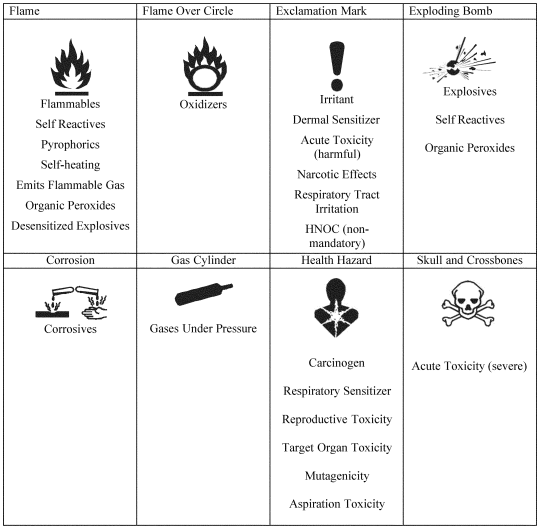
Figure C.2—Exclamation Mark Pictogram
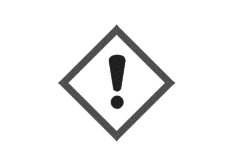
C.2.3.3 The exclamation mark pictogram is permitted (but not required) for HNOCs as long as the words “Hazard Not Otherwise Classified” or the letters “HNOC” appear below the pictogram.
C.2.3.4 Pictograms may only appear once on a label. If multiple hazards require the use of the same pictogram, it may not appear a second time on the label.
C.2.4 Precautionary Statement Text
C.2.4.1 There are four types of precautionary statements presented, “prevention,” “response,” “storage,” and “disposal.” The core part of the precautionary statement is presented in bold print. This is the text, except as otherwise specified, that shall appear on the label. Where additional information is required, it is indicated in plain text.
C.2.4.2 When a backslash or diagonal mark (/) appears in the precautionary statement text, it indicates that a choice has to be made between the separated phrases. In such cases, the chemical manufacturer, importer, or responsible party can choose the most appropriate phrase(s). For example, “Wear protective gloves/protective clothing/eye protection/face protection” could read “wear eye protection”.
C.2.4.3 When three full stops (. . .) appear in the precautionary statement text, they indicate that all applicable conditions are not listed. For example, in “Use explosion-proof electrical/ventilating/lighting/. . ./equipment”, the use of “. . .” indicates that other equipment may need to be specified. In such cases, the chemical manufacturer, importer, or responsible party can choose the other conditions to be specified.
C.2.4.4 When text in italics is used in a precautionary statement, this indicates specific conditions applying to the use or allocation of the precautionary statement. For example, “Use explosion-proof electrical/ventilating/lighting/. . ./equipment” is only required for flammable solids “if dust clouds can occur”. Text in italics is intended to be an explanatory, conditional note and is not intended to appear on the label.
C.2.4.5 Where square brackets ([ ]) appear around text in a precautionary statement, this indicates that the text in square brackets is not appropriate in every case and should be used only in certain circumstances. In these cases, conditions for use explaining when the text should be used are provided. For example, one precautionary statement states: “[In case of inadequate ventilation] wear respiratory protection.” This statement is given with the condition for use “- text in square brackets may be used if additional information is provided with the chemical at the point of use that explains what type of ventilation would be adequate for safe use”. This means that, if additional information is provided with the chemical explaining what type of ventilation would be adequate for safe use, the text in square brackets should be used and the statement would read: “In case of inadequate ventilation wear respiratory protection.” However, if the chemical is supplied without such ventilation information, the text in square brackets should not be used, and the precautionary statement should read: “Wear respiratory protection.”
C.2.4.6 Precautionary statements may be combined or consolidated to save label space and improve readability. For example, “Keep away from heat, sparks and open flame,” “Store in a well-ventilated place” and “Keep cool” can be combined to read “Keep away from heat, sparks and open flame and store in a cool, well-ventilated place.”
C.2.4.7 Precautionary statements may incorporate minor textual variations from the text prescribed in this Appendix if these variations assist in communicating safety information (e.g., spelling variations, synonyms or other equivalent terms) and the safety advice is not diluted or compromised. Any variations must be used consistently on the label and the safety data sheet.
C.2.4.8 In most cases, the precautionary statements are independent (e.g., the phrases for explosives hazards do not modify those related to certain health hazards, and products that are classified for both hazard classes shall bear appropriate precautionary statements for both). Where a chemical is classified for a number of hazards, and the precautionary statements are similar, the most stringent shall be included on the label (this will be applicable mainly to preventive measures).
C.2.4.9 If the chemical manufacturer, importer, or responsible party can demonstrate that a precautionary statement is inappropriate to a specific substance or mixture, the precautionary statement may be omitted from the label.
C.2.4.10 Where a substance or mixture is classified for a number of health hazards, this may trigger multiple precautionary statements relating to medical response, e.g., calling a poison center/doctor/. . . and getting medical advice/attention.
In general, the following principles should be applied:
(a) Where the classification of a substance or mixture triggers several different precautionary statements, a system of prioritization should be applied. If the same medical response statement is triggered multiple times, the label need only include one precautionary statement reflecting the response at the highest level with the greatest urgency, which should always be combined with at least one route of exposure or symptom “IF” statement.
(b) Routes of exposure, including “IF exposed or concerned,” may be combined when triggered with a medical response statement. If the response statement is triggered with three or more routes of exposure, “IF exposed or concerned” may be used. However, relevant “IF” statements describing symptoms must be included in full. If a route of exposure is triggered multiple times, it need only be included once.
(c) This does not apply to “Get medical advice/attention if you feel unwell” or “Get immediate medical advice/attention” when they are combined with an “If” statement and must appear without prioritization.
C.3 Supplementary Hazard Information
C.3.1 To ensure that non-standardized information does not lead to unnecessarily wide variation or undermine the required information, supplementary information on the label is limited to when it provides further detail and does not contradict or cast doubt on the validity of the standardized hazard information.
C.3.2 Where the chemical manufacturer, importer, or distributor chooses to add supplementary information on the label, the placement of supplemental information shall not impede identification of information required by this section.
C.3.3 Where an ingredient with unknown acute toxicity is used in a mixture at a concentration ≥1%, and the mixture is not classified based on testing of the mixture as a whole, a statement that X% of the mixture consists of ingredient(s) of unknown acute toxicity (oral/dermal/inhalation) is required on the label and safety data sheet.
C.4 Requirements for Signal Words, Hazard Statements, Pictograms, and Precautionary Statements
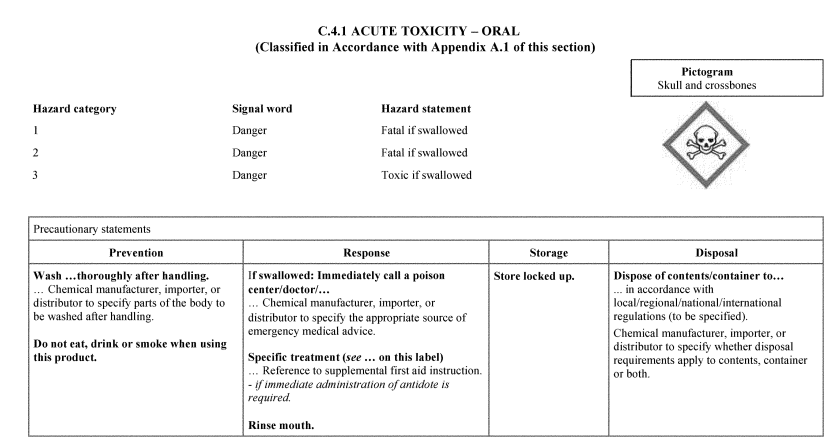

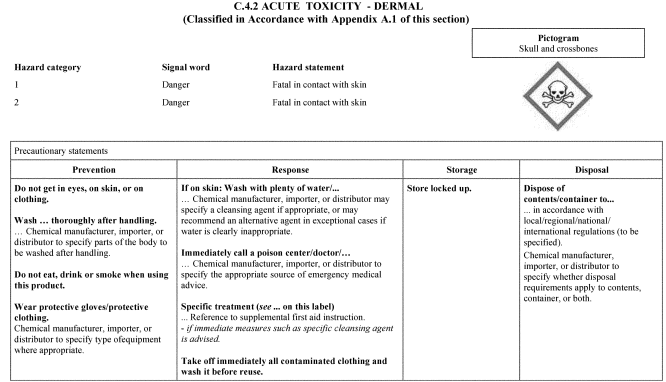
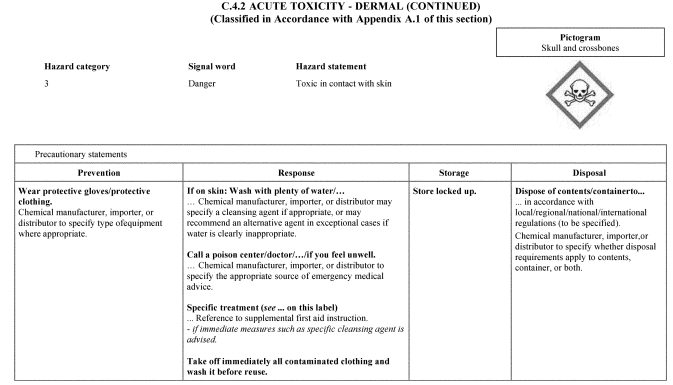
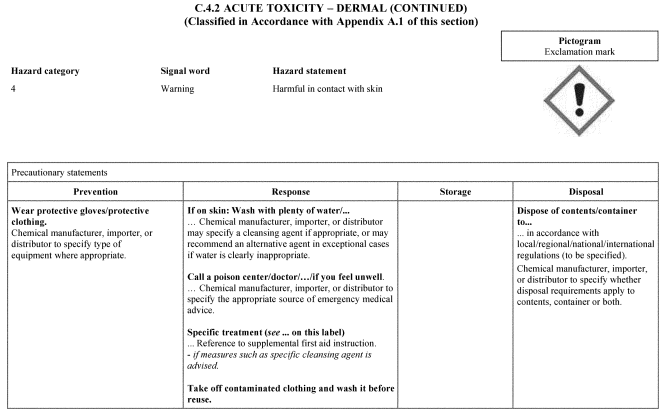
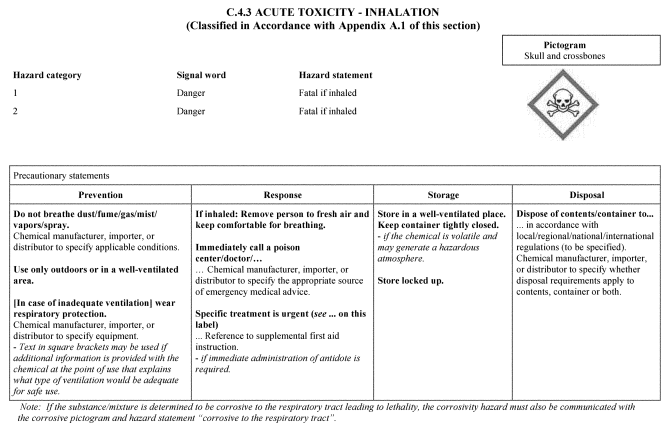

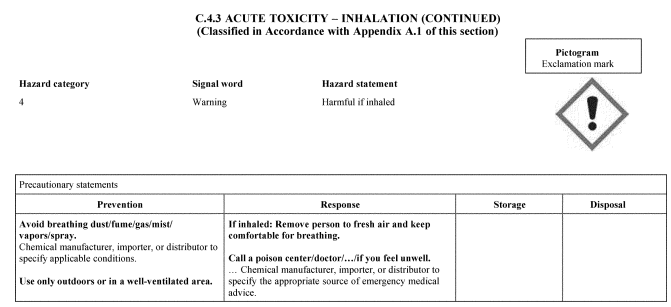
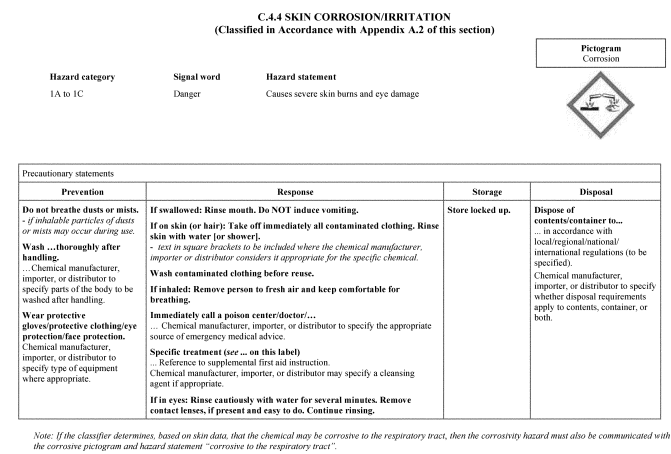

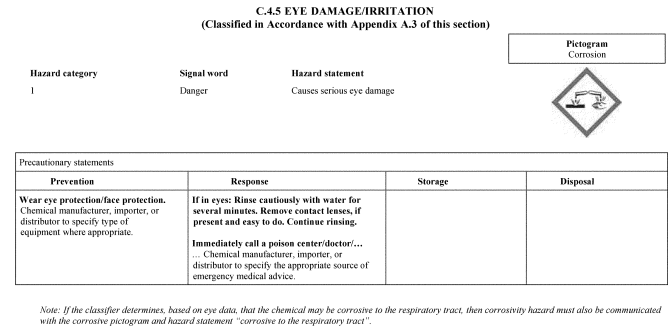
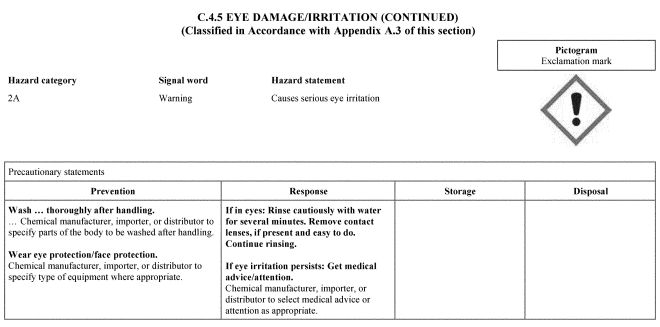
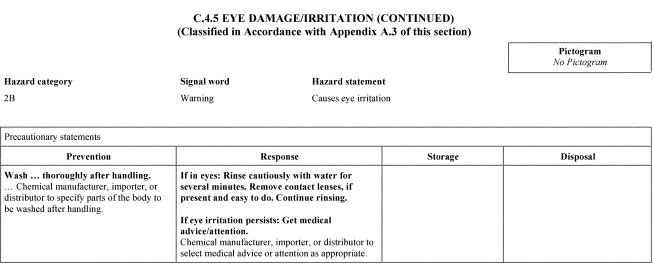
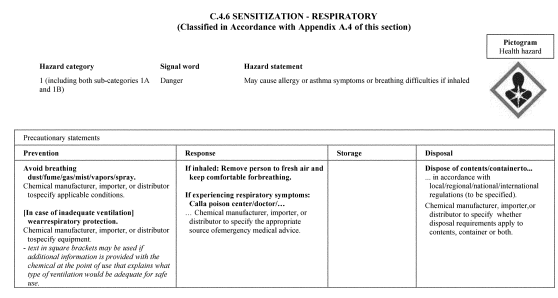

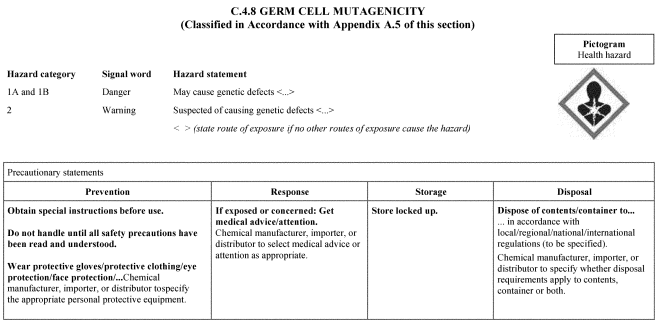
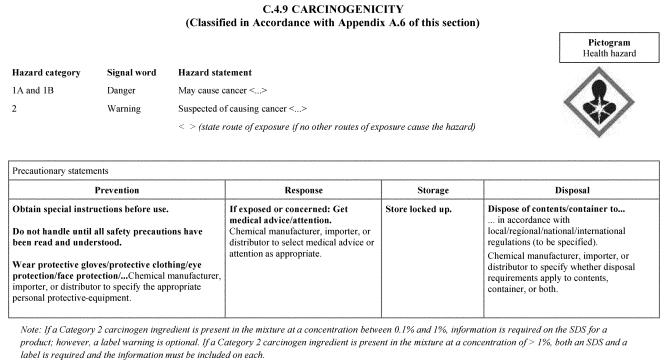
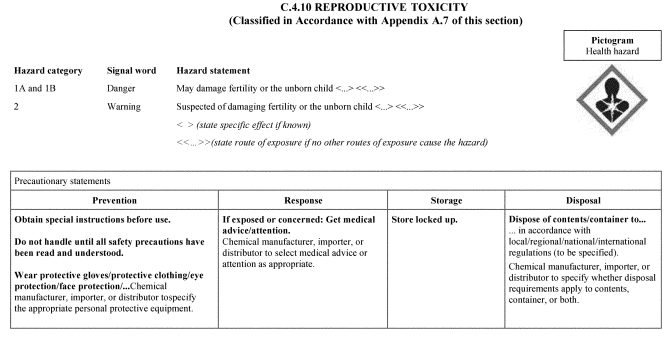
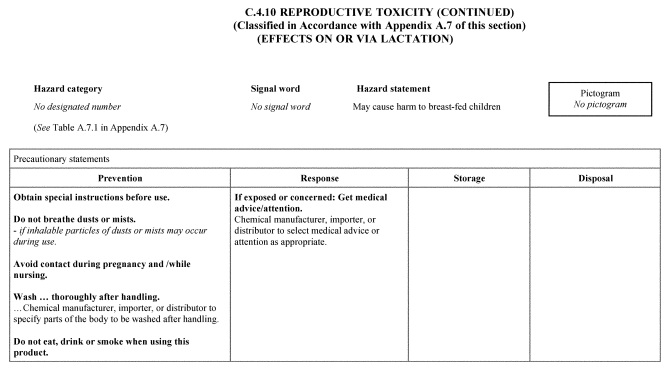
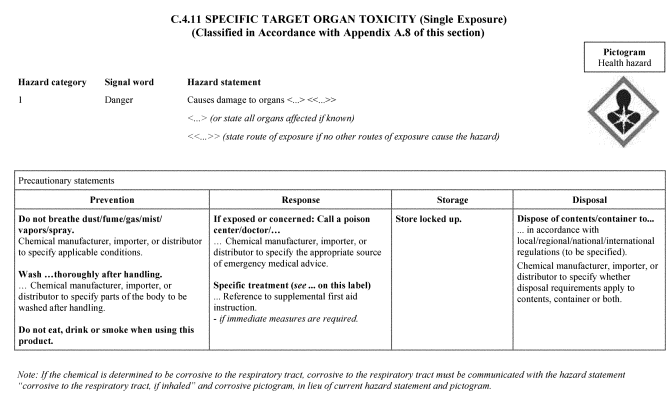
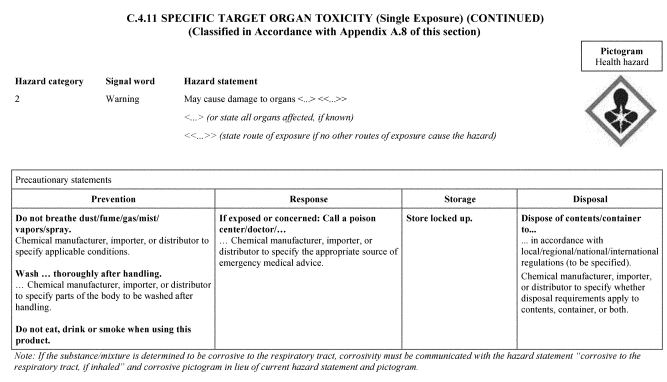
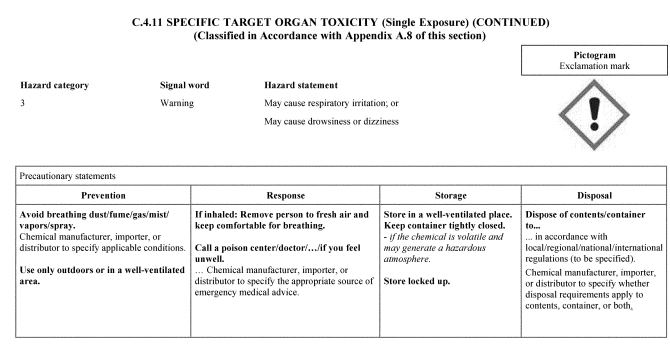

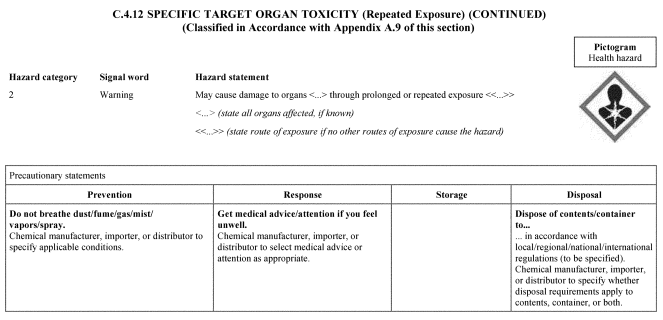
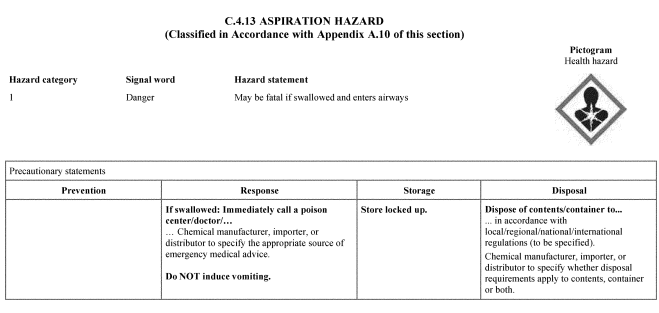
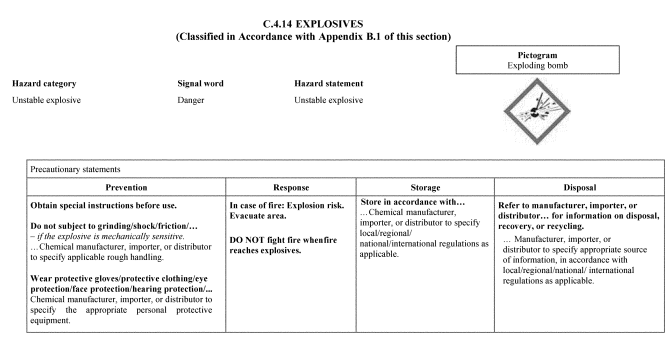
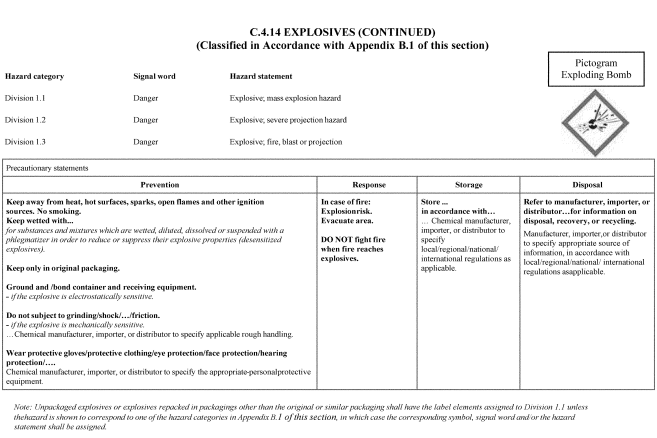
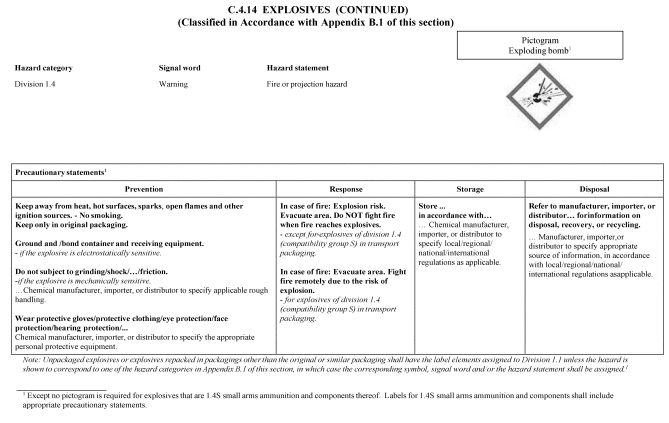

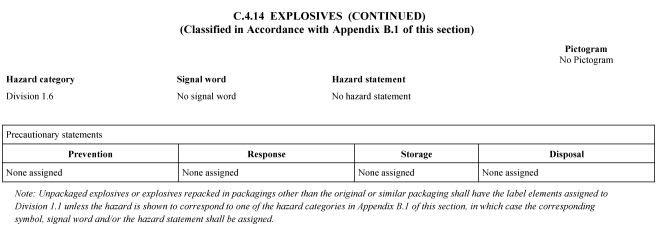

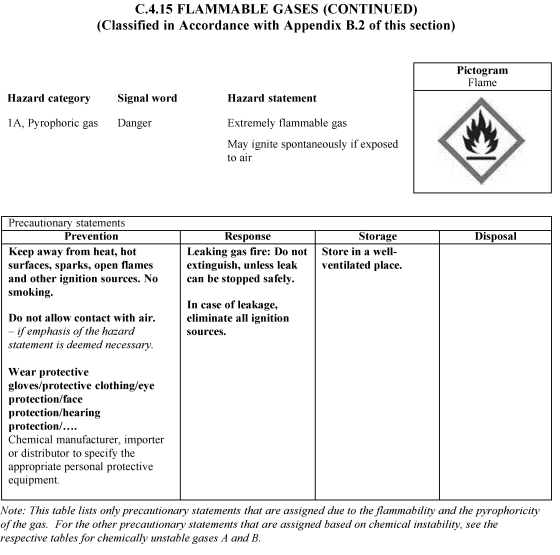

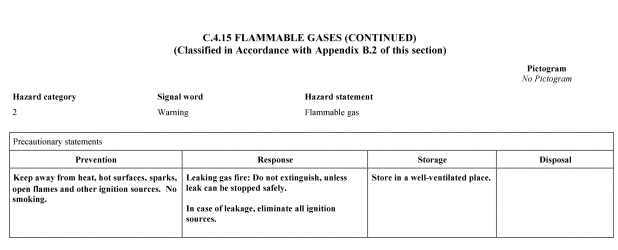
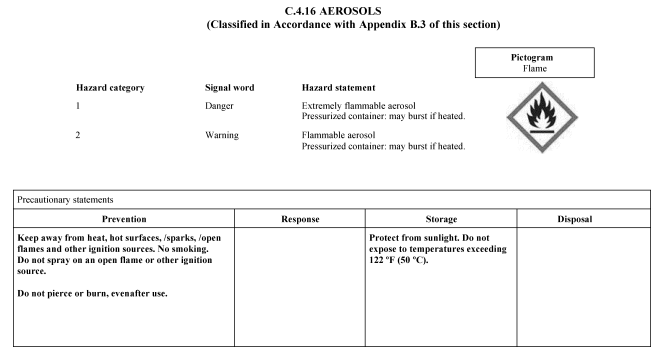
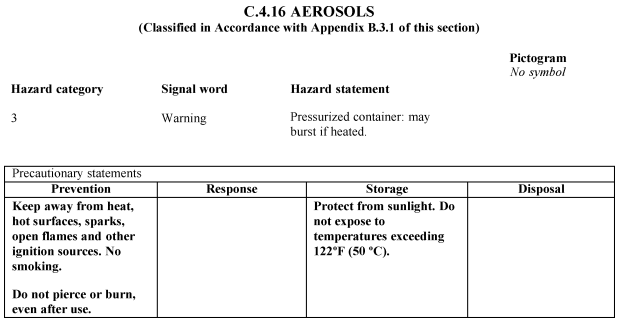
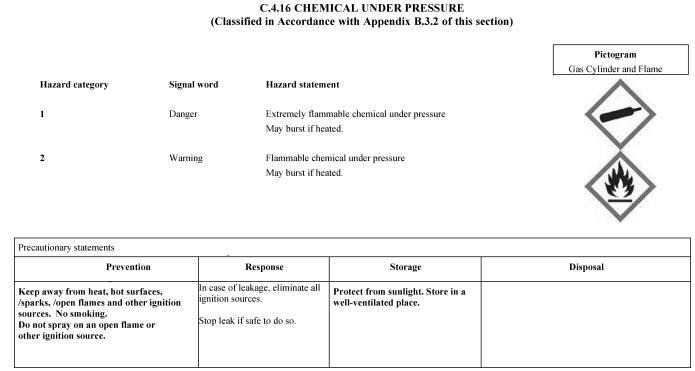
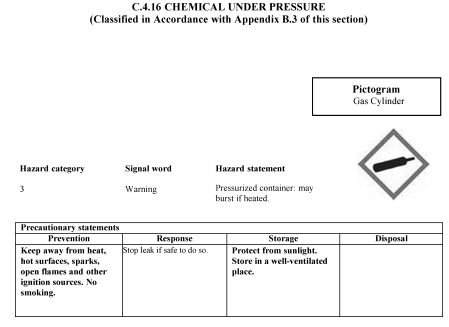
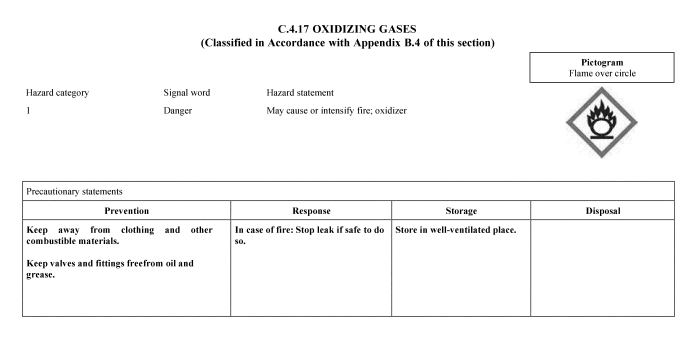


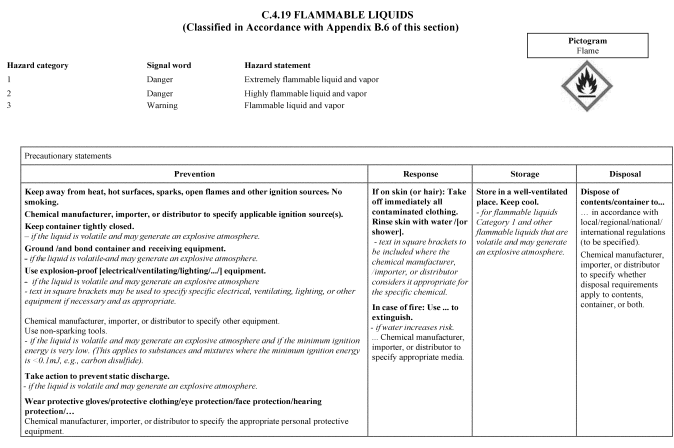
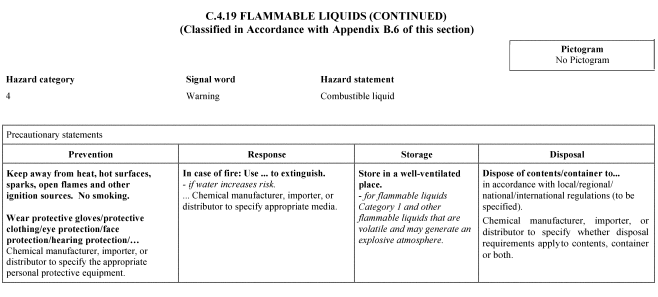
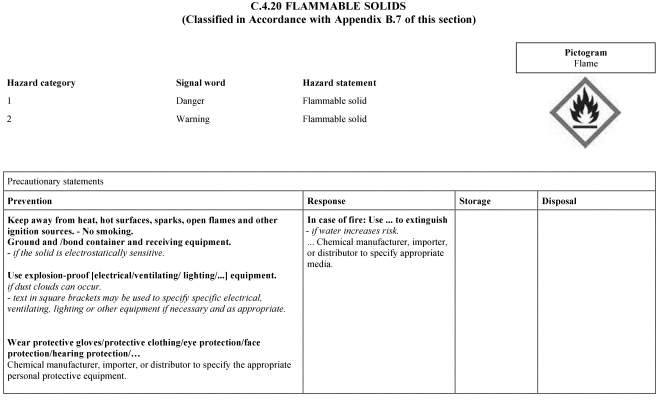
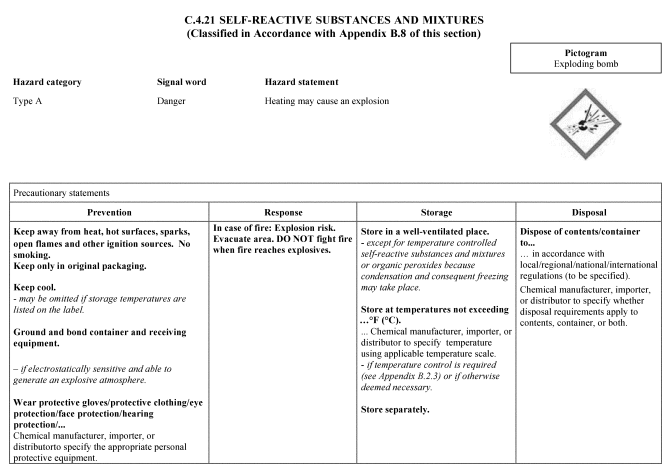
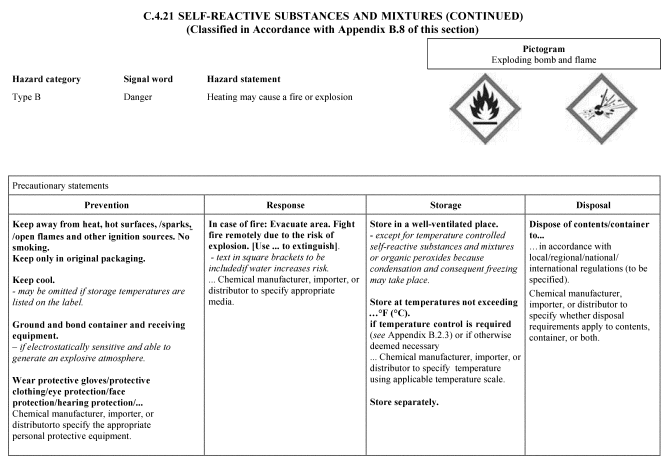
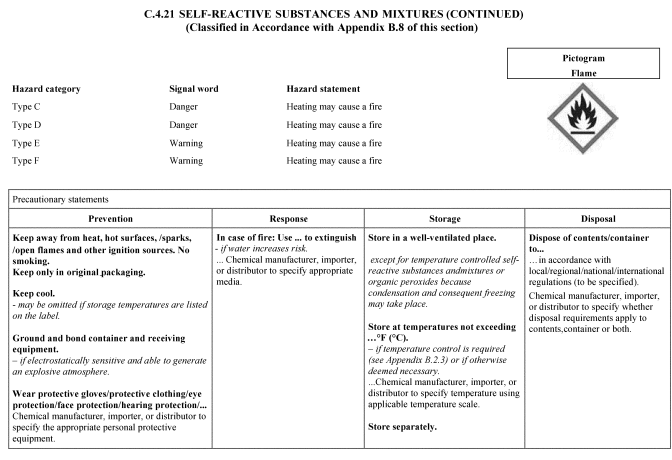

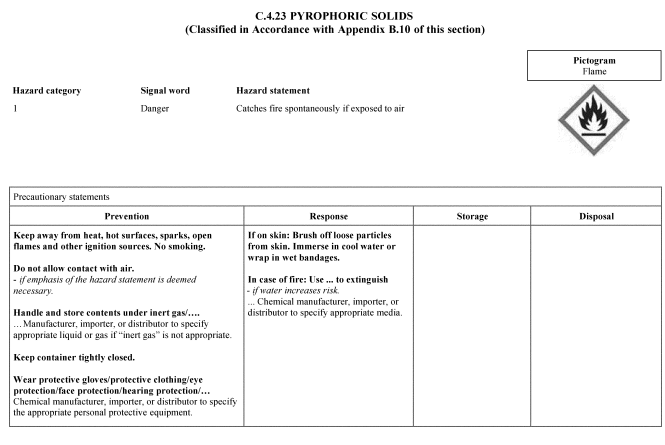
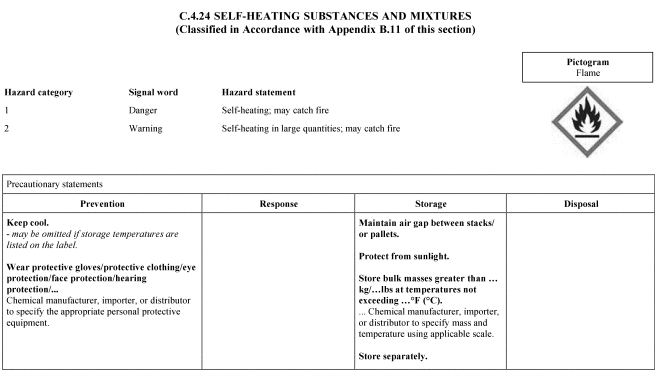
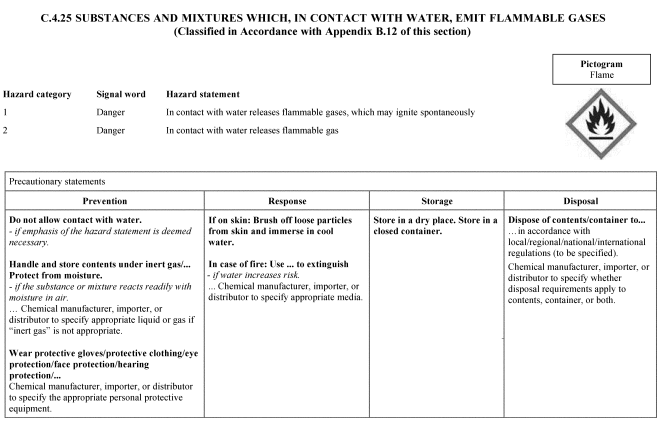
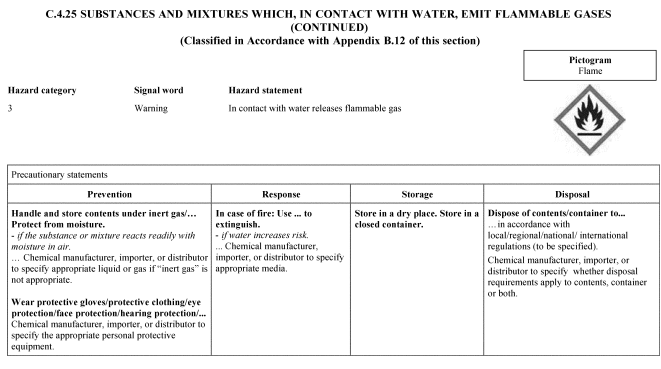
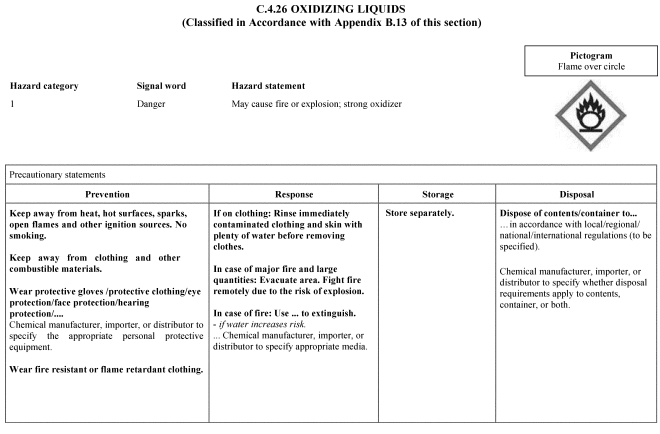
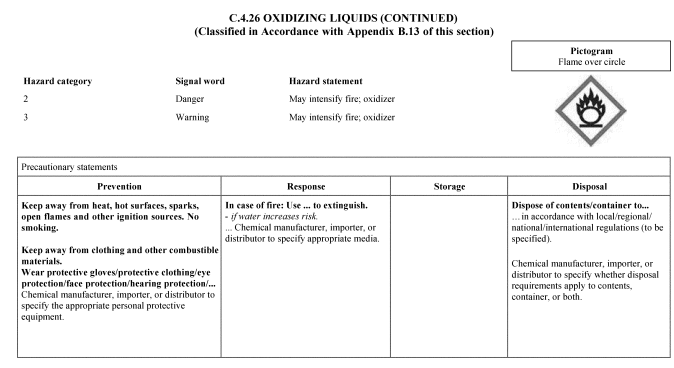
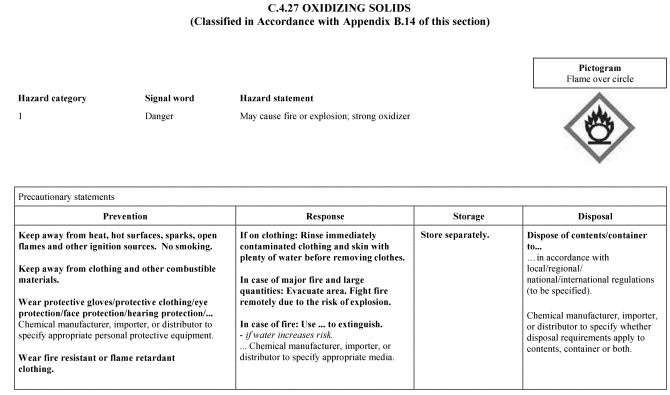
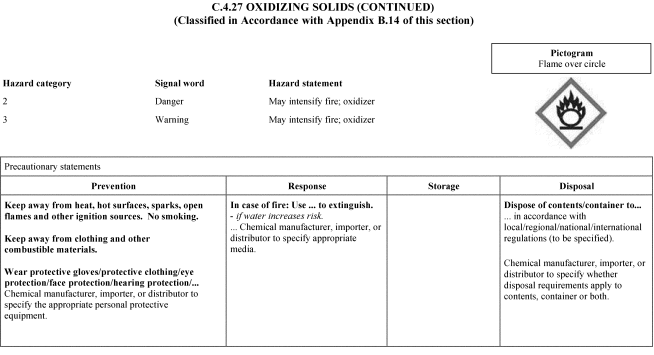
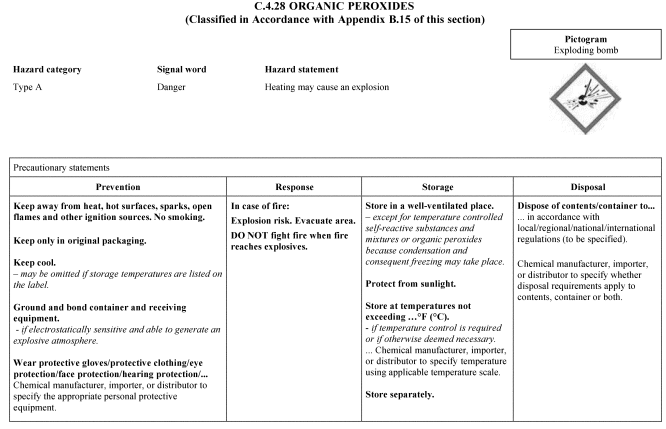
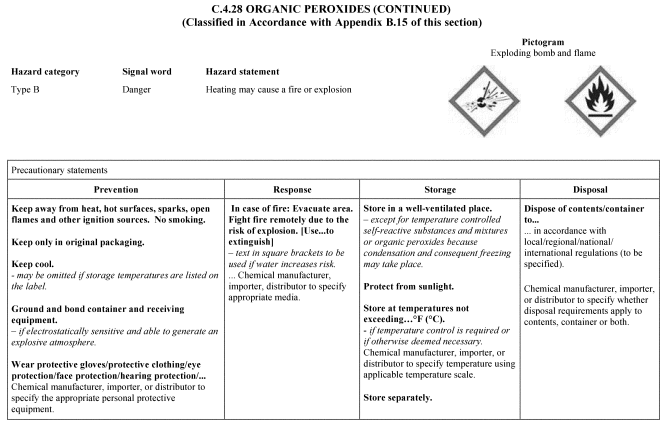
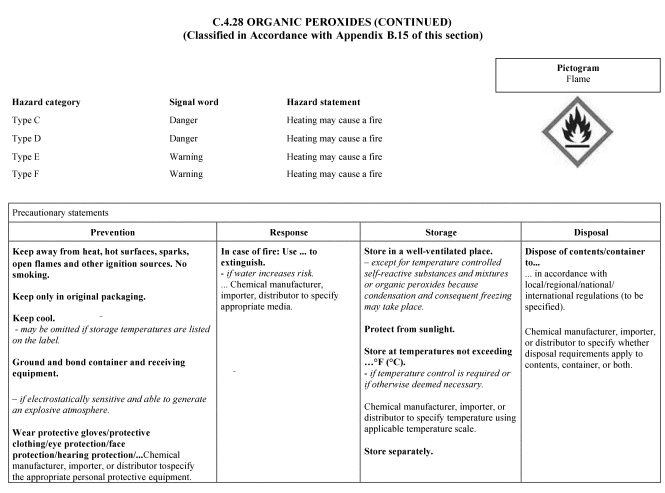
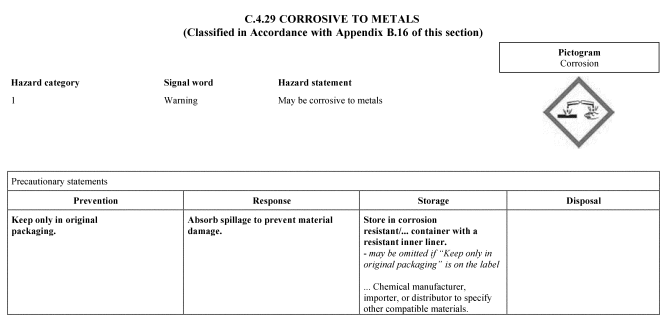
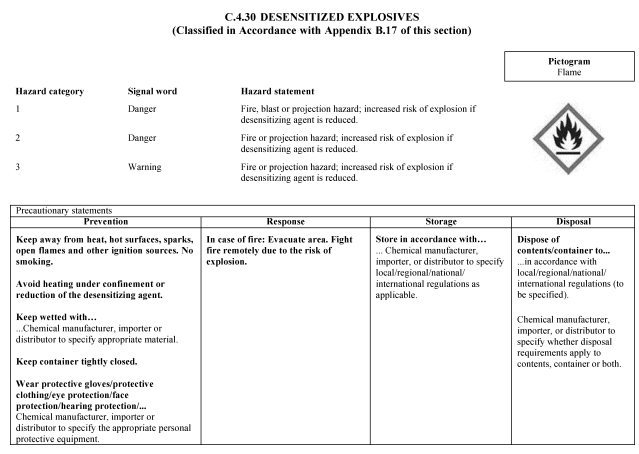
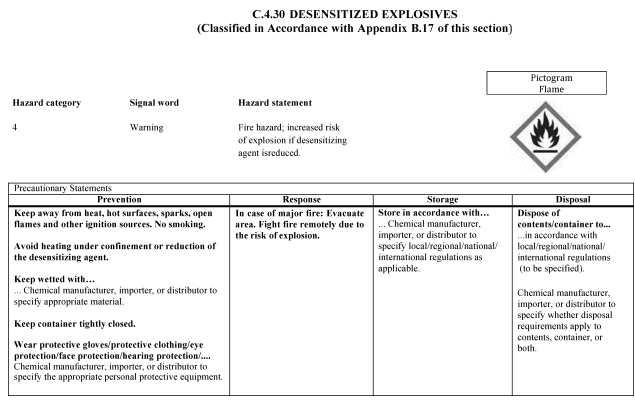
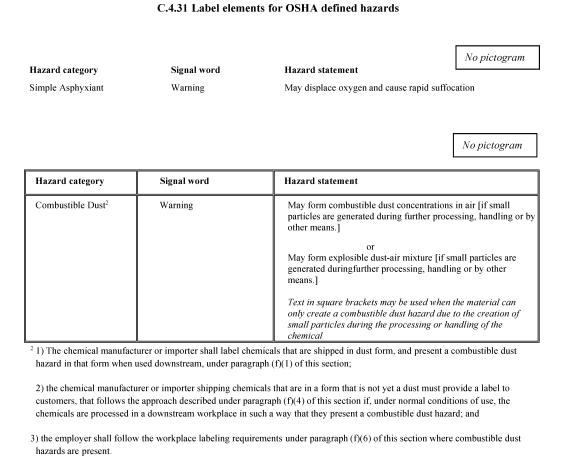
Appendix D to §1910.1200—Safety Data Sheets (Mandatory)
A safety data sheet (SDS) shall include the information specified in Table D.1 under the section number and heading indicated for sections 1-11 and 16. While each section of the SDS must contain all of the specified information, preparers of safety data sheets are not required to present the information in any particular order within each section. If no relevant information is found for any given subheading within a section, the SDS shall clearly indicate that no applicable information is available. Sections 12-15 may be included in the SDS, but are not mandatory.
| Headings | Subheadings |
|---|---|
| 1. Identification | (a) Product identifier used on the label; (b) Other means of identification; (c) Recommended use of the chemical and restrictions on use; (d) Name, U.S. address, and U.S. telephone number of the chemical manufacturer, importer, or other responsible party; (e) Emergency phone number. |
| 2. Hazard Identification | (a) Classification of the chemical in accordance with paragraph (d)(1)(i) of §1910.1200; (b) Signal word, hazard statement(s), symbol(s) and precautionary statement(s) in accordance with paragraph (f) of §1910.1200. (Hazard symbols may be provided as graphical reproductions in black and white or the name of the symbol, e.g., flame, skull and crossbones); (c) Hazards classified under paragraph (d)(1)(ii) of §1910.12000; (d) Describe any hazards not otherwise classified that have been identified during the classification process; (e) Where an ingredient with unknown acute toxicity is used in a mixture at a concentration ≥1% and the mixture is not classified based on testing of the mixture as a whole, a statement that X% of the mixture consists of ingredient(s) of unknown acute toxicity is required. |
| 3. Composition/information on ingredients | Except as provided for in paragraph (i) of §1910.1200 on trade secrets: For Substances (a) Chemical name; (b) Common name and synonyms; (c) CAS number and other unique identifiers; (d) Impurities and stabilizing additives (constituents) which are themselves classified and which contribute to the classification of the substance. For Mixtures In addition to the information required for substances: (a) The chemical name, CAS number or other unique identifier, and concentration (exact percentage) or concentration ranges of all ingredients which are classified as health hazards in accordance with paragraph (d) of §1910.1200 and
Note: When CAS number is not available or claimed as a trade secret, the preparer must indicate the source of unique identifier. (b) The concentration (exact percentage) shall be specified unless a trade secret claim is made in accordance with paragraph (i) of §1910.1200, when there is batch-to-batch variability in the production of a mixture, or for a group of substantially similar mixtures (See A.0.5.1.2) with similar chem For All Chemicals Where a Trade Secret is Claimed Where a trade secret is claimed in accordance with paragraph (i) of §1910.1200, a statement that the specific chemical identity, and/or concentration (exact or range) of the composition has been withheld as a trade secret is required. When the concentration or concentration range is withheld as a trade secret, the prescribed concentration ranges used in §1910.1200(i)(1)(iv)-(vi) must be used. |
| 4. First aid measures |
(a) Description of necessary measures, subdivided according to the different routes of exposure,
i.e.,
inhalation, skin and eye contact, and ingestion;
(b) Most important symptoms/effects, acute and delayed. (c) Indication of immediate medical attention and special treatment needed, if necessary. |
| 5. Fire-fighting measures | (a) Suitable (and unsuitable) extinguishing media. (b) Specific hazards arising from the chemical (e.g., nature of any hazardous combustion products). (c) Special protective equipment and precautions for fire-fighters. |
| 6. Accidental release measures | (a) Personal precautions, protective equipment, and emergency procedures. (b) Methods and materials for containment and cleaning up. |
| 7. Handling and storage | (a) Precautions for safe handling. (b) Conditions for safe storage, including any incompatibilities. |
| 8. Exposure controls/personal protection | (a) For all ingredients or constituents listed in Section 3, the OSHA permissible exposure limit (PEL), American Conference of Governmental Industrial Hygienists (ACGIH) Threshold Limit Value (TLV), and any other exposure limit or range used or recommended by the chemical manufacturer, importer, or employer preparing the safety data sheet, where available. (b) Appropriate engineering controls. (c) Individual protection measures, such as personal protective equipment. |
| 9. Physical and chemical properties † | (a) Physical state. (b) Color. (c) Odor (includes odor threshold). (d) Melting point/freezing point. (e) Boiling point (or initial boiling point or boiling range). (f) Flammability. (g) Lower and upper explosion limit/flammability limit. (h) Flash point. (i) Auto-ignition temperature. (j) Decomposition temperature. (k) pH. (l) Kinematic viscosity. (m) Solubility. (n) Partition coefficient n-octanol/water (log value). (o) Vapor pressure (includes evaporation rate). (p) Density and/or relative density. (q) Relative vapor density. (r) Particle characteristics. |
| 10. Stability and reactivity | (a) Reactivity; (b) Chemical stability; (c) Possibility of hazardous reactions, including those associated with foreseeable emergencies; (d) Conditions to avoid (e.g., static discharge, shock, or vibration); (e) Incompatible materials; (f) Hazardous decomposition products. |
| 11. Toxicological information | Description of the various toxicological (health) effects and the available data used to identify those effects, including: (a) Information on the likely routes of exposure (inhalation, ingestion, skin, and eye contact); (b) Symptoms related to the physical, chemical, and toxicological characteristics; (c) Delayed and immediate effects and also chronic effects from short- and long-term exposure; (d) Numerical measures of toxicity (such as acute toxicity estimates); (e) Interactive effects; information on interactions should be included if relevant and readily available; (f) Whether the hazardous chemical is listed in the National Toxicology Program (NTP) Report on Carcinogens (latest edition) or has been found to be a potential carcinogen in the International Agency for Research on Cancer (IARC) Monographs (latest edition), or by OSHA. (g) When specific chemical data or information is not available, the preparer must indicate if alternative information is used and the method used to derive the information (e.g., where the preparer is using information from a class of chemicals rather than the exact chemical in question and using SAR to derive the toxicological information). |
| 12. Ecological information (Non-mandatory) | (a) Ecotoxicity (aquatic and terrestrial, where available); (b) Persistence and degradability; (c) Bioaccumulative potential; (d) Mobility in soil; (e) Other adverse effects (such as hazardous to the ozone layer). |
| 13. Disposal considerations (Non-mandatory) | Description of waste residues and information on their safe handling and methods of disposal, including the disposal of any contaminated packaging. |
| 14. Transport information (Non-mandatory) | (a) UN number; (b) UN proper shipping name; (c) Transport hazard class(es); (d) Packing group, if applicable; (e) Environmental hazards (e.g., Marine pollutant (Yes/No)); (f) Transport in bulk (according to IMO instruments (g) Special precautions which a user needs to be aware of, or needs to comply with, in connection with transport or conveyance either within or outside their premises |
| 15. Regulatory information (Non-mandatory) | Safety, health and environmental regulations specific for the product in question. |
| 16. Other information, including date of preparation or last revision | The date of preparation of the SDS or the last change to it. |
| † Note: To determine the appropriate flammable liquid storage container size and type, the boiling point shall be determined by methods specified under §1910.106(a)(5) and then listed on the SDS. In addition, the manufacturer, importer, and distributor shall clearly note in sections 7 and 9 of the SDS if an alternate calculation was used for storage purposes and the classification for storage differs from the classification listed in section 2 of the SDS. | |








































